Clifford Browder's Blog, page 40
July 5, 2015
187. Apothecaries and the Charms of Belladonna
Big wide-mouthed apothecary jars of another time, with glass stoppers and bold labels reading
CARDAMOMCAMPHORBELLADONNAASAFOETIDABENZOIN
A host of smaller brown bottles with similar labels on a table, perhaps a medicine chest, that has seen better days. An outiszed mortar and pestle, and a number of glass tubes and receptacles probably used to distill medications. Metal canisters labeled ALUM and, intriguingly,
CHOICEBOTANIC DRUGSPRESSED
 Apothecary jars
Apothecary jarsIn a protective glass case, antique scales. What looks to be an old radio, and another large object I can’t identify. And, as the centerpiece of the display, a huge prescription book, the edges of its pages not yellow but brown with age, open to scores of prescriptions scribbled in an indecipherable hand, but whose year, if you squint and look closely, can be made out: 1917. And in bold print at the top of each prescription, FRANK AVIGNONE & CO.
Such is the current window display at Grove Drugs at 302 West 12th Street, but a couple of blocks from my apartment, one of the few independent pharmacies left in the West Village, where chain stores dominate. Grove’s window displays are always of interest, but this one fascinated me at first glance, since it took me back to the apothecary shops of the nineteenth and early twentieth century. When I asked inside about the source of these relics from the past, I was told that they had belonged to a pharmacy at Bleecker Street and Sixth Avenue, now closed, that had gone back a century or more.
(Note: The word “apothecary” can designate either the shop or the medicine compounder working in the shop. To avoid confusion, I will use “apothecary shop” for the shop.)
I soon identified the pharmacy in question as Avignone Chemists, formerly Avignone Pharmacy, which had been at Bleecker and Sixth Avenue since 1929. But the pharmacy traces its origins back to 1832, when its antecedent was founded as Stock Pharmacy at 59 MacDougal Street, at the corner of Houston, one of the oldest apothecary shops in the United States. In 1898 Stock Pharmacy was bought by Frank Avignone, an Italian immigrant, who changed the name to Avignone Pharmacy. When the building was demolished in 1929 for the widening of Houston Street, Frank and Horatio Avignone built a two-story brick structure at 281 Sixth Avenue/226 Bleecker Street and moved their pharmacy in. Frank Avignone’s son Carlo took over the business in 1956 and in 1974 sold it to the Grassi family, who were joined by Abe Lerner in 1991.
(A parenthesis to the above: Wikipedia calls Avignone the oldest apothecary shop in the U.S., but that honor is also claimed by another Village independent, C.O. Bigelow’s, at 414 Sixth Avenue, just above West 8th Street, which dates its founding to 1838. This assertion relies on affiliating Bigelow’s with its predecessor, the Village Apothecary Shop, which was indeed established at a nearby location in 1838 by Dr. Galen Hunter. Clarence Otis Bigelow, an employee of Dr. Hunter’s successor, bought the shop from his boss in 1880, renamed it after himself, then built the present building and moved into it in 1902. Which of these claims, if either, is valid, I leave to the viewer. I will only observe that an apothecary shop opened in Williamsburg, Virginia, in 1759, a slightly earlier date than either date cited by these pharmacies.)
When Abe Lerner and his co-owners renovated the building in 2007, they changed the name to Avignone Chemists. The blond wood-frame exterior and double-door entrance, topped by a striped awning and an illuminated green cross indicating a pharmacy, gave it a welcoming warmth such as few chain pharmacies can boast. In the front window and on display inside were the very items of which I saw a selection in Grove Drug’s window: old apothecary jars, mortars and pestles, old clocks and radios and cameras, and several massive prescription books, all of which had been discovered in the basement during the 2007 renovation.
The end for Avignone came earlier this year, when the building was sold and the new owner, Force Capital Management, a New York-based hedge fund founded in 2002, tripled the pharmacy’s rent to $60,000, which Abe Lerner could not pay. Lerner, now 62, choked up at the thought of closing on April 30. “I’ve spent half my life here,” he told an interviewer. “I’ve known many of these people for thirty years; I’ve seen a lot of kids grow up. A lot of these people have become friends -- they’re not just customers, they’re friends.” The whole neighborhood mourns the pharmacy’s loss as well, for it had become a neighborhood hangout, a place to come and chat with friends. Yet another example of how soaring commercial rents, which are not controlled, can gut a neighborhood, driving out mom-and-pop stores that have been ˆn the neighborhood for years.
I walked by the old pharmacy at the corner of Sixth Avenue and Bleecker Street a couple of months after the closing, and there it was, a two-story building dwarfed by its neighbors, with “AVIGNONE CHEMISTS” above the striped awning, and on the awning “est. 1932,” which might be considered a bit of a stretch, since that date applies to a different pharmacy with a different name at a different address. The double door is padlocked, and in the window is a big sign, RETAIL AVAILABLE, indicating that no new tenant has as yet been found. And if one enters Winston Churchill Square, the small fenced park adjoining, high up on the building’s brick wall you can still see a faded sign probably dating from the 1950s:
AVIGNONE PHARMACYPRESCRIPTIONS
And what about Grove Drugs, whose display set me off on this investigation? It’s a small pharmacy whom an online Yelp reviewer describes as “a fine, friendly, old-fashioned neighborhood pharmacy.” True enough. Like Avignone Chemists, Grove relishes its status as an independent pharmacy competing with the chain stores: David against Goliath, the little guy against the multiple massive presence of CVS Pharmacy, Duane Reade, and Rite-Aid. Being small, it can offer only the basic basics, as compared with the Rite-Aid on Hudson Street, which has five times the floor space and offers a bewildering variety of products, including children’s toys, seasonal greeting cards, and junk-food snacks.
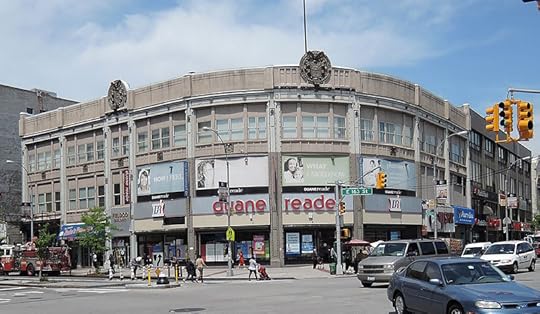 Not exactly a friendly neighborhood pharmacy.
Not exactly a friendly neighborhood pharmacy.Jim.henderson
Rite-Aid entices me with a so-called Wellness Card offering a 20% discount – not to be sniffed at -- on the first Wednesday of every month, but I can wander its many aisles without ever encountering an employee. If I go to Grove, at the counter in back there’s always someone to point me to whatever I need. Also, I like the plain-Jane simplicity of “Grove Drugs,” as opposed to “Village Apothecary,” another West Village independent, and yes, even “Avignone Chemists,” which to my mind hint of pretension. And there’s something charmingly quaint about Grove’s closing on Sunday and holidays (“Please anticipate your needs”), and at 7:30 p.m. on weekdays, while the chain stores are open 24/7. As for its seasonal window displays – an animated wintry panorama with a miniature toy factory, carolers, and skaters at Christmas, bunnies at Easter, and skulls and bats and huge spiders and their webs at Halloween – they are the most entertaining in the entire West Village.
And why does the pharmacy at 202 West 12thStreet bear the name “Grove Drugs”? Because for many years the owner, John Duffy, operated another West Village independent, Grove Pharmacy, at 261 Seventh Avenue, on the corner of Grove Street, until forced out by his landlord in 2006. And why did the artifacts of the Avignone Chemists come to Grove Drugs? Because John Duffy was part owner of Avignone as well. So Grove Drugs must be his last stand against greedy landlords and invasive chain stores. I wish him well.
But I’m not quite done with the fascinating relics in Grove’s window, for to fully grasp their significance you have to understand the role of the old-time apothecary, a profession dating back to antiquity and differing from that of today’s pharmacist. Pharmacies today are well stocked with over-the-counter products mass-produced by pharmaceutical companies; they come in standardized dosages formulated to meet the needs of the average user. But throughout the eighteenth and nineteenth centuries the apothecary, the predecessor of today’s pharmacist, created medications individually for each customer, who received a product that was, so to speak, tailor-made. In theory, the apothecary had some knowledge of chemistry, but at first there was little regulation.
 A 17th-century German apothecary.
A 17th-century German apothecary.Welcome Library
The objects on display in Grove’s window hearken back to this early period when the apothecary made compounds from ingredients like those in the bottles and jars displayed, grinding them to a powder with a mortar and pestle, weighing them with scales to get the right measure, or distilling them with the glass paraphernalia seen in the window to make a tincture, lotion, volatile oil, or perfume. The one thing typical of the old apothecary shops that the display can’t reproduce was the aroma, a strange mix of spices, perfumes, camphor, castor oil, and other soothing or astringent remedies. Mercifully absent as well is a jar with live leeches, since by the late nineteenth century the time-honored practice of bloodletting, which probably killed more patients than it benefited, had been discontinued.
The apothecary’s remedies were derived sometimes from folk medicine and sometimes from published compendiums. Chalk was used for heartburn, calamine for skin irritations, spearmint for stomachache, rose petals steeped in vinegar for headaches, and cinchona bark for fevers. Often serving as a physician, the apothecary applied garlic poultices to sores and wounds and rheumatic limbs. Laudanum, or opium tincture, was employed freely, with little regard to its addictiveness, to treat ulcers, bruises, and inflamed joints, and was taken internally to alleviate pain. Little wonder that well-bred ladies became addicted, like Eugene O’Neill’s mother, as memorably portrayed in his play A Long Day’s Journey into Night. But if some of these remedies seem fanciful or naïve or even dangerous, others are known to work even today, as for example witch hazel for hemorrhoids.
But medicines weren’t the only products of an apothecary shop. Rose petals, jasmine, and gardenias might be distilled to create perfumes, and lavender, honey, and beeswax were compounded to create face creams to enhance the milk-white complexion desired by ladies, in a time when the sun tan so prized today characterized a market woman or farmer’s wife, lower-caste females who had to work outdoors for a living. (The prime defense against the sun was, of course, the parasol, without which no lady ventured outdoors.) A fragrant pomade for the hair was made of soft beef fat, essence of violets, jasmine, and oil of bergamot, and cosmetic gloves rubbed on the inside with spermaceti, balsam of Peru, and oil of nutmeg and cassia were worn by ladies in bed at night, to soften and bleach the hands, and to prevent chapped hands and chilblains.
But the apothecary’s products were not without risks. Face powders might contain arsenic; belladonna, a known poison, was used to widen the pupils of the eyes; and bleaching agents included ammonia, quicksilver, spirits of turpentine, and tar. All of which suggests a less than comprehensive grasp of basic chemistry. And in the flavored syrups and sodas devised to mask the unpleasant medicinal taste of prescriptions, two common ingredients were cocaine and alcohol, which must have induced in the patients an unwonted buoyancy of spirits.
 Marketed especially for children, no less.
Marketed especially for children, no less.Also available in an apothecary shop were cooking spices, candles, soap, salad oil, toothbrushes, combs, cigars, and tobacco, so that it in some ways approximated the general store of the time. And in the eighteenth century American apothecaries also made house calls, trained apprentices, performed surgery, and acted as male midwives.
 Belladonna, which appears in the Grove Drugs window display, merits a mention of its own. The name means “beautiful lady” in Italian, for the juice of its berry was used by Italian women in the Renaissance to dilate the pupils of their eyes so as to appear more seductive. A sinister and risky beauty resulted, for this small shrub that grows in many parts of the world, including North America, produces leaves and berries that are extremely toxic, as indicated by its other common name, “deadly nightshade.” It has long been known as a medicine, poison, and cosmetic. Nineteenth-century medicine used it to alleviate pain, relax the muscles, and treat inflammation, and it is still in use today as a sedative to stop bronchial spasms, and also to treat Parkinson’s, rheumatism, and other ailments.
Belladonna, which appears in the Grove Drugs window display, merits a mention of its own. The name means “beautiful lady” in Italian, for the juice of its berry was used by Italian women in the Renaissance to dilate the pupils of their eyes so as to appear more seductive. A sinister and risky beauty resulted, for this small shrub that grows in many parts of the world, including North America, produces leaves and berries that are extremely toxic, as indicated by its other common name, “deadly nightshade.” It has long been known as a medicine, poison, and cosmetic. Nineteenth-century medicine used it to alleviate pain, relax the muscles, and treat inflammation, and it is still in use today as a sedative to stop bronchial spasms, and also to treat Parkinson’s, rheumatism, and other ailments.  A witches' sabbath, Goya version.
A witches' sabbath, Goya version. Satan often appeared as a goat. Belladonna figures often in history and legend. It is said that Livia, the wife of the Roman emperor Augustus, used it to kill her husband. And in folklore, witches used a mixture of belladonna, opium, and other poisons to help them fly to conclaves of witches called sabbaths, where participants did naughty things, danced wildly, and kissed the devil’s behind. The shiny black berries have been called “murderer’s berries,” “sorcerer’s berries,” and “devil’s berries.”
All in all, not a plant to mess with, although a staple in most apothecary shops of former times. If you think you’ve never gone near it, think again, for if you’ve ever had your eyes dilated, belladonna is in the eye drops. And I’ll admit that the name intrigues me: belladonna, the beautiful lady who poisons. Which brings us back to the Empress Livia; maybe she did do the old boy in.
Gradually, the professions of apothecary and pharmacist -- never quite distinct – became more organized, then regulated. In the nineteenth century patent medicines (which were not patented) became big business, thanks to advertising, but their mislabeling of ingredients and extravagant claims inspired a growing desire for regulation that finally resulted in the Pure Food and Drug Act of 1906. This and subsequent legislation probably benefited apothecaries, since mass-produced patent medicines competed with their products.
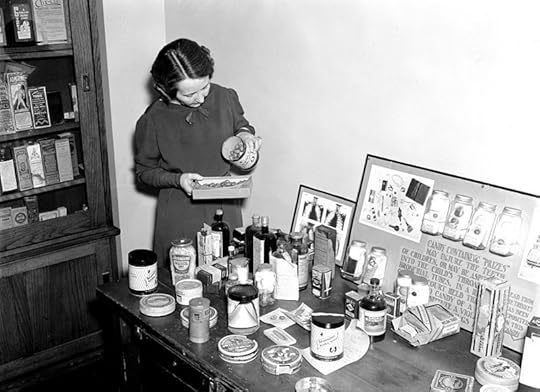 An FDA exhibit of dangerous products that the 1906 act didn't cover, used to campaign for stricter legislation, which was enacted in 1938.
An FDA exhibit of dangerous products that the 1906 act didn't cover, used to campaign for stricter legislation, which was enacted in 1938.As late as the 1930s and 1940s, apothecaries still compounded some 60% of all U.S. medications. In the years following World War II, however, the growth of commercial drug manufacturers signaled the coming decline of the medicine-compounding apothecary, just as the use of the mortar and pestle diminished to the point of becoming a quaint and charming symbol of a bygone era. In 1951 new federal legislation introduced doctor-only legal status for most medicines, and from then on the modern pharmacist prevailed, dispensing pre-manufactured drugs.
By the 1980s large chain drugstores had come to dominate the pharmaceutical sales market, rendering the survival of the independent neighborhood pharmacy precarious. Yet some of them do survive, as we have seen, and when one closes, the whole neighborhood mourns. But in a final twist, the word “apothecary,” meaning a place of business rather than a medicine compounder, has become “hip” and “in,” appearing in names of businesses having nothing to do with medicines. It expresses a nostalgia for experience free from technology and characterized by creativity and a personal touch, a longing for Old World tradition and gentility. And as one observer has commented, “apothecary” is fun to say.
A note on poisonous plants: Though it grows in North America, I’ve never seen belladonna, nor is it listed in U.S. field guides. But other poisonous plants are common, and I’ve seen them in the field. Poison ivy is ubiquitous but too familiar to dwell on. Stinging nettle (Urtica dioica) does indeed sting, as I know from experience, and cursed buttercup (Ranunculus sceleratus), which I’ve seen growing in shallow swamp water in Van Cortland Park, causes blisters if touched; yet neither is described as poisonous. Poison hemlock (Conium maculatum), an umbrella-like plant with terminal clusters of tiny white flowers and finely divided fernlike leaves, grows in one shady spot in Van Cortland Park and lives up to its name, since its juices are highly toxic; in ancient Athens it was the means for putting Socrates to death.
 Mick Talbot But the real surprise for me, in researching poisonous plants, was to learn that jimsonweed (Datura stramonium), which I’ve seen growing in dry soil in Pelham Bay Park in the summer, is both hallucinogenic and poisonous. I should have known, for it’s in the nightshade family, which includes belladonna. (And the potato and tomato, but that’s another matter.) An erect, foul-smelling plant with coarse-toothed leaves and big, trumpet-like flowers three to five inches long, it attracts attention because of its large, pale violet flowers, but there’s something about it that is brazen and coarse. The common name is a contraction of “Jamestown weed,” for it was first described in America in 1676 in Jamestown, Virginia. It has been used in folk medicine as an analgesic, and in sacred ceremonies among Native American tribes as a hallucinogen. But both the medicinal and hallucinogenic properties are fatally toxic if used in slightly higher amounts than the medicinal dosage, and many a would-be visionary and adventurous thrill-seeker has ended up in the hospital, if not in a coffin.
Mick Talbot But the real surprise for me, in researching poisonous plants, was to learn that jimsonweed (Datura stramonium), which I’ve seen growing in dry soil in Pelham Bay Park in the summer, is both hallucinogenic and poisonous. I should have known, for it’s in the nightshade family, which includes belladonna. (And the potato and tomato, but that’s another matter.) An erect, foul-smelling plant with coarse-toothed leaves and big, trumpet-like flowers three to five inches long, it attracts attention because of its large, pale violet flowers, but there’s something about it that is brazen and coarse. The common name is a contraction of “Jamestown weed,” for it was first described in America in 1676 in Jamestown, Virginia. It has been used in folk medicine as an analgesic, and in sacred ceremonies among Native American tribes as a hallucinogen. But both the medicinal and hallucinogenic properties are fatally toxic if used in slightly higher amounts than the medicinal dosage, and many a would-be visionary and adventurous thrill-seeker has ended up in the hospital, if not in a coffin.  H. Zell
H. ZellSo here am I, reveling in the exotic charms of belladonna, when right close to home, viewed every summer in a city park, is a native species every bit as dangerous, and fascinating, as the beautiful eye-dilating lady of the Renaissance. But no, I’m not even remotely tempted to taste of the hallucinatory joys of jimsonweed, whose other names include devil’s snare, devil’s trumpet, and hell’s bells. But it does make a hike in Pelham Bay Park more interesting.
Coming soon: West Village Wonders and Horrors. Including a civilized parlor and the most talked-about monstrosity in the Village.
© 2015 Clifford Browder
Published on July 05, 2015 05:04
June 28, 2015
186. Catastrophes: 1832 and 1888
June 15, 1832: a steamboat from Albany brings word that cholera has leaped the Atlantic to bring devastation to Quebec and Montreal. Cholera: the very word spreads fear. The mayor immediately proclaims a quarantine; no ship is to come closer to the city than 300 yards, and no land-based vehicle within a mile and a half. Then, on the night of June 26, an Irish immigrant named Fitzgerald becomes violently ill with cramps; he recovers, but two of his children likewise get cramps and die. The city fathers pressure the Board of Health to declare them victims of diarrhea, a common summer complaint, but many physicians know better, and word spreads that, in spite of the quarantine and the prayers of the pious, cholera has come to New York. Other residents begin experiencing a sudden attack of diarrhea and vomiting, followed by abdominal cramps and then acute shock and the collapse of the circulating system. Panic ensues.
New York City was used to yellow fever epidemics in the summer months, but not this: it was sudden, it was messy, it was fatal. But not all New York was affected: the white middle-class neighborhoods suffered less, while the slums were stricken. Especially the notorious Five Points slum just east of City Hall, where Irish immigrants and African Americans were packed together in filthy tenements. Soon horse-drawn ambulances were rattling through the streets, hospitals were jammed, mortalities soared.
The city’s Sanitary Committee, under the sanction of medical counsel, published a pamphlet that was widely circulated.
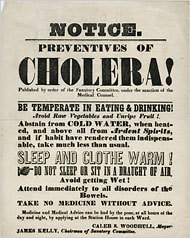
Most of which was irrelevant. The science of the day had no accurate knowledge of the disease, didn't connect cholera with contaminated water. There was no modern water supply system, no adequate sewage disposal; even the finest homes lacked running water, got their water from wells or cisterns, or from carts that peddled “tea water” (water to use when making tea) from a spring deemed safe. Doctors didn’t think the disease was contagious, attributed it to “miasmas,” meaning noxious vapors from decaying organic matter. Recommended remedies included laudanum and calomel, and camphor as an anesthetic; high doses often did more harm than good. Other treatments included poultices combining mustard, cayenne pepper, and hot vinegar, and opium suppositories and tobacco enemas.
By early July the white middle class was fleeing the city. Roads in all directions were jammed with crowded stages, livery coaches, private vehicles, mounted fugitives, and trudging pedestrians with packs on their backs. Normal steamboat service was almost nonexistent, for other communities refused to let steamboats with passengers from New York approach the landings; travelers had to disembark far from their destination and trek long distances through fields with their luggage before even finding a road. Farms and country houses within thirty miles of the city were filled with lodgers.
Back in the city, business was suspended and Broadway was deserted. Even churches closed down, though doctors, undertakers, and coffin makers had plenty to do. Carts loaded with coffins rumbled through the streets to the Dead House, unburied bodies lay rotting in the gutters, and putrefying corpses were taken to the potters’ field and dumped in shallow graves to provide a feast to rats.
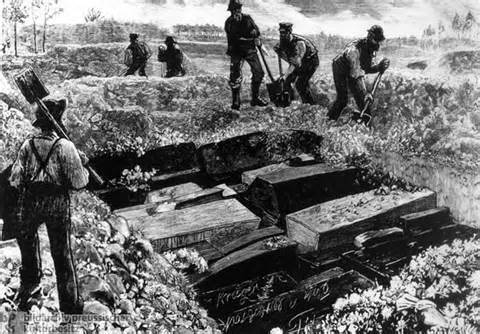
Many poor people blocked efforts to remove their sick to the hospitals, regarding them as charnel houses, and assaulted doctors or city officials who insisted. And of those who were admitted, many died within a day, which only stoked the public's fear. When private hospitals began turning away patients, the city established emergency public hospitals in schools and other buildings. One on Rivington Street was overwhelmed, and sketches made of patients there are haunting, their eyes wild, their faces contorted in the throes of death. The sketches appeared in a pamphlet published a year later by Horatio Bartley, an apothecary, with notes identifying the patients by initials only and tersely describing their suffering and the futile treatments attempted:
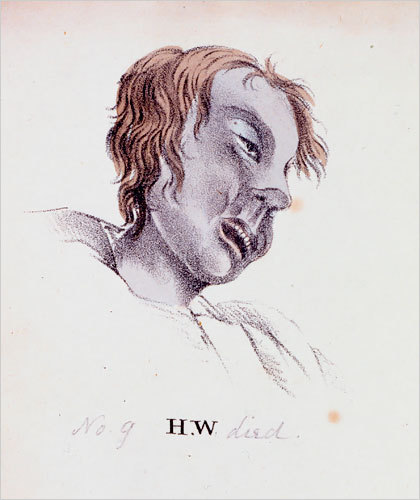
H.W. aged 56. Born in Barbados. Admitted 6th August, 6 o’clock P.M. Was attacked with purging and cramps in the night … prostration of strength … hands corrugated…. Ordered dry frictions, and afterward rubbed with a liniment…. Was put under medical treatment, until 6 P.M. and died after an illness of 4 hours.
Surprisingly, a few were deemed cured and sent to a convalescent hospital. But the ravaged features of the sketches are haunting, for they dramatize the victims and their suffering as printed words cannot; you are seeing the face of death.
Removing themselves from the reach of cholera didn't keep well-scrubbed middle-class citizens from evincing strong opinions about who got the disease, and why. John Pintard, a prominent citizen and founder of the New York Historical Society, remained in the city and wrote one of his daughters that the epidemic “is almost exclusively confined to the lower classes of intemperate dissolute & filthy people huddled together like swine in their polluted habitations.” And in another letter he declared, “Those sickened must be cured or die off, & being chiefly of the very scum of the city, the quicker [their] dispatch the sooner the malady will cease.” This opinion was common among the better off. Never was there a more blatant case of blame the victims. Contrasting with such attitudes was the devotion of the Catholic nuns and priests who stayed in the city to tend the victims, many of whom were Irish immigrants; the Sisters of Charity performed valiantly, and some of them died as a result. The Protestant majority took notice and grudgingly – for a while -- acknowledged their heroism.
By August the number of victims was declining. On August 22 the Board of Health announced that the city could be visited safely. The streets began to come alive, stores reopened, the rattle of drays and wagons was heard again, and private carriages were seen. Normal service by steamboats and stages resumed, and the city was linked again to the outside world. But out of 250,000 residents, 3,515 had died, the equivalent, for today’s population of eight million, of over 100,000 victims. “The hand of God,” said some. Fearing a recurrence, middle-class residents continued to move north to Greenwich Village, where numerous Greek Revival houses dating from 1832-1836 reflect this exodus.
Even though the link between cholera and contaminated water was not yet understood, the epidemic determined the city to create a modern water-supply system. This was completed in 1842, prompting a great citywide celebration, and from then on the gush of running water and the splatter of showers brought joy to the houses of the affluent, who could afford to pay the water tax. But the tenements and shanties of the poor knew no such amenities, and their residents still depended on water from wells often contaminated with human and animal waste.
This is not the end of the story, for cholera returned to the city when a packet from France arrived on December 1, 1848; seven passengers had died on board, and the rest were quarantined on Staten Island. Within a month 60 had experienced symptoms of the disease and 30 died. Fearing to become victims themselves, the quarantined survivors escaped and entered the city, where more cases were soon reported. Dogs and pigs roaming the streets to scavenge garbage helped spread the disease, and the city soon underwent a dreary repetition of the calamity of 1832, with two to three hundred dying daily and an even higher toll: over 5,000 in all, some 40% of them Irish immigrants. The epidemic peaked in early August and then quickly subsided, business resumed, and middle-class fugitives returned.
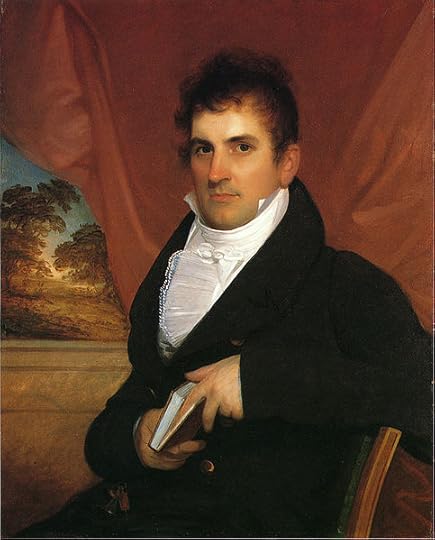 Philip Hone Not all the victims were Irish immigrants. The diary of Philip Hone, a successful retired auctioneer and former mayor, tells how on September 1, while working quietly in his office, he was seized with a violent diarrhea and ague. His son rushed him home by carriage and put him to bed with a severe chill. Nausea and vomiting followed, and his hands and face turned blue. A doctor came, looked, and diagnosed cholera. The family feared the worst, but “assiduous” treatment saved him and he recovered. Being treated at home, rather than in a hospital crammed with other victims, probably helped. But his contraction of the disease was proof enough that it was not confined to the Irish and German immigrants mentioned earlier in his diary as “filthy and intemperate.”
Philip Hone Not all the victims were Irish immigrants. The diary of Philip Hone, a successful retired auctioneer and former mayor, tells how on September 1, while working quietly in his office, he was seized with a violent diarrhea and ague. His son rushed him home by carriage and put him to bed with a severe chill. Nausea and vomiting followed, and his hands and face turned blue. A doctor came, looked, and diagnosed cholera. The family feared the worst, but “assiduous” treatment saved him and he recovered. Being treated at home, rather than in a hospital crammed with other victims, probably helped. But his contraction of the disease was proof enough that it was not confined to the Irish and German immigrants mentioned earlier in his diary as “filthy and intemperate.”By now there was increased awareness that cholera was more a social problem than a moral one, and an 1865 ward-by-ward survey of living conditions in the city led to the creation, in 1866, of the Manhattan Board of Health, which issued orders to clean up accumulated animal manure, rotting food, and dead animal carcasses at various sites around the city. While some business owners failed to comply, the city was the cleanest it had ever been when cholera struck for a third time that summer and took its usual toll of the poorer neighborhoods downtown. Still, the final toll of 1,137 victims, in a city of 1.2 million, was much less than in the outbreaks of 1832 and 1849. But middle-class prejudice dies hard. Pronounced the lawyer George Templeton Strong in his diary entry of August 6, “The epidemic is God’s judgment on the poor for neglecting His sanitary laws.” Not that he had to worry: his family were safe off on vacation in Vermont.
Science in time solved the mystery of cholera. In 1854 a London physician, Dr. John Snow, established the connection between the disease and contaminated water, when he discovered that most of the cholera victims of that year drew water from the same public well, and that a baby’s infected diapers had been dumped in a cesspool nearby. As for the discovery of the bacillus that caused cholera, it was at first attributed to the German physician Robert Koch in 1883. But we now know that the Italian physician Filippo Pacini had discovered and reported it in 1854, though his work was long ignored by the scientific community; finally, in 1965, the scientific name of the organism was officially changed to Vibrio cholera Pacini 1854. Better late than never.
And now for a change of season, and catastrophe. New York has experienced severe snowstorms in recent years, but when people complain, history buffs smile knowingly and say, “This is nothing compared to ’88.” Meaning not 1988, of course, but 1888. And thereby hangs a tale.
It seemed to come out of nowhere. On March 10, 1888, the temperature hovered in the mid-50s, and the weather forecast was for cooler weather but generally fair; New Yorkers thought spring was imminent. But the next day Arctic air from Canada collided with warm air from the south, and temperatures plunged. In no time rain turned to snow, and by midnight winds were blowing at 85 miles per hour. Overnight the snow -- tons of it -- kept falling, blanketing the whole Northeast and Canada, until by the morning of Monday, March 12, the city was buried under forty inches of snow, with drifts reaching the second story of some buildings.

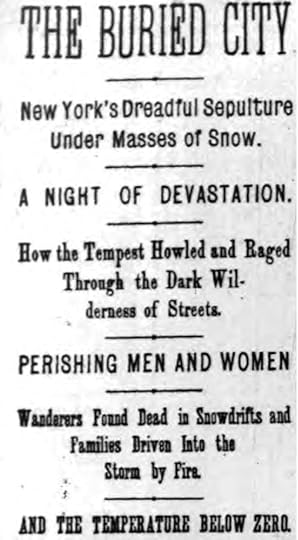 Waking to this spectacle, New Yorkers were astonished: blizzards, they thought, were something that happened on the Great Plains and in the Far West, but now one was happening here; a “Dakota blizzard,” they called it. Householders who tried to leave the house often found the front door and even the ground-floor windows blocked by snow, had to fetch a coal shovel from the basement and exit by a side door that didn’t face the storm head on, so that, with stiffening fingers and wind-stung faces, they could dig a path to the street. But of those who then departed, many soon turned back.
Waking to this spectacle, New Yorkers were astonished: blizzards, they thought, were something that happened on the Great Plains and in the Far West, but now one was happening here; a “Dakota blizzard,” they called it. Householders who tried to leave the house often found the front door and even the ground-floor windows blocked by snow, had to fetch a coal shovel from the basement and exit by a side door that didn’t face the storm head on, so that, with stiffening fingers and wind-stung faces, they could dig a path to the street. But of those who then departed, many soon turned back.The municipal government was shut down, the stock exchange closed. A few trucks were seen on the streets, but they were soon stalled in drifts. Some valiant citizens managed to trudge out to take the elevated trains to work, only to find them soon blocked with snowdrifts; some 15,000 passengers were stranded on snowbound trains, prompting some enterprising fellow citizens to appear with ladders and offer to rescue them … for a fee.
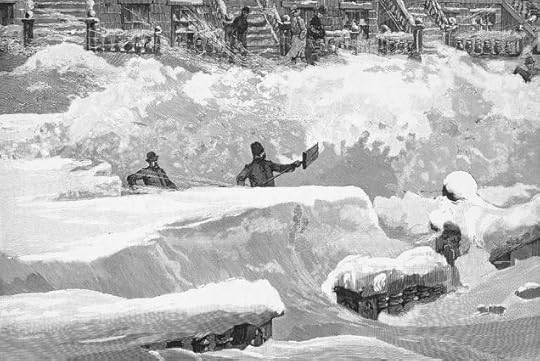
By evening the streets were littered with blown-down signs, and abandoned horsecars lying on their sides, their horses having been unhitched and led away to shelter. Jammed with stranded commuters, hotels installed cots in their lobbies. That night well-dressed gentlemen who couldn’t get a hotel room were glad to apply at a station house, usually the refuge of tramps and street kids, and settle for an ill-smelling cot. Telegraph and telephone lines, water mains, and gas lines, being located above ground, were frozen, and violent winds prevented repair crews from reaching them. The electric streetlights were out, and lighting the gas lamps was impossible, so at night the city was plunged in darkness. Hospitals were overwhelmed with cases of frozen hands and feet, fractured limbs, broken skulls. Firemen, their teams trapped in heavy drifts, watched helplessly as fires raged in the distance. Transportation was at a standstill; cut off from the rest of the world, the city was paralyzed.
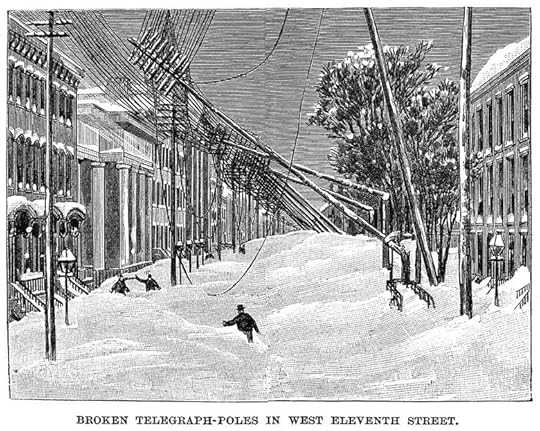
Walking the streets was perilous. The roaring, whistling wind stung your face, snow blinded you, exhaustion threatened. Policemen rubbed the numbed ears of pedestrians with snow to keep their ears from freezing, but at times encountered white, frozen hands protruding from giant wind-whipped drifts. A rigid corpse was discovered in Central Park, and another, that of a prominent merchant, on Seventh Avenue. Two Herald reporters wading through drifts on Broadway found an unconscious policeman half buried in snow at 23rdStreet and half-carried, half-dragged him to the Herald office, where he revived. Braving the wind and cold, Senator Roscoe Conkling, one of the most powerful Republicans of the time, tried to walk the three miles from his Wall Street law office to his home on 25thStreet near Madison Square, made it as far as Union Square, collapsed; contracting pneumonia, he died several weeks later.
Brooklyn, then a separate city, was also isolated. Because of the howling wind, to walk across the Brooklyn Bridge was dangerous; the police advised against it. But a great ice floe was pushed into the East River, which was usually warmer than the Hudson and not frozen over; jammed there, the ice provided a bridge that let people walk from Brooklyn to New York. But not without risk, for hours later the tide changed and the ice began breaking up. Some of those attempting the crossing suddenly found themselves drifting downriver on cakes of ice and shouted and waved their hands wildly in a plea for help. All the vessels on the river gave the alarm by blowing their whistles, and crowds ran frantically along both riverfronts shouting and screaming. Fortunately, several steam tugs quickly pulled out into the river and rescued the castaways.
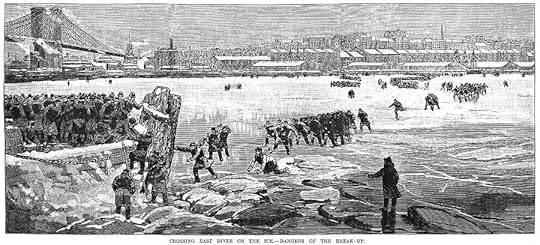
By dawn of March 13 the snow stopped falling, but the temperature was still below zero and the wind roared on for another two days, whipping the snow into weird, fantastic shapes. Huge mounds of snow blocked the streets, and between them were narrow paths where people crept along, sometimes seeing nothing but mountains of white and the sky above for half a block. People who went out on show shoes walked over the tops of trees. Their tracks covered, horsecars couldn’t operate, but sleighs with jingling bells appeared, and people hired them for $30 or $50 a day. Caps and thick woolen gloves were hawked on the streets, and newspapers sold for exorbitant prices that people gladly paid, partly out of sympathy for the half-frozen newsboys.
The price of coal doubled, and with their wives housebound and delivery of milk, bread, and other items suspended, many husbands embraced the unwonted task of lugging homeward whatever groceries they could buy in stores whose supplies were fast dwindling. A grocer on 8th Street who raised the price of a pail of coal from ten cents to a dollar found the wheels of his wagon stolen and replaced with shabby ones and a message in chalk: “Fair exchange is no robbery.” State legislators trapped in the city were consumed by worry at the thought of legislation that might be passed in Albany in their absence. Sounds of revelry issued from saloons, where men were downing whiskey to ward off the effects of the cold. Some of the imbibers then staggered out into the wilderness of snow, often as not collapsing in a drift and ending up with injuries in a hospital. And on the city’s outskirts exhausted survivors staggered in with tales of whole trainloads of passengers imprisoned in the snow without food or means of escape, following which rescue parties in sleighs were dispatched to rescue them.
When the wind at last subsided, travel on the streets was feasible, and the city tried to return to normal, but normal was still far off. Coal and foodstuffs were in short supply, and rail transportation remained suspended. For days there was no garbage collection, so people dumped their garbage in the streets. Huge piles of snow lined every sidewalk. Snow plows drawn by a dozen horses began clearing the streets, and gangs of workers shoveled snow onto carts that hauled it to the docks and dumped it in the river. The main thoroughfares were the first to be cleared, but in other neighborhoods the lingering snow turned black and stubbornly persisted until melted by the warm sun of spring; the last pile of it is said to have disappeared only in July. The bodies of more victims were found; in all, some two hundred New Yorkers had died in the storm. But something positive resulted: a renewed determination to move all elevated trains and power lines underground, so they would be less vulnerable.
Everyone who experienced the Great White Hurricane treasured the memory. Forty years later a club of aging veterans was formed that met annually on March 12 to share their experiences of the worst snowstorm to ever hit the city. Younger citizens scoffed, insisting that the old codgers’ tales were exaggerated and grew more so every year, but the old codgers knew better; the storm they had survived was unique.
Brooklyn redeemed: The Metropolitan section of the New York Times of Sunday, June 21, has two stories of redemption in Brooklyn. Congrats, Brooklyn.
First story: Ana Martinez de Luco, age 60, a Basque-born Catholic nun in an apron and sandals, runs a redemption center in East Williamsburg that she helped found in 2007. No, she's not redeeming people, for her redemption center, Sure We Can, is a depot for recyclables scavenged from trash by volunteers called canners who get a nickel per can or bottle. Crates, cartons, and cardboard boxes are piled everywhere, a stench of stale beer pervades the place, and chatter in English, Spanish, and Chinese is heard, as the canners bring their overloaded shopping carts to the stalls where staffers sort the items out. "It redeems people too," the "street nun" says of the center, for some of the canners have addiction or emotional problems or have done time in prison, and working there is therapeutic. Some of the Latino staffers have become her "sons" and bring her flowers on Mother's Day. And beyond the sheds that shelter the scavenged recyclables are gardens that, enriched with compost gathered from local businesses, yield lettuce, squash, beans, and tomatoes. Yes, a redemption center in every sense of the phrase.
Second story: Followers of this blog know that the Gowanus Canal in Brooklyn has a special place in my heart as my favorite Superfund cleanup site, its waters long since hopelessly polluted. But perhaps not hopelessly after all. Things have now improved there to the point where canalside dining is feasible. Yes, by the waters of that once polluted Venice there are now wooden tables and benches where diners gobble turkey, pork, or beef and guzzle beer at Pig Beach, which is described as a "no-frills pop-out outdoor barbecue restaurant." And the diners seem happy, oblivious of a recent review on the website Gothamist that called Pig Beach "the Worst New BBQ Place in NYC." Not my kind of food, I grant you, but anything that helps redeem the Gowanus Canal deserves to be celebrated.
Coming soon: Apothecaries, and the Charms of Belladonna. A post about the old-time apothecary shops, inspired by the current window display at Grove Drugs, 302 West 12th Street (entrance on Eighth Avenue), but a couple of blocks from my apartment, with a host of jars, bottles, scales, a big mortar and pestle, and a huge faded book with prescriptions dated 1917. If you live in this part of town, by all means go look at the display, which will take you back a century to the apothecary shops of bygone days. As for belladonna, also known as deadly nightshade, you may wonder why a known poison figures among the items displayed. All will be explained. And don't think you've never been exposed to it; you almost certainly have, and many times, as will also be explained.
© 2015 Clifford Browder
Published on June 28, 2015 04:27
June 21, 2015
185. Addictions
This post is about addictions: not drugs or alcohol or nicotine, but the stuff we get obsessed about, the stuff we think we can’t do without. Let’s begin with a quote from a prose poem of Baudelaire:
Il faut vous enivrer sans trêve. Mais de quoi? De vin, de poésie, ou de vertu à votre guise. Mais enivrez-vous.
You’ve got to be constantly drunk. But on what? On wine, on poetry, or on virtue, as you wish. But get drunk.
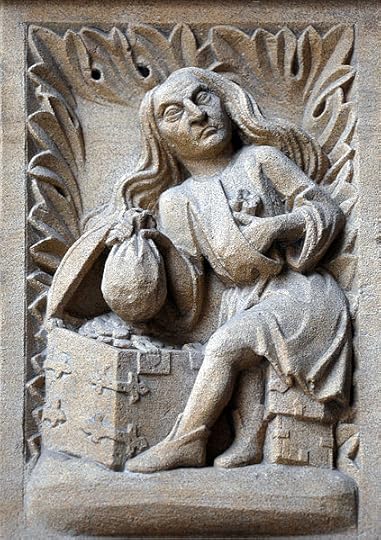 Avarice, cathedral of Metz. So what do we get drunk on? Here in New York, Wall Street is drunk on greed. In post #150, “Wall Street, Greed, and Addiction” (October 26, 2014), I discussed exactly this, citing the account of a former Wall Streeter who at age 25 had a salary of $1.75 million a year, but came to realize that he wasn’t doing anything useful or necessary to society, that he was addicted to money -- an addiction that he finally, with great effort, shook off.
Avarice, cathedral of Metz. So what do we get drunk on? Here in New York, Wall Street is drunk on greed. In post #150, “Wall Street, Greed, and Addiction” (October 26, 2014), I discussed exactly this, citing the account of a former Wall Streeter who at age 25 had a salary of $1.75 million a year, but came to realize that he wasn’t doing anything useful or necessary to society, that he was addicted to money -- an addiction that he finally, with great effort, shook off.And how are things on Wall Street today? For the last five years the beginning Wall Street salary for recent college graduates was a mere $70,000, but now times are so good that it has been raised to $85,000. So an article in the New York Times of May 14 states, while reporting on a new study giving the views of Wall Street professionals themselves on their industry. About a third of those interviewed said they had knowledge of wrongdoing in the workplace, and nearly one in five concedes that, to be successful today, a Wall Streeter must sometimes engage in unethical or illegal activity. Compensation structures or bonus plans encourage employees to compromise ethics or violate the law, and employees fear retaliation if they should ever report wrongdoing. All of which suggests that, in spite of penalties worth billions that Wall Street firms have paid to settle charges of misconduct, their addiction to greed still rages.
This reminds me of Antoine de Saint-Exupéry’s beloved classic The Little Prince, in which a little prince from another planet tells of his adventures exploring the cosmos and learning about grown-ups. On one asteroid he encounters a businessman who is totally involved in counting “those little golden things that make lazy people daydream,” which the little prince finally identifies as stars. The businessman claims to own the stars, but all he does is count them and put the numbers in a bank. When his visitor observes that such ownership serves no useful purpose, the businessman is left speechless, and the little prince departs, observing that grown-ups are truly “extraordinary.” I humbly suggest that the behavior of many denizens of Wall Street is likewise truly extraordinary.
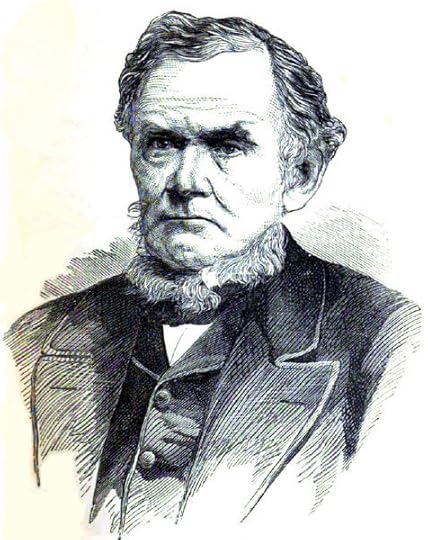 But preoccupation with money may involve something other than greed. In the 1860s and early 1870s Daniel Drew, a drover turned financier and steamboat operator, reveled in perturbing Wall Street. Dressed drably, with a pinched face and a fringe of whiskers, he struck others as a rube from the provinces or a country parson, and was referred to as Ursa Major, the Old Bear, and the Deacon. As the most inside insider and its lender of last resort, he manipulated the stock of the Erie Railway, clipped Commodore Vanderbilt for several millions (no easy thing to do), and attempted a corner of greenbacks, on each occasion convulsing the stock market and sometimes disrupting international markets as well. Tight-lipped, his gray eyes agleam with cunning, he loved being importuned by journalists on Wall Street, but gave them mere scraps of information at most – just enough to tantalize them and make them beg for more -- before entering his broker’s office, where he escaped to a snug, small room in back and shut the door in their face. And from inside that snug little room, where in cold weather he sat with his feet propped up on a mantle in front of a blazing fire, could be heard his hen-cackle laugh, which earned him yet another nickname: the Merry Old Gentleman of Wall Street. And well might he laugh. A half-literate farm boy from Putnam County who couldn’t even spell “door” (he spelled it “doare”), he'd showed them yet again that he could outsmart the shrewdest of the Wall Street crowd, that he was still a big bug on the Street.
But preoccupation with money may involve something other than greed. In the 1860s and early 1870s Daniel Drew, a drover turned financier and steamboat operator, reveled in perturbing Wall Street. Dressed drably, with a pinched face and a fringe of whiskers, he struck others as a rube from the provinces or a country parson, and was referred to as Ursa Major, the Old Bear, and the Deacon. As the most inside insider and its lender of last resort, he manipulated the stock of the Erie Railway, clipped Commodore Vanderbilt for several millions (no easy thing to do), and attempted a corner of greenbacks, on each occasion convulsing the stock market and sometimes disrupting international markets as well. Tight-lipped, his gray eyes agleam with cunning, he loved being importuned by journalists on Wall Street, but gave them mere scraps of information at most – just enough to tantalize them and make them beg for more -- before entering his broker’s office, where he escaped to a snug, small room in back and shut the door in their face. And from inside that snug little room, where in cold weather he sat with his feet propped up on a mantle in front of a blazing fire, could be heard his hen-cackle laugh, which earned him yet another nickname: the Merry Old Gentleman of Wall Street. And well might he laugh. A half-literate farm boy from Putnam County who couldn’t even spell “door” (he spelled it “doare”), he'd showed them yet again that he could outsmart the shrewdest of the Wall Street crowd, that he was still a big bug on the Street.Was Dan Drew addicted to greed? Many thought so at the time but were mistaken. When a young Methodist minister with whom he had a close friendship urged him to retire from business with his millions and do God’s work, he replied, “People don’t understand me. They think I love money. I tell you, Brother Parker, it ain’t so. I must have excitement or I should die. And when I get among these money kings, I go in because I don’t want them fellows to feel that they can have everything their own way. And when I go in, I go in to win, for I love the fight!” There, expressed candidly for perhaps the only time in his life, is the secret of what made Dan Drew, a good church-going Methodist, tick. He had to have risk and adventure, the sheer fun of secret combinations, of greenhorns and old hands alike flocking to him with offers, schemes, and tips, the thrill of sending messengers racing to the Stock Exchange with orders to buy or sell millions, the Street bleeding and the press agog because once again the Old Bear had “taken a slice out ’em.” Was this addiction? Yes. Dan Drew was addicted to excitement.
While Dan Drew was cavorting on Wall Street, his colleague Alanson P. St. John, a senior captain, superintendent, and treasurer of Drew’s People’s Line, was looking after Drew’s steamboats. Captain St. John had been a steamboat skipper on the Hudson River for over forty years, most of the time with the People’s Line. The rhythms of his life were married to the rhythms of the river, and to the palace steamboats, the finest in the world, that plied between New York and Albany. Every spring, when the packed ice of the Hudson began to squeak and crack and groan, and geese honked northward, and the first boats nudged their way upriver to Peekskill, then Poughkeepsie, and finally all the way to Albany, his heart beat fast, glad to shake off the long inactivity of winter. And when the great mass of ice broke loose and surged down the river, slammed and sloshed its way past Manhattan into the Inner Harbor and the Outer Harbor all the way out to Sandy Hook, and spewed forth into the ocean its captive splintered small craft, broken pier ends and bridges, and the thawed bodies of the drowned, then at last, with the river open to navigation, Captain St. John was truly and completely alive.
All spring and summer and autumn he ran the spume-treading People’s Line boats to Albany, skippering one and then another as they took merchants and politicians and westward bound travelers to Albany, fashionables to Saratoga, and aesthetes and artists to the Adirondacks. He knew and loved the sight of steamboat funnels belching pillars of smoke by day and showers of sparks by night, the sound of the splashing sidewheels, and in summer the aroma of fresh peaches and plums and grapes rising from the freight deck to intoxicate him. He knew the boats, their pistons plunging and their furnaces blazing as they sped silently and smoothly upriver, and he knew the passengers, who marveled at the paneling of rosewood and ebony, the grand saloons with glittering chandeliers, the marble tables and satin damask chairs. And if he especially prized the St. John, a $400,000 wonder of marine construction named for himself and hailed by the press, he could hardly be blamed; it was recognition of his lifelong devotion to the boats and the river. And if, late each autumn, geese honked southward, snow fell, and ice began to sheathe the Hudson, signaling the end of the season, he knew it was time to tie up the boats to the docks, repair and repaint them, and plan for the season to come.
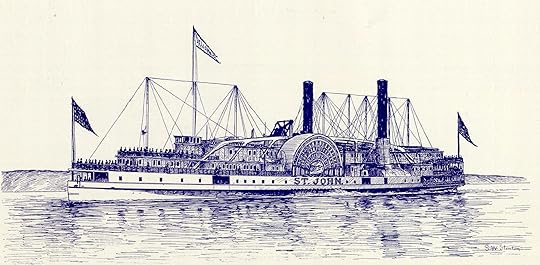
So it went for years, but finally time caught up with him. In 1875, at age 77 and suffering from ill health, he was forcibly retired by the board of the People’s Line, following which he was at a loss, listless, depressed. Then, after a long winter, spring came. The Dean Richmond and the Drew had been overhauled, their brass polished, and new carpets and furniture installed, and were ready for the run to Albany, and the St. John would soon follow. With the river at last free for navigation, trucks were flocking to the docks to unload freight destined for all the river towns as far up as Albany and Troy. It was a new season with the whole river coming to life again, but he was not a part of it.
On the afternoon of April 23, 1875, the retired skipper came from his home in New Jersey to look over his favorite boat, the St. John, still undergoing repairs at the foot of West 19th Street, North River. Chatting with the mate on the deck, he seemed in good spirits and the best of health, following which he entered the steward’s room alone. Five minutes later a shot rang out. Rushing inside the cabin, the workmen found the captain sprawled dead in an easy chair, a smoking revolver in one hand, his features as composed as in sleep. Suicide, the coroner concluded, “while laboring under temporary aberration of mind.” Some attributed his depression to ill health, but his friends knew better: he couldn’t live away from the river. His addiction was benign, benefiting himself and many others for years, but in the end it killed him.
Yes, an addiction can be benign.
Captain St. John was addicted to steamboating and the river, but his addiction lacked the compulsive behavior of the true workaholic, which leads to neglect of family and friends and often undermines the subject’s health. A prime candidate for the label “workaholic” is Fiorello La Guardia, mayor of New York from 1934 to 1945, whom I have already discussed in post #102, “The Dynamo Mayor: La Guardia” (December 1, 2013). A workaholic? Consider:
· His feverish dictation of letters to three stenographers simultaneously: “Nuts! …Regrets! … Thanks!” while tossing letters at his secretary: “Say yes! … Say no! … Throw it away! … Tell him to go to hell!”· His whirlwind visits by car to verify the progress at a housing construction site, or to supervise snow removal or traffic flow, or query a patrolman or garbage collector, sometimes visiting all five boroughs in a single day.· His readiness, when angry, to knock a city employee’s hat off or dash a cigarette from a worker’s lips.· His delight in personally taking a sledge hammer to mobster Frank Costello’s confiscated slot machines and dumping the smashed machines from a police boat into Long Island Sound.· His rushing to the scene of a tenement roof’s collapse, a train wreck, or a fire to scream advice to police and firemen, even dashing into a burning building to inspect the refrigerator system to see if the building code had been violated.
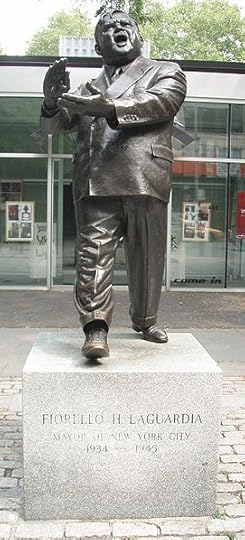 Neil Estern's statue of La Guardia at La Guardia Place in Greenwich
Neil Estern's statue of La Guardia at La Guardia Place in GreenwichVillage. Better than any photo I know, it captures his intensity. Just an energetic little man who loved his job, you might say. Yes, he was all that, but anyone who saw his short, pudgy form in action, waving his arms wildly and raising his high-pitched, squeaky voice to a scream in order to make a point, sensed in his explosive personality a force that went beyond commitment to a job. He couldn’t not do these things, he was driven. Yes, I insist, a workaholic, but by general acclaim the best mayor – and certainly the most honest – that the city has ever had.
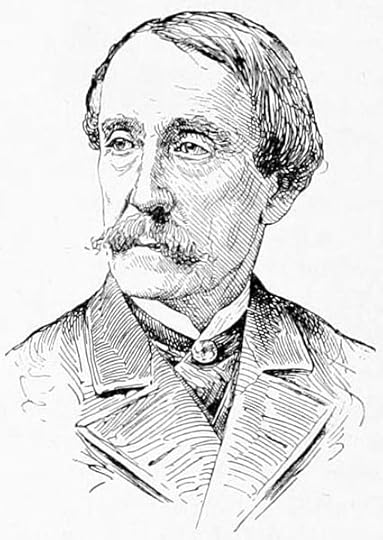 As La Guardia’s story demonstrates, zealous reformers risk becoming workaholics. Let’s look now at Henry Bergh (1813-1888), another reform-obsessed New Yorker but one whose name, unlike La Guardia’s, doesn’t resonate today. Tall, erect, and slender, with a droopy mustache considered stylish at the time, he had the appearance, in his frock coat and well-brushed topper, of a dapper gentleman of leisure who had no need to smirch his hands with toil. But if, on his treks through the city, he saw a cartman beating his horse, Bergh would approach the cartman and explain civilly that what he was doing was against the law. Then, if the offender evinced disbelief, Bergh would produce a copy of the law from his pocket and read it to him. So far, Bergh the gentleman. But if, as often happened, the cartman told him to go to hell and continued beating the animal, Bergh the gentleman was instantly transformed into Bergh the warrior, who would grab the offender by the collar and yank him down from his cart. And if a scuffle ensued, Bergh would summon the policeman he had posted nearby and have the man arrested.
As La Guardia’s story demonstrates, zealous reformers risk becoming workaholics. Let’s look now at Henry Bergh (1813-1888), another reform-obsessed New Yorker but one whose name, unlike La Guardia’s, doesn’t resonate today. Tall, erect, and slender, with a droopy mustache considered stylish at the time, he had the appearance, in his frock coat and well-brushed topper, of a dapper gentleman of leisure who had no need to smirch his hands with toil. But if, on his treks through the city, he saw a cartman beating his horse, Bergh would approach the cartman and explain civilly that what he was doing was against the law. Then, if the offender evinced disbelief, Bergh would produce a copy of the law from his pocket and read it to him. So far, Bergh the gentleman. But if, as often happened, the cartman told him to go to hell and continued beating the animal, Bergh the gentleman was instantly transformed into Bergh the warrior, who would grab the offender by the collar and yank him down from his cart. And if a scuffle ensued, Bergh would summon the policeman he had posted nearby and have the man arrested.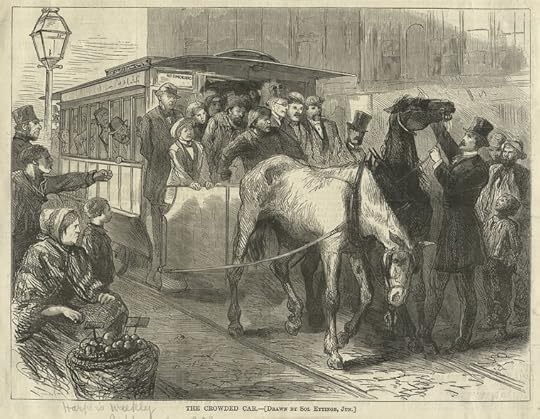 Henry Bergh stopping a crowded horsecar to see if the horses drawing it are well treated.
Henry Bergh stopping a crowded horsecar to see if the horses drawing it are well treated.Such was Henry Bergh’s daily routine in the city. He also targeted butchers who stacked live animals like cordwood on market-bound carts, organizers and patrons of dogfights and cockfights, trolley companies that overworked their horses, and sportsmen who practiced marksmanship by tossing live captive pigeons in the air. That he was mocked by some, denounced by others, and labeled “the Great Meddler” in the press bothered him not at all.
So who was this meddler and what was he up to? The son of a wealthy New York shipbuilder who left him a fortune, Henry Bergh indeed had no need to smirch his hands with toil. In his early years he was something of a dilettante, scribbling poetry and plays of no great value, enjoying the city’s social life, and traveling abroad with his young wife. Seeing a bull fight in Spain, he was appalled by the bloody spectacle, especially the crowd’s cheers when the horses were gored, and when the bulls were taunted and then killed.
Thanks to his social and political connections, Henry Bergh in 1862 was appointed secretary and acting vice consul to the American legation in St. Petersburg, Russia, and it was there, so the story goes, that the incident that would shape his life occurred. One day, while riding through the streets in a fancy carriage, he saw a Russian peasant beating his fallen cart horse. Shocked, he order his coachman to stop and to tell the peasant to stop beating the horse. How the incident ended isn’t clear, but it determined Bergh to launch a campaign in the U.S. against such wanton cruelty to animals. Returning to America, he stopped off in England, where he consulted the Earl of Harrowby, president of the Royal Society for the Prevention of Cruelty to Animals, following which he decided to found a similar society in New York.
Back in the city he urged friends and acquaintances to support his campaign, gave lectures to children and adults, got letters published in newspapers and magazines, and persuaded prominent citizens to sign a petition that he took to Albany, where he lobbied the state legislature to good effect. As a result, in 1866 the legislature granted a charter for the American Society for the Prevention of Cruelty to Animals (ASPCA), of which he became the president, with authorization to enforce the new law that it passed, making cruelty to animals illegal.
Armed with the new law, Bergh and his agents patrolled the streets and docks to enforce it, often risking physical assault. Seeing an overloaded wagon too heavy for the beast trying to haul it, they made the driver lighten his load. Sick and decrepit horses were taken from their drivers and sent to the Society’s animal hospital, and suffering horses were likewise rescued from stables. If an animal fell into a ditch or an excavation (of which there were plenty in the ever expanding city), the Society used a derrick to lift it out. They inspected slaughterhouses, looked everywhere for raw flesh under collars and saddles, protested when dairymen kept cows chained to their stalls, and created public fountains where animals could drink. And to replace the live pigeons used by sportsmen in shooting matches, Bergh himself invented the clay pigeon still in use today.
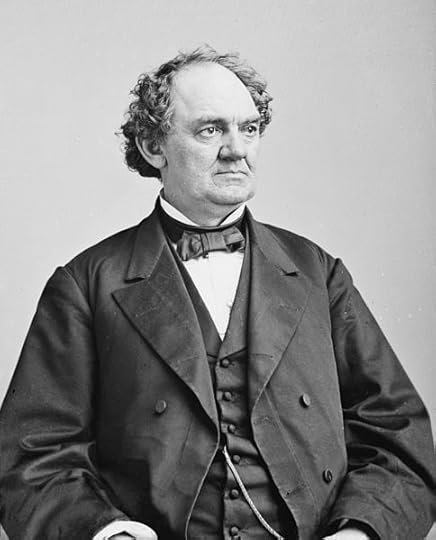 P.T. Barnum Early in his campaign he clashed with P.T. Barnum, the leading American showman of the time and self-proclaimed master of humbug. In December 1866 Bergh wrote a letter to the managers of Barnum’s new museum to protest the feeding of snakes with live animals, a practice that he called “semi-barbarian”; if they persisted, he threatened prosecution. Returning from a trip to the West, Barnum found the letter and answered it in March 1867, stating that the museum would continue to feed its animals in accordance with the laws of nature; enclosed was a letter Barnum had solicited from the noted biologist Louis Agassiz, confirming Barnum’s insistence that the only way snakes eat their food is in its natural state: alive.
P.T. Barnum Early in his campaign he clashed with P.T. Barnum, the leading American showman of the time and self-proclaimed master of humbug. In December 1866 Bergh wrote a letter to the managers of Barnum’s new museum to protest the feeding of snakes with live animals, a practice that he called “semi-barbarian”; if they persisted, he threatened prosecution. Returning from a trip to the West, Barnum found the letter and answered it in March 1867, stating that the museum would continue to feed its animals in accordance with the laws of nature; enclosed was a letter Barnum had solicited from the noted biologist Louis Agassiz, confirming Barnum’s insistence that the only way snakes eat their food is in its natural state: alive. Bergh answered at once, quoting at length the account of an anonymous museum visitor who described in detail the terror of a rabbit thrust into the cage of a boa constrictor, and deploring Agassiz’s condoning of such a cruel practice. This prompted a long and heated response from Barnum, who denounced Bergh’s “insulting epithets” and “ungentlemanly manner,” his “dictatorial air” and “thoughtless and absurd statements,” his “miserable pettifogging.” Clearly, Bergh had touched a raw nerve, prompting the showman to get the exchange of letters published in the New York World, which called the controversy “funny as well as instructive.” There is little doubt that Barnum meant to subject Bergh to public mockery.
In spite of Barnum’s hostility, Bergh and his agents persisted in the face of mockery, indifference, and even physical abuse, and gradually won the public over, thus creating a radical change in how New Yorkers viewed animals and treated them. “An angel in a top hat” was how Bergh’s supporters described him, though they might just as well have said “human dynamo.” His lecture tour in the West in 1873 prompted the formation of several societies similar to the one he had founded in New York. In 1879 Scribner’s Magazine declared that Bergh had invented “a new type of goodness.” By 1886, 39 states had adopted statutes protecting animals based on the original one in New York. When, worn out by his efforts, Bergh died in 1888, Barnum was a pallbearer at his funeral, for Bergh’s tireless efforts and obvious sincerity had finally won even the master showman over. For what good-hearted citizen could long resist Henry Bergh, a man addicted to benevolence?
Reformers rarely achieve their goals easily. The abolitionists campaigned for decades, but only the coming of the Civil War made possible the abolition of slavery. Similarly, the suffragettes fought long and hard before finally getting the vote for women. Why did Bergh obtain the desired New York State legislation so quickly? The abolitionists were stymied for years by the slaveholders, who held their own in the Senate and the Supreme Court, got proslavery men elected President, and intimidated well-meaning citizens with the threat of secession. And the suffragettes had to overcome the prevailing opinion, held by most men and many women, that the woman’s place was in the home, and that women were incapable of dealing with the issues of public life. Bergh, on the other hand, had to cope with mockery and disbelief, but no entrenched opposition. Who, after all, wanted to stand tall in the public arena as a defender of the brutal treatment of animals? His appeal to society’s better instincts triumphed, and victory came quickly.
Bergh’s Society was one of many operating in nineteenth-century New York, each reflecting someone’s intense concern with social betterment. As for instance:
· The Society for the Encouragement of Faithful Domestic Servants· The Society for the Prevention of Crime· The Society for the Prevention of Cruelty to Children· The Society for the Relief of Distressed Debtors· The Society for the Relief of Poor Widows· The Society for the Reformation of Juvenile Delinquents· The Society for Promoting Christian Knowledge and Piety among the Poor· The Association for the Relief of Respectable Aged Indigent Females
And many more.
Clearly, benevolence was rampant in the city. But if these names strike us as quaint and condescending, and smack of excessive middle-class do-goodism, it’s worth remembering that nineteenth-century New York, like Dickens’s London, was rife with poverty, ignorance, and vice, to cope with which there as yet were few agencies of the city or state. But the good folk of the middle class couldn’t easily ignore these conditions, since rich and poor lived in close proximity. In post-Civil War New York, Fifth Avenue was the acclaimed axis of elegance, lined with imposing mansions and spiky spires of churches. But if in the evening one walked a mere block west to Sixth Avenue, one found oneself in the Tenderloin – the “Satan’s Circus” of many a sermon – with pretty-waiter-girl saloons, gambling dens, brothels, and cheap hotels with rooms available by the hour or the night, its sidewalks alive with streetwalkers, pimps, wisecracking loafers, and drunks. To eliminate these alleged disreputables was the goal of many a do-gooder, sometimes affiliated with a church and sometimes not – an addiction to benevolence with a cutting edge.
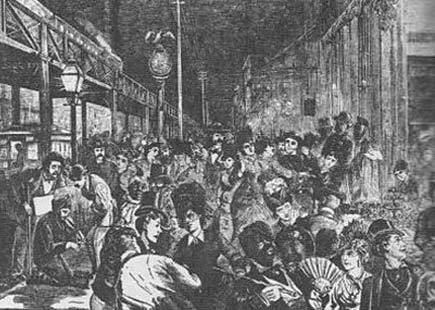 The Tenderloin, "Satan's Circus." At least they were having fun.
The Tenderloin, "Satan's Circus." At least they were having fun.A last word on addictions: benign or otherwise, we need them. They can destroy you or give your life a purpose; either way, they liven things up. If you have an addiction, you’ll never be bored.
Note on Goldman Sachs: Followers of this blog know how, second only to Monsanto, I love Goldman Sachs. (See post #158, “Goldman Sachs: Vampire Squid or Martyred Innocent?”) Having for 146 years been the bank of the powerful and privileged, it has now announced that, starting in 2016, it will offer loans of a paltry few thousand dollars to ordinary Americans, people like you and me, and (a new twist) it will do so online. This is unprecedented, and risky, too, since Goldman has no experience dealing with ordinary borrowers with limited financial means. Why then is it doing it? Make no mistake, it sniffs an opportunity, smells profit. So the vampire squid (not my image, though I love it) is reaching its tentacles into yet another realm of finance. Borrowers, beware. The squid does not enjoy a good reputation, has a genius for profiting from the woes and folly of others.
Coming soon: Catastrophes. Do the years 1832 and 1888 mean anything to you? If not, they will, for in those years New Yorkers had a lot to put up with. And after that, West Village Wonders and Horrors, with a look at a pink palazzo right down the street from me that maybe should never have been built.
© 2015 Clifford Browder
Published on June 21, 2015 05:12
June 14, 2015
184. Cast Iron and Terra Cotta: What I Discovered on 11th Street
Until recently my only personal association with cast iron was a skillet that I owned long ago and that served me well, as long as I dried it carefully so as to prevent rust. As for terra cotta (“baked earth” in Italian), for me it meant ceramic figurines of one ancient culture or another, and panels of sculpted figures by Luca della Robbia that I had once seen in distant Florence. Though vaguely aware of cast-iron buildings in Soho, I had never really looked at them closely, and had no idea that terra cotta had anything to do with New York City architecture. Until, that is, I heard of two nonprofits active in the city: Friends of Cast-Iron Architecture and Friends of Terra Cotta. At which point I decided that, if they each had friends organized in a nonprofit, cast iron and terra cotta bore looking into. A glance or two online convinced me that both were significant in the history of New York City architecture and deserved to be seen in the field, meaning, in buildings in this city.
Cast iron first. Learning that there was a prime example of it at 67 East 11th Street – my street – right here in Greenwich Village, I made seeing it one of two goals for a walk in that direction, the other goal being the Washington Square Outdoor Art Exhibit, where an artist friend of mine was exhibiting. So began yet another memorable walk in the city. (For other walks of mine, see post #180, “Walking in New York.”) This walk took me, with my friend John, across town on West 11th Street, passing a number of significant sites:
· At Seventh Avenue and West 11th Street, construction of a luxury tower on the site of St. Vincent’s Hospital, now demolished. Why the hospital, founded in 1849 and once one of the best in the city, went bankrupt in 2010 remains a mystery, and one well worth probing. As a Villager who was once treated there, and who mourns the loss of the only full-service hospital in the area, I resent the construction of still more luxury housing and can only view this coming monstrosity as an insult to the psyche. A sour note right at the start of the walk.
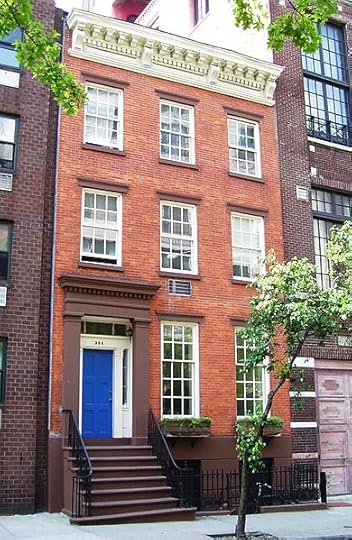 A Greek Revival house on West 11th Street.
A Greek Revival house on West 11th Street.Beyond My Ken· Along West 11th Street between Seventh and Sixth Avenues, a number of well-preserved Greek Revival houses and brownstones – for me, always a source of delight, and welcome relief after the painful reminder of St. Vincent’s.· Just beyond Sixth Avenue, a triangular sliver of a Jewish cemetery established in 1805. The Jews of that time were Sephardic Jews whose ancestors had fled persecution in Christian Spain and Portugal and finally found refuge in New York. When the cemetery, the third Jewish cemetery in the city (though labeled the second), was first established, there were cow pastures nearby, and children would jump the fence to steal apples from apple trees growing among the graves. But in 1830 the city planned an extension of 11th Street right through the cemetery westward to Sixth Avenue. Faced with the loss of their cemetery, the Jews petitioned the city to preserve a small slice of it not needed for the street extension, and their request was granted. Blocked off now by a wall and overshadowed by the neighboring buildings, the cemetery is easy to miss, but when walking that way I never fail to glance at it through a grilled gate; some twenty worn headstones survive.· At 18 West 11th Street, a new row house whose jutting angular façade clashes with the older buildings on the block: a reminder that this modernist upstart is built on the site of an old Greek Revival townhouse built in 1845 and totally demolished on March 6, 1970, by an explosion. While the owners of the building, a radio-station executive and his wife, were vacationing in the Caribbean, their little girl and her Weather Underground friends were making bombs in the basement. Unfortunately – or maybe fortunately, given their intentions -- none of them had experience in handling explosives, with the obvious result. The blast killed three of them and reduced the building to rubble, but two others, stunned and bleeding, survived and escaped. That the Landmarks Preservation Commission approved the jutting oddity now blemishing the site is, to put it mildly, shocking. It’s their job to prevent such anomalies.
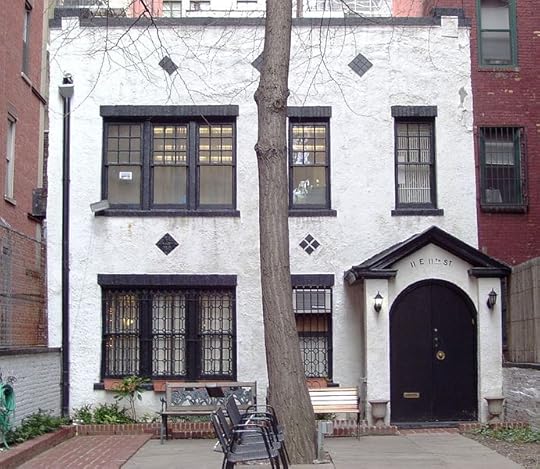 The Conservative Synagogue of Fifth Avenue.
The Conservative Synagogue of Fifth Avenue.Beyond My Ken· Just across Fifth Avenue, the Conservative Synagogue of Fifth Avenue, a small two-story structure at 11 East 11th Street, its white façade with black trim set well back from the street and enjoying that rarity in Manhattan, a plot in front with benches and a bit of greenery. Hardly noticed by most passersby, the quaint little building has undergone many a change. Built in the 1830s as the carriage house for a Fifth Avenue residence, it was set well back from the street by the builder, a wealthy attorney, so his genteel neighbors wouldn’t be assailed by the smell of manure. In 1867 a police raid on the little building revealed, smack in the midst of one of the city’s most fashionable neighborhoods, a disorderly house with five women in residence. Converted to a garage and then to a one-family residence in the early twentieth century, the building survived, squeezed in between a hotel and an apartment building. In 1930, a year after the Great Crash, the occupant, a Wall Street broker, was so disheartened by stock-market losses that he committed suicide. Preserved over the years because of its unique charm, in 1960 no. 11 East 11th Street became a synagogue.· On a stoop of one of the old buildings in the block, a Nepalese mother with her young son, both fluent in English, selling lemonade as a benefit for the victims of the recent earthquakes in Nepal. John and I talked with her briefly, and we each bought a lemonade for a dollar.· Beyond University Place, at the corner of East 11thand Broadway, my first goal, the cast-iron building at 67 East 11th, an impressive structure indeed. More of that anon.· Along University Place from 11th Street down, bustling crowds visiting the Art Exhibit and, at a stand near West 9thStreet, the second goal of the walk, our friend Henry’s work on display, with a whole bunch of paintings in a new style for him, fantasy landscapes reflecting scenes of his imagination rather than re-creations of real scenes he had observed. I admired all the new works, and especially the one that had been awarded the Exhibit’s top prize for landscapes.
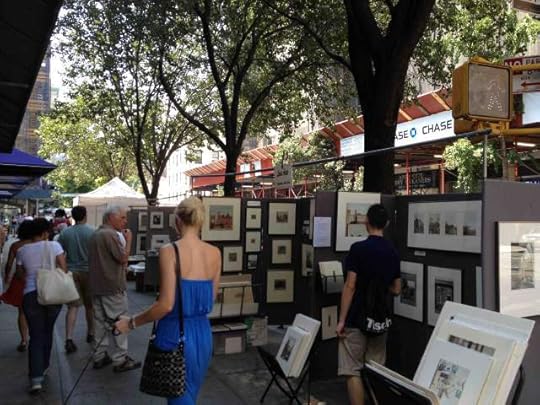
· At Sixth and Greenwich Avenues, as I came back alone along West 9th Street from the exhibit, the Jefferson Market Garden, open to the public and celebrating its fortieth anniversary, having been created in 1975 on the site of the demolished Women’s House of Detention, a West Village Bastille of ill repute. I took a brief stroll through the grounds, reveling in the flowers and foliage and regretting not one bit the prison that once loomed gloomily on the site, its inmates shrieking obscenities and calling down to friends on the street. There are times when gentrification, that bane of preservationists, pays off.
So ended my stroll through the Village.
Now about 67 East 11th Street. Built in 1868, the huge seven-story structure (though I count only six) takes up much of the northern or uptown side of the block between University Place and Broadway. Four tiers of Corinthian columns, their capitals adorned with intricately molded foliage, stretch across the beige-tinted façade all the way to Broadway, framing the tall windows, each window topped by a rounded arch. The ground floor is occupied by shops: KidVille, the Bergino Baseball Clubhouse with baseball memorabilia, and Le Pain Quotidien (the Daily Pain, as I like to call it). Crowning the building above the tiers of columns, alas, is a top floor that looks like a drab substitute for the original mansard roof. Massive, the building lacks the charm of Greek Revival and brownstone houses standing in tight-packed rows like a baker’s loaves on a shelf, but it has a solitary epic grandeur, a magnificence that struck me at once and steadily grew as I continued to view it.
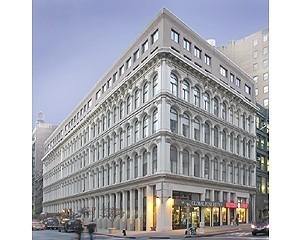
The structure served originally to house McCreery’s dry-goods store on Ladies’ Mile, a stretch of Broadway occupied in the Gilded Age by fashionable department stores catering to the wives of the affluent. Just across the avenue was (and still is) Grace Episcopal Church, a splendid Gothic edifice that served those same wives and their husbands, the source of all their wealth. In 1903 McCreery’s moved out, following the uptown migration of its clientele, and the building became a factory making ladies’ shoes and handbags. Having survived a fire in 1971, no. 67 was converted to a co-op with 144 apartments in 1973, the first such conversion of a loft building in the city. Known today as the Cast Iron Building, the structure has landmark status and is advertised as offering a renovated lobby; a doorman, concierge, and security guard; high ceilings, fabulous views, and an elevator; and for some units a sun-drenched terrace. Tempted to move in? Fine, but a one-bedroom apartment will cost you close to $1 million or more.
John and I were mightily impressed by the Cast Iron Building, but one thing puzzled us: where was the cast iron? All we saw were stone columns and surfaces, and rounded arches over outsized windows. The cast iron, we decided, must be masked by all these decorative features. Which shows how little we knew. Back in my apartment I did a bit of online research, and all was made clear. Cast iron, I learned, was often painted so as to simulate stone, so the entire front of no. 67 – the whole massive beige-tinted façade we had been looking at – was made of the material, and the building merited its name. To verify, you could use a magnet, but not having one, on my second trip a week later I did the next best thing: I touched the façade and found it smooth, and then, on my way back, I touched brownstone and other genuine stone façades and found them either faintly or decidedly rough.
Armed with this precious information, I set out to learn more about the cast-iron buildings of Manhattan. But first of all, what’s the difference between cast iron and wrought iron? Once again, Internet research enlightened me. Cast iron is iron that has been heated to a liquid state and then poured into a mold to give it a desired shape. Wrought iron is iron that has been heated and then worked with tools – hammered, bent, twisted -- to produce its shape and form. Cast iron can be mass-produced; in the nineteenth century wrought iron was a handcraft where each product was produced individually. The stoops of many a brownstone have wrought-iron railings.
The use of cast iron for entire façades of buildings dates from the mid-nineteenth century and was especially popular in New York, which today has the largest concentration of such buildings – some 250 of them -- primarily in Soho. The appeal of cast iron was that it was cheaper than brick or stone, and also lighter; also, it had strength and durability, and was thought to be fireproof as well. Cast-iron façades were machine-made and mass-produced, and could be bolted onto the fronts of buildings by unskilled laborers. Also, they could be cast in decorative designs that mimicked masonry, and could accommodate larger windows than those in masonry buildings.
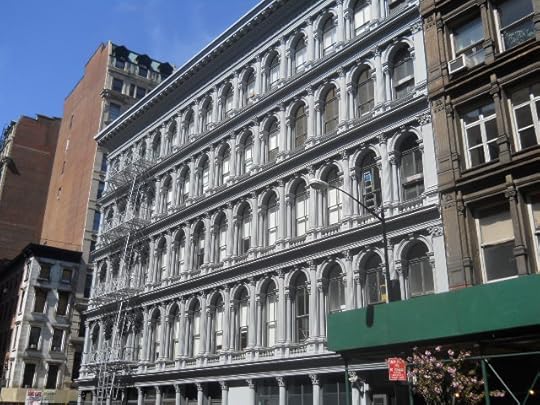 Cast-iron buildings in Soho.
Cast-iron buildings in Soho.Youngking11
Once imported from England, by the 1850s cast-iron products were being made in small foundries right here in Manhattan and Brooklyn, usually near water so supplies could be shipped in and products shipped out by boat. And since these prefabricated products could be assembled on a building site anywhere, they weren’t just used locally, primarily in commercial buildings, but were also exported throughout the country. In New York City the Italianate style dominated in the 1850s, imitating masonry and featuring long rows of round-arched windows that admitted a flood of sunlight into the once somber gas-lit interiors of commercial buildings. Then, by the late 1860s, cast-iron buildings began to show the influence of the French Second Empire style. No. 67 East 11th Street is a mix, being Italianate but originally with a mansard roof; it was typical of its time in being painted beige to imitate stone, the material associated with architectural masterpieces.
Cast iron was also used imaginatively in grandiose structures like Commodore Vanderbilt’s Grand Central Depot. Completed in 1871, its vast enclosed space – the largest on the North American continent – was topped by soaring, filigreed iron arches and glass roofs, making it a tourist attraction rivaling the Capitol in Washington, D.C.
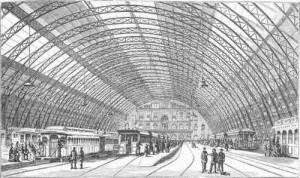 Vanderbilt's Grand Central Depot.
Vanderbilt's Grand Central Depot.What brought an end to the era of cast-iron construction? In the 1870s, fires in Chicago, Boston, and New York showed that cast iron was not fireproof after all; subjected to the intense heat of a large conflagration, it buckled, and when exposed to the cold water of fire hoses, it cracked. In 1885 restrictive revisions were made to the New York building code, rendering cast iron a less attractive option for builders, and after that its use declined. But what really did cast iron in as a construction material was the advent of steel in the mid-1880s.
By the mid-twentieth century cast-iron buildings were underappreciated and in danger of neglect and demolition. Then Margot Gayle, an early advocate of preservation, formed the Friends of Cast Iron Architecture in 1970 and worked hard to document the surviving cast-iron buildings and work for their protection. Brandishing a small magnet to test if simulated stone façades were cast iron, she was charming and persistent, a feisty and determined nuisance. Said another landmarks advocate, “Heaven help the person she gets her teeth into.” Thanks largely to her badgering everyone in and out of government, the SoHo-Cast Iron Historic District was created in 1973, saving that unique concentration of cast-iron structures from the depredations of Robert Moses’s grandiose projects. Since then, more buildings have been protected as individual landmarks or part of other historic districts in Manhattan. When Soho developed into a trendy shopping district, Margot Gayle was less than thrilled, but conceded that it was probably necessary. “That’s the price of getting something saved,” she observed. “There’s got to be money in it for someone.” A tireless crusader with both feet on the ground.
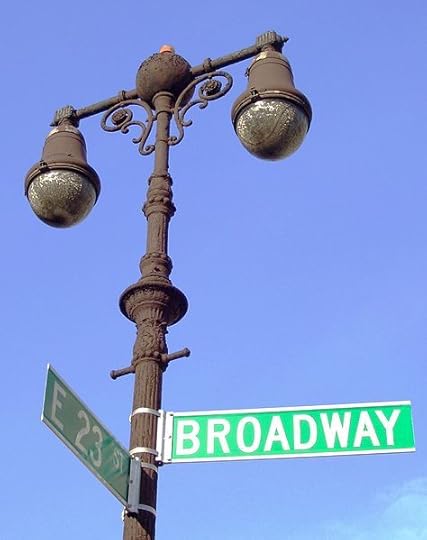 Beyond My Ken One surviving relic of the cast-iron age is the cast-iron electric lamppost, which dates back to the early 1890s. At last report there are 62 of them that have individual landmark status, in addition to others included in landmarked properties or districts. They are characterized by ornamental design, usually some kind of curlicues topping a simple base and shaft. But you have to look for them, and they are scattered throughout the city. The earlier gaslight lampposts are even rarer, but I have seen one at Patchin Place, a gated alleyway on West 10thStreet, across from the Jefferson Market Library. A lamppost in the style of the 1860s, it has no curlicues, but a crossbar beneath the lamp that was used for propping up a lamplighter’s ladder. One of the last gaslight lampposts in the city, since the 1920s it has been powered by electricity.
Beyond My Ken One surviving relic of the cast-iron age is the cast-iron electric lamppost, which dates back to the early 1890s. At last report there are 62 of them that have individual landmark status, in addition to others included in landmarked properties or districts. They are characterized by ornamental design, usually some kind of curlicues topping a simple base and shaft. But you have to look for them, and they are scattered throughout the city. The earlier gaslight lampposts are even rarer, but I have seen one at Patchin Place, a gated alleyway on West 10thStreet, across from the Jefferson Market Library. A lamppost in the style of the 1860s, it has no curlicues, but a crossbar beneath the lamp that was used for propping up a lamplighter’s ladder. One of the last gaslight lampposts in the city, since the 1920s it has been powered by electricity.And now at last we’ll look at terra cotta, which became a popular architectural material in the U.S. in the late nineteenth century. It was sturdy, relatively cheap, and fireproof, and could easily be molded into ornamental detail. Also, it could be made to look like granite or limestone, which were more expensive. Though first introduced in the 1850s, opposition of the stonecutters and masons, who felt threatened by it, delayed its widespread use for decades. The first successful local terra-cotta manufacturer began operations in 1886, and its use then increased. Lightweight terra-cotta ornamentation often adorned the early New York skyscrapers, including the Flatiron Building (1901-03) and the Woolworth Building (1913).
Completed in 1899 by Chicago architect Louis Sullivan, the Bayard-Condict Building at 65 Bleecker Street, between Broadway and Lafayette in Noho, is a prime example of glazed terra-cotta ornamentation. Thirteen stories high, its white terra-cotta façade has ornate floral motifs – clusters of intricate little leaves and curlicues – at the top and bottom, and a highly decorated crown with fifteen-foot-high spread-winged angels under the cornice. A city landmark today, at first glance it is astonishing. The exquisitely rendered detail at the top, barely visible from the ground, reminds one of sculptural detail crowning the great Gothic cathedrals of Europe, fully visible only to God and his angels.
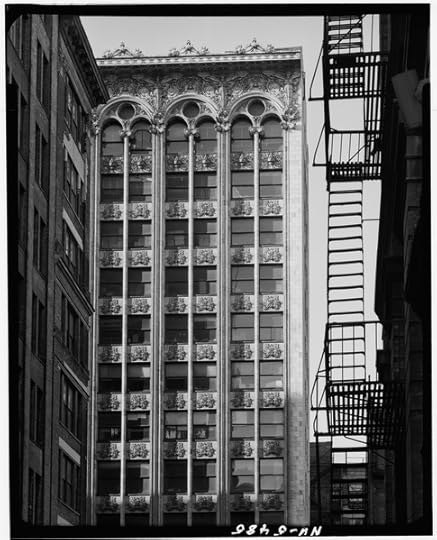 The Bayard-Condict Building.
The Bayard-Condict Building.
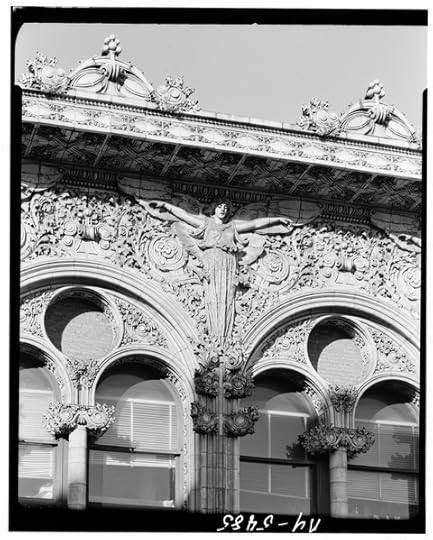 Detail from the top of the Bayard-Condict Building.
Detail from the top of the Bayard-Condict Building.A better view than you'd ever get from the street. The Bayard-Condict Building is unusual in being completely clad in terra cotta, which more often served to adorn the higher reaches of buildings, giving today’s terra-cotta enthusiasts a pain in the neck matching that of warbler watchers in Central Park.
Exactly one week after my cast-iron exploration on East 11th Street, I did the same walk by myself so as to see a building with terra-cotta ornamentation just across Broadway from the Cast Iron Building. As I approached Broadway on 11th Street, there it was straight ahead at 808 Broadway, just north of the Grace Church property. High up on the seven-story brick and stone façade, and best seen from a distance, were Gothic arched windows, scroll panels, and other ornamentation in terra cotta – exquisite detail that I had managed to miss on countless treks down Broadway over the years.
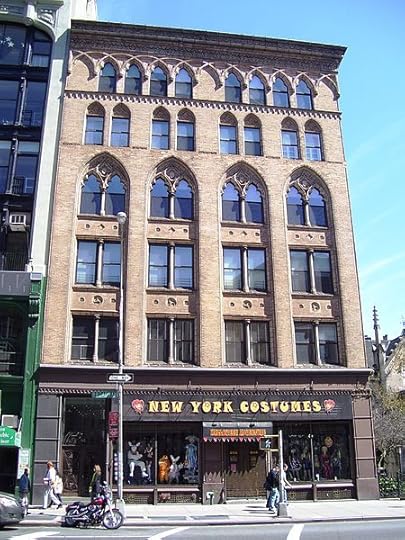 Beyond My Ken
Beyond My KenNow a luxury co-op (what isn’t, these days in the city?), 808 Broadway has surrendered its ground floor to New York Costumes, whose signs in bold lettering announce “Halloween Adventure,” “Visit Our Magic Department,” “No food or drink,” “All sales final,” and “Open.” Here, every day is Halloween, with windows displaying strange creatures in fantastic outfits, as for instance a ghoulish character in a blue Napoleonic uniform with gold epaulets, and a hideously grinning skeleton in a fluffy white bridal outfit with glinting jewelry. What passerby, seeing such a clutch of spooks, would think to look high up to savor the subtler, more delicate effects of terra cotta? But before I draw a distinction between the Halloween-obsessed hoi polloi and the cognoscenti enamored of terra cotta, I remind myself that for decades I was one of the hoi polloi, though at least I was aware of the Gothic jewel that is Grace Church.
Some other examples of decorative terra cotta:
· Brightly colored ornamentation on the Grosvenor, one of the first Fifth Avenue skyscrapers, at 39 Fifth Avenue, built in 1922.· Similar decoration on 32 Washington Square West, as well as rondels (circular panels) featuring the heads of George and Martha Washington, 1925.· Banding and detailing on the Judson Memorial Church at 54-57 Washington Square South, which dates from 1888-93; the church itself is Lombardo-Romanesque in style and made with long, thin red bricks.· Elaborate polychrome ornamentation, showing a rising sun flanked by winged griffins, high up on the Fred F. French Building, a 38-story Art Deco skyscraper at Fifth Avenue and 45th Street, 1927.· Green glaze set against the chocolate brickwork of the Church House of the First Presbyterian Church at 12 West 12thStreet, a modern example of terra-cotta ornament dating from 1960.
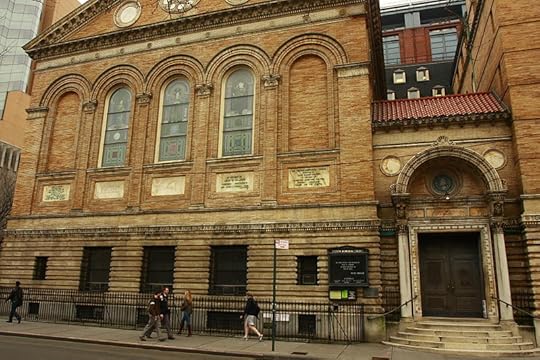 Judson Memorial Church on Washington Square South.
Judson Memorial Church on Washington Square South.Ton
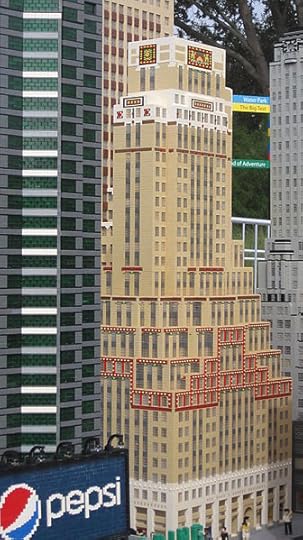 The Fred F. French Building, with polychrome terra cotta
The Fred F. French Building, with polychrome terra cotta at the very top. But the "pepsi" probably isn't terra cotta.
It1224 Like architectural cast iron, terra cotta had its moment of glory in New York and then faded from the scene. Fatal to it was the new International Style of architecture introduced to this country in an exhibition at the Museum of Modern Art in 1932. American architects were so taken with the new style, with its emphasis on simplified geometry and a lack of ornamentation, that they abandoned the exuberant ornamentation associated with terra cotta. Clean lines and flat surfaces were now the rule; spread-winged angels and foliage and curlicues were out. Throughout the rest of the century glass and steel geometry triumphed in the soaring high-rises that mark the city today.
But that was not the end of terra cotta. Just as the decline of cast-iron architecture led in time to renewed interest in it and the founding of the Friends of Cast Iron Architecture, so the decline in terra-cotta ornamentation and subsequent neglect of it led a group of preservationists in California in 1981 to found the Friends of Terra Cotta, a nonprofit dedicated to the promotion and preservation of terra cotta as an architectural material. Today Susan Tunick, a ceramics artist living and working in New York, is a national spokesperson for the preservation of architectural terra cotta, and the author of Terra Cotta Skyline: New York’s Architectural Ornament (1997). She is also the president of the New York City branch of the Friends of Terra Cotta and gives walking tours revealing the terra-cotta treasures of the city.
To judge by cast iron and terra cotta, architectural fads go through an eight-phase cycle:
· Novelty· Acceptance· Popularity· Fatigue· Rejection· Neglect· Revival· Preservation
As a subject, New York City is inexhaustible. Just as I have discovered architectural cast iron and terra cotta, having in my ignorance walked by examples of each not for years but for decades, I hope to discover more aspects of the city, architectural or otherwise, on future walks both virtual and real. I invite everyone to do the same. If you live in the city or visit it, don’t go too fast. Slow down, open your eyes, and look; there are marvels all around you just waiting to be discovered.
Coming soon: Addictions: those things we cling to obsessively, simply cannot do without, with a glance at a man who loved excitement, a man who loved his boats and the river until they killed him, a man who loved rushing to fires, and an angel in a top hat. And then: catastrophes.
© 2015 Clifford Browder
Published on June 14, 2015 04:48
June 7, 2015
183. Landmarks: Saving the Old from the New
Nineteenth-century New York was too drunk on the idea of Progress (usually capitalized) to worry about preserving anything. It was Young America, it was Go Ahead, breaking free from the old and embracing wholeheartedly the new. Obsessed with Bigger, Better, Faster, it didn’t need to grasp the ideas of the marquis de Condorcet, the eighteenth-century philosophe whose buoyant optimism saw humanity as marching ever onward and upward; indeed, New Yorkers almost daily saw proof of Progress right there before their eyes. Almost daily, as the city’s growth exploded, they learned of a cornerstone laying, a bridge opening, a ship launching, or the laying out of yet another street, events marked with appropriate ceremonies, speeches, and cheers, and sometimes even the booming of cannon. One amazing change after another transformed their lives: the steamboat, the railroad, indoor plumbing, the telegraph, the elevator, electricity, the telephone, and by the end of the century, the automobile. They were fiercely convinced that their city was the locomotive pulling the rest of the nation faster and faster into the future.
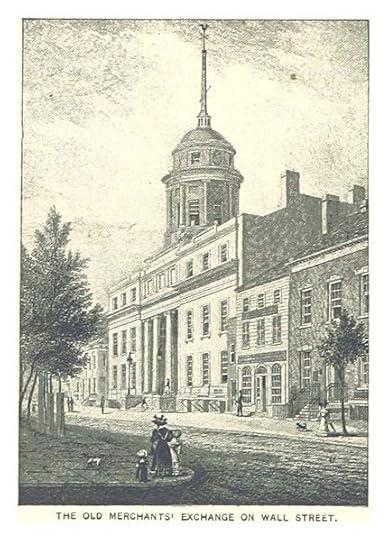 Spreading northward on the narrow, cigar-shaped island that was Manhattan, the city was in constant flux, tearing down and building up. In the name of Progress old cemeteries were dug up and their bones scattered, so the property could be developed, and pious congregations joined the general migration northward, their abandoned churches becoming warehouses, stables, markets, tenements, and even, alas, houses of prostitution. And when the Great Fire of 1835 destroyed the whole Wall Street area, including the Merchants’ Exchange, an elegant marble-faced neoclassical building topped by a soaring rotunda, the fever to rebuild was such that work immediately began on lots still warm from the fire. On the site of the old Merchants’ Exchange, where everything from steamboats to whale oil and molasses had been sold, a new exchange rose in Greek Revival style, even more massive and impressive, fronted by twelve soaring marble columns and topped by a dome. As for the loss in the fire of the last old Dutch houses in Manhattan, not a tear was shed for those hopelessly quaint, hopelessly old-fogey one- or two-story brick structures, their stepped gable ends facing the street. The very notion of landmark preservation would have struck the citizens as needless, alien, and outlandish; it would have to wait a century or more.
Spreading northward on the narrow, cigar-shaped island that was Manhattan, the city was in constant flux, tearing down and building up. In the name of Progress old cemeteries were dug up and their bones scattered, so the property could be developed, and pious congregations joined the general migration northward, their abandoned churches becoming warehouses, stables, markets, tenements, and even, alas, houses of prostitution. And when the Great Fire of 1835 destroyed the whole Wall Street area, including the Merchants’ Exchange, an elegant marble-faced neoclassical building topped by a soaring rotunda, the fever to rebuild was such that work immediately began on lots still warm from the fire. On the site of the old Merchants’ Exchange, where everything from steamboats to whale oil and molasses had been sold, a new exchange rose in Greek Revival style, even more massive and impressive, fronted by twelve soaring marble columns and topped by a dome. As for the loss in the fire of the last old Dutch houses in Manhattan, not a tear was shed for those hopelessly quaint, hopelessly old-fogey one- or two-story brick structures, their stepped gable ends facing the street. The very notion of landmark preservation would have struck the citizens as needless, alien, and outlandish; it would have to wait a century or more.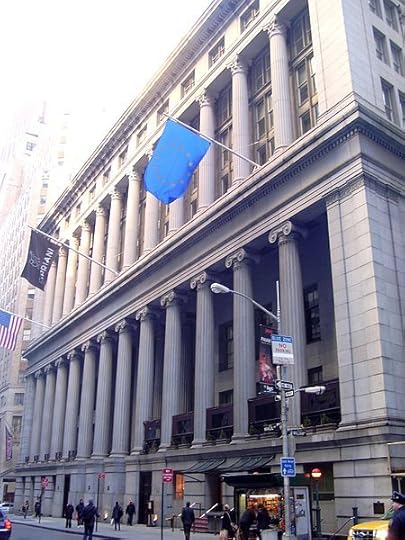
The new Merchant's Exchange (built 1836-41) as it exists at 55 Wall Street today. After serving as the U.S. Custom House 1862-1907, it was acquired by the National City Bank and radically transformed: the dome was eliminated, and four floors and a second colonnade were added. Today it is occupied by an upscale restaurant and the luxury housing of Cipriani Club Residences.
Beyond My Ken
The cult of Progress continued well into the twentieth century and took on a very American air with the appearance in the 1920s and 1930s of that distinctly American phenomenon, the skyscraper. The Chrysler Building and the Empire State Building were hailed as New World wonders, and Rockefeller Center, built in the very depths of the Depression, seemed dazzlingly grandiose and daring. The Art Deco style characterizing all three was a sharp break with the Beaux Arts style of Grand Central Station and the New York Public Library, and with anything that smacked of the Old World. Creating such marvels, New York was still the locomotive hauling the rest of the nation into the world of tomorrow.
The World of Tomorrow, indeed, was the theme of the New York World’s Fair of 1939, and industrial designer Norman Bel Geddes’ popular exhibit Futurama presented a model of the world twenty years into the future, with vast suburbs, segregated highways allowing a free flow of traffic and pedestrians, and an 18-minute ride on a conveyor system giving spectators a simulated aerial view of the panorama.
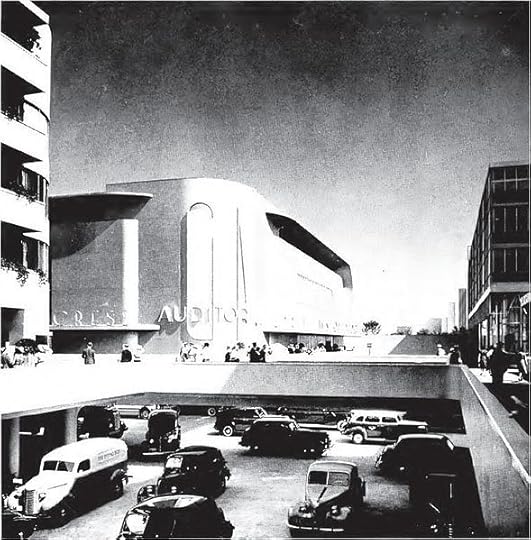 The Futurama exhibit, showing a street intersection in the City of Tomorrow. I leave it to
The Futurama exhibit, showing a street intersection in the City of Tomorrow. I leave it toresidents and visitors to decide if Bel Geddes' vision has been realized in New York.
 Poster for the Chicago World's Fair.
Poster for the Chicago World's Fair.I never saw the New York World’s Fair, but at a very tender age was taken to A Century of Progress, the 1933 world’s fair celebrating the centennial of the city of Chicago, whose ill-timed theme contrasted sharply with the woes of the Depression. But not even a depression could squelch the cult of Progress.
The prime New York developer of the twentieth century was Robert Moses (1888-1981), who pursued public works – and pursued them ruthlessly – under six New York State governors and five New York City mayors. (See post #78, The Hercules of Parks.) In the city he transformed Pelham Bay Park and Riverside Park, completed the Triborough Bridge, built the West Side Highway, and created Lincoln Center, the United Nations Headquarters, Co-op City, Stuyvesant Town and Peter Cooper Village, and the New York Coliseum. And that is only a partial list of his accomplishments. New York City has always dreamed big, and Moses dreamed bigger than anyone. But he wasn’t just a dreamer, he built. And to build his grandiose projects he flattered, schemed, lied, and pressured, and so became, in the words of his biographer, the biggest builder the world had seen since the pharaohs of ancient Egypt. But to realize his dreams, he thought nothing of invading old neighborhoods, tearing them apart, destroying them, and displacing thousands of residents for the sake of the New.
In 1952 Moses announced a plan to have two streets flank the Washington Square Arch and run on south through Washington Square Park, obliterating the fountain. This assault on a beloved green space in Greenwich Village aroused the fierce opposition of local residents, including former First Lady Eleanor Roosevelt, and under the leadership of urban activist Jane Jacobs they launched a campaign to save the park and ban all vehicles from it. A long and complicated legal fight followed with many ups and downs, but David finally triumphed over Goliath: in 1963 the park was saved and all vehicles were banned from it forever.
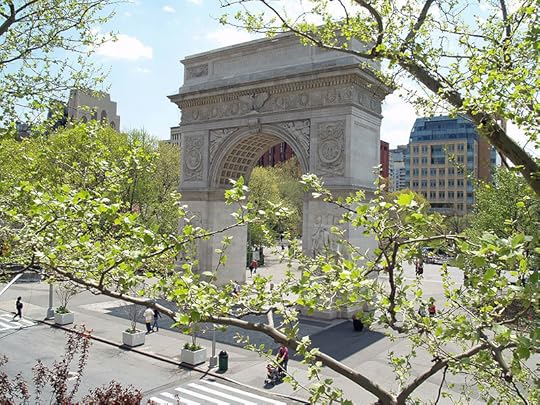 The Washington Square Arch today. No streets flanking the arch and no vehicles.
The Washington Square Arch today. No streets flanking the arch and no vehicles.David Shankbone
This and a few other rare defeats of Robert Moses signaled, by the 1960s, a significant change in the attitude of New Yorkers toward grandiose projects created at the expense of small neighborhoods. Especially influential was Jane Jacobs’s book The Death and Life of Great American Cities (1961), which denounced urban planning as destructive of organic city neighborhoods while replacing them with sterile urban spaces. But even as Jacobs and her fellow Villagers fought off the attack by Moses, developers were demolishing old buildings in the Village and replacing them with big new apartment buildings with fancy lobbies and uniformed doormen, and names that oozed high culture: the Van Gogh on Horatio Street, and the Cézanne and the Rembrandt on Jane Street, the very street where I was then living. Passing these unlovely but well-scrubbed behemoths as I often did, I wondered when a Puvis de Chavannes or a Whistler might appear, or perhaps a Bouguereau, though this last would be ill-advised, since Americans might pronounce it “Bugger.” Only with the creation of the Greenwich Village Historic District in 1969 did these depredations stop, and even then the district’s borders zigged and zagged capriciously, stopping just south of 14th Street on the north and short of the Hudson River on the west, while reaching only to Washington Square on the south and east. The heart of the Village was preserved, but not all of it.
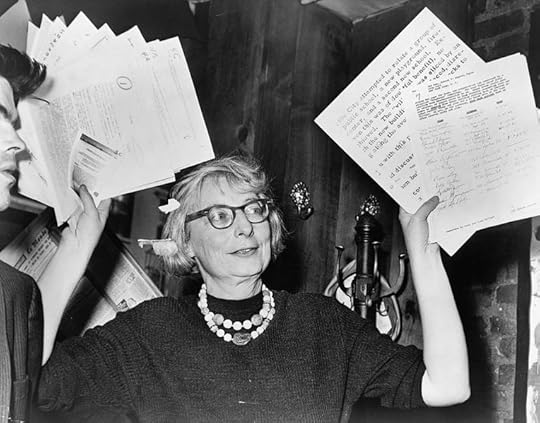 Jane Jacobs, chair of the Committee to Save the West Village, brandishing supporting documents
Jane Jacobs, chair of the Committee to Save the West Village, brandishing supporting documentsat a press conference in 1962. It takes a lot of organized action to get anything done in this city,
and she knew it.
What finally triggered a widespread movement to protect city landmarks was the demolition in 1963 of the old Penn Station, a 1910 Beaux Arts masterpiece built by the celebrated firm of McKim, Mead & White. The pink granite façade on Seventh Avenue between 31st and 33rd Streets featured a colonnade of Tuscan columns, and the high-vaulted waiting room inside, patterned on the Baths of Caracalla in ancient Rome, was the largest enclosed space in the city and one of the largest in the world. Adjoining the waiting room was a concourse of glass and wrought iron, equally vast and imposing. Photographs of the exterior and interior give breathtaking views, and aerial photographs of the ensemble, which occupied two whole city blocks, are awesome.
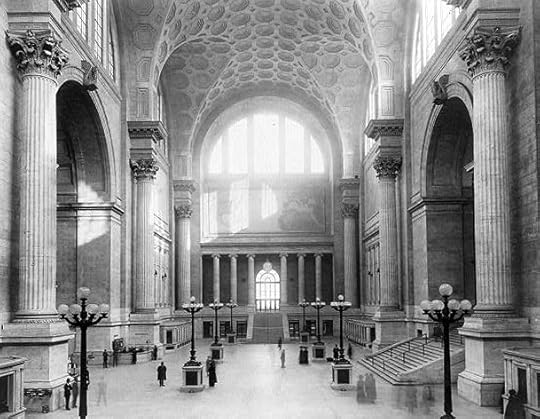 What we lost: the main waiting room.
What we lost: the main waiting room. What we lost: the concourse.
What we lost: the concourse.Demolished? one asks in wonderment. A monument as magnificent as it was colossal -- destroyed? How could this be? There were protests at the time, but the Pennsylvania Railroad, faced with dwindling revenues and the burdensome expense of maintaining the existing structure, had sold the air rights to a developer who planned to build a new Madison Square Garden on the site. Of course there would be a new Penn Station, and air-conditioned. Much smaller in size, it was built below street level – the cramped mediocrity of a station that travelers are stuck with today. Comparing the old and new stations, an architectural historian remarked, “One entered the station like a god; one scuttles in now like a rat.” Expedience and cost effectiveness had triumphed over magnificence, and with a touch of irony as well: Stanford White, the famous architect whose firm had created the old Penn Station, had been shot to death in an earlier Madison Square Garden that he had also built; now the construction of yet another Madison Square Garden, the fourth of that name, was the pretext for demolishing his masterpiece.
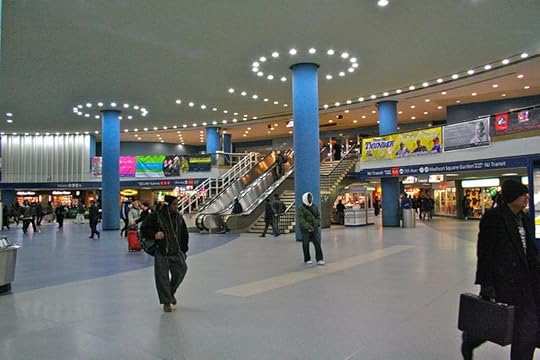 What we got: the Penn Station concourse today. Glitzy, flat-ceilinged, uninspired and uninspiring.
What we got: the Penn Station concourse today. Glitzy, flat-ceilinged, uninspired and uninspiring.Alan Turkus The full significance of the city’s loss registered with me only when I saw a New York Times photograph showing some of the station’s huge columns lying abandoned in a field in New Jersey, soon to be relegated to a Meadowlands landfill. One wanted to denounce the railroad management and the developer, but weren’t we all to some extent guilty? Hurrying through those remarkable vaulted spaces, we were too preoccupied with catching our train to pause and absorb the splendor all around us.
Belatedly, a firestorm of protest led to the creation, in 1965, of the New York City Landmarks Preservation Commission, an agency charged with protecting all buildings and districts deemed architecturally and historically significant. The Real Estate Board of New York vigorously opposed the commission’s creation, but in time came to realize that the commission’s work could actually increase a property’s value. By law the commission consists of eleven commissioners appointed by the mayor and must include at least three architects, a historian, a city planner or landscape architect, a real estate agent or developer, and at least one resident of each of the city’s five boroughs. To be declared a landmark, a building must be at least thirty years old. A property owner can continue to use a landmarked building, but cannot demolish or alter it without the commission’s approval. As a result, many an old building stands with its façade intact, though the interior has been gutted and renovated.
As of 2014, more than 31,000 properties have been designated landmarks, most of them in 110 historic districts and 20 historic district extensions in all five boroughs. Historic districts include Greenwich Village, the Meatpacking District, SoHo, Wall Street, and South Street Seaport in Manhattan; Brooklyn Heights and Park Slope in Brooklyn; Grand Concourse in the Bronx; Jackson Heights in Queens; and Seaview Hospital in Staten Island. One of the commission’s greatest accomplishments was the preservation of Grand Central Terminal, when Penn Central tried to alter the structure and top it with an office tower. But the commission’s decisions are often controversial and far from unanimous, and they can be appealed.
Recently the mere threat of the commission’s disapproval forced the Frick Collection to abandon its plan to demolish a garden beloved of New Yorkers on East 70th Street so the museum could build an unlovely six-story addition. (See post #142 on MOMA and the Frick, August 31, 2014.) The garden, dating from 1977, is the creation of the distinguished British landscape artist Russell Page and his only completed work in the city. Though only a “viewing garden,” meaning that the public can view it from the fence but not enter it, it is a precious bit of greenery in a city starved for greenery, with a rectangular pool surrounded by gravel paths and boxwood hedges. Surprised by the intensity of opposition to their expansion plan by a coalition of architects, landscape designers, and preservationists, Frick officials finally yielded and agreed to explore alternative plans. The opposition, after all, is motivated by a deep love for the Frick as it is.
Encouraging as the creation of the Landmarks Preservation Commission was, concerned citizens wanted an organization focused specifically on New York City. So in 1973 a small group of architects, lawyers, planners, writers, and preservationists joined together to found the New York Landmarks Conservancy, which works to preserve and reuse the city’s architecturally significant buildings. The conservancy modeled its work on the Nature Conservancy’s efforts to acquire, hold, and manage endangered lands. Financed mostly by donations from the public, the Landmarks Conservancy works closely with owners and community groups in all five boroughs to safeguard landmarked buildings, and campaigns to get landmark status for buildings not yet designated as such. It even makes grants and low-interest loans to help finance renovation and restoration projects throughout the city.
The conservancy insists that it is not opposed to new development, provided it doesn’t endanger existing structures that merit preservation. For example, many Upper East Side “curtain wall” office buildings – those big glass boxes built in the 1960s and 1970s -- it considers culturally insignificant and ripe for replacement, which of course means demolition. While my personal opinion weighs lightly in such matters, I’ll chime in anyway: all that glass bores me; good riddance. Though one wonders what will replace it: wonders, or more monstrosities? (There are a few other architectural horrors that I could easily part with – the Maritime Union building on Seventh Avenue, for instance, and the New School’s looming oddity with zigzag windows at Fifth Avenue and 14th Street -- but no matter.)
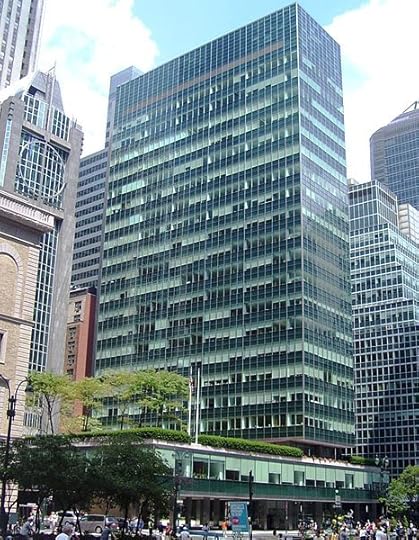 The Lever House at 390 Park Avenue (1950-52). One that I and the
The Lever House at 390 Park Avenue (1950-52). One that I and theLandmarks Conservancy could do without.
Beyond My Ken
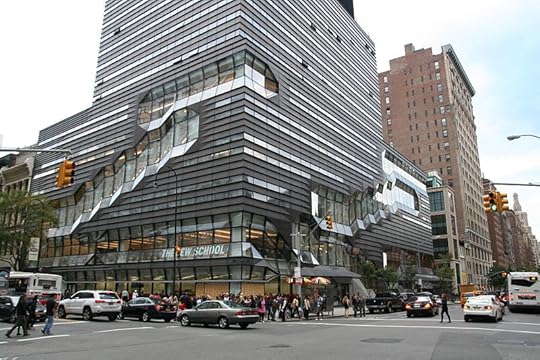
The New School University Center at Fifth Avenue and 14th Street: another that I could do without.
MusikAnimal
Just as some concerned citizens felt the need of an organization focused exclusively on New York City, so another bunch of concerned citizens (of whom New York has an endless supply) felt the need of an organization focused exclusively on Greenwich Village. So in 1970 these local residents founded the Greenwich Village Society for Historic Preservation (GVSHP) to protect the cultural and architectural heritage of the Village and adjoining neighborhoods. (For more on GVSHP, see post #181 on nonprofits.) The Village had been declared a historic district in 1969, but many sites deserving preservation lay outside the district’s boundaries.
Thanks to the society’s efforts, the Gansevoort Historic District was created in 2003, and the South Village Historic District in 2013. And just as Robert Moses was the bête noire of preservationists in the 1960s, so New York University, with its perennial plans for expansion, has become the bugbear of GVSHP. In 2014 the society and other plaintiffs won a case against the university’s massive 20-year expansion plan, only to see the ruling overturned on appeal, following which the plaintiffs in turn appealed to the state’s highest court. Preserving old buildings is a constant battle with many antagonists, the Real Estate Board of New York prominent among them, and preservation doesn’t always win.
And just as some concerned citizens felt the need of an organization focused exclusively on Greenwich Village, more of these good folk have joined together to maintain city parks: the Central Park Conservancy, the Brooklyn Bridge Park Conservancy, the Battery Conservancy, the Gracie Mansion Conservancy, the Staten Island Greenbelt Conservancy, the Jackson Square Alliance, the Washington Square Park Conservancy, and many more. Rare indeed is the park or historical site in this city that doesn’t have a clutch of do-gooders organized in a nonprofit to care for it. Not that the Real Estate Board of New York, for all its protests and complaints, is suffering; to judge by the current real estate boom, it’s doing just fine (see post #178). And NYU isn’t about to disappear. But grandiose projects like the ones that Robert Moses sponsored are probably a thing of the past. In the constant battle between the old and the new, the old appears to be holding its own. History buff that I am, I’m glad.
Tax breaks for the lucky: According to a magazine I was leafing through in a doctor’s office recently, various states offer tax exemptions to select citizens or on certain items. For instance:
· Pumpkins, as long as you promise to eat them (Pennsylvania, New Jersey, Iowa).· Circus tickets, but not trips to a haunted house (New York).· Adult diapers (Connecticut).· Fortune tellers (Louisiana).· Citizens over 100 (New Mexico).
Not having verified this information, I would welcome comments or corrections. Also, information about additional interesting tax breaks.
Improve your mind and body: The same magazine also listed a host of self-improvement courses offered at various sites throughout the country. For example:
· Alligator wrestling.· Essential witchcraft.· Trapeze skills.· Cannabis cultivation.· Alchemy (ability to turn base metals into gold not guaranteed).
Regrettably, I can’t supply the addresses, but diligent online research will give you all you need to know.
Coming soon: Cast Iron and Terra Cotta: Adventures on 11thStreet.
© 2015 Clifford Browder
Published on June 07, 2015 05:44
May 31, 2015
182. The Mystery and History of Place Names
In a recent post about walking in New York I mentioned Gansevoort Street, the site of the new Whitney Museum of American Art, and Horatio Street, where I discovered a whole row of well-preserved Greek Revival houses, two of them dating from 1836. But what about those names, “Gansevoort” and “Horatio”? Where did they come from? “Gansevoort” sounded Dutch to me. “Horatio” meant nothing at all, unless a soldier of ancient Rome of whom I had a vague recollection – a super macho type who alone defended a bridge against a whole army of enemies -- that seemed irrelevant. So I started scratching about and came up with a few stray facts.
Gansevoort Street got its name in 1837 from Fort Gansevoort, a fort built at the Hudson River end of the street between 1808 and 1812. So where did the fort, long since demolished, get its name from? From Peter Gansevoort (1749-1812), a colonel in the Continental Army during the Revolution, who is best known for successfully defending Fort Stanwix (near today’s Rome, New York) against a British attack in 1777. And yes, he was of Dutch extraction, in fact, from an aristocratic Dutch family in Albany.
 Horatio Gates in 1782, looking quite
Horatio Gates in 1782, looking quitecomposed two years after his famous ride. And Horatio Street? It too was named after a Revolutionary War figure, General Horatio Gates, a retired British soldier who at the outbreak of hostilities volunteered his services to George Washington. Having received credit for the British defeat at the battle of Saratoga in 1777, even though Benedict Arnold and others did most of the fighting, Gates suffered a disastrous defeat at the battle of Camden in South Carolina in 1780. Following this debacle he then heroically covered 170 miles on horseback in a strategic retreat. Though controversial, Gates was evidently still esteemed enough to have a street in Manhattan named for him, though why his first name was used isn’t clear. (There were lots of streets to name or rename in the 1790s, and only so many Revolutionary War heroes.)
I’ve always been a history buff and nosey, and researching these priceless facts determined me to do a post onNew York City place names. So first of all how about the five boroughs? Here are the probable origins:
· Manhattan comes from Mannahatta, which in the language of the Lenape, a native American people once living in the lower Hudson Valley and adjacent regions, means “island of many hills.”· The Bronx derives its name from Jonas Bronck, a Swedish emigrant who came to the Dutch colony of New Netherland in 1639, acquired land, and became the first settler in what is now the Bronx. The area became known as Bronck’s land, and a river there became known as Bronck’s River and in time gave its name to the borough.· Queens was named for Queen Catherine of Braganza, the wife of Charles II of England, during whose reign the British grabbed New Amsterdam from the Dutch and renamed it New York. Queen Catherine must have been a patient woman to have tolerated her husband’s many dalliances.· Brooklyn derived its name from the Dutch word breukelen, meaning “broken land.” A Dutch village in the area was named Breukelen, after a town in Holland, and the English Anglicized this as “Brooklyn.”· Staten Island was discovered in 1609 by Henry Hudson, who named it Staaten Eylandt after the Staten-Generaal, the Dutch parliament that had financed his voyage to the New World.
Now let’s have a look at some other names of places, and a glance too at their history.
The Battery, the park at the southern tip of Manhattan, gets its name from the battery of cannon that the Dutch once positioned there to defend New Amsterdam. But when a British fleet showed up in 1664, the good burghers were hopelessly outnumbered and surrendered without firing a shot. After the thirteen colonies won their independence from Great Britain, the old fort was demolished, but in the early 1800s, in anticipation of another war with Great Britain, a circular fort was built on the site. In time the new fort was named Fort Clinton after Governor De Witt Clinton, but no British attack materialized, so once again the cannon remained silent. Subsequently renamed Castle Garden, the fort was transformed into a concert hall where the Swedish coloratura Jenny Lind made her sensational American debut in 1850. From 1855 to 1890 the building served as the federal immigration center of the East Coast, until superseded by Ellis Island. Next, from 1896 to 1941 the structure became the New York Aquarium. Restored to its original fortification appearance, today Castle Clinton – yes, the name too has been restored -- is a national monument housing a database of information about immigrants who came to this country in the nineteenth century.
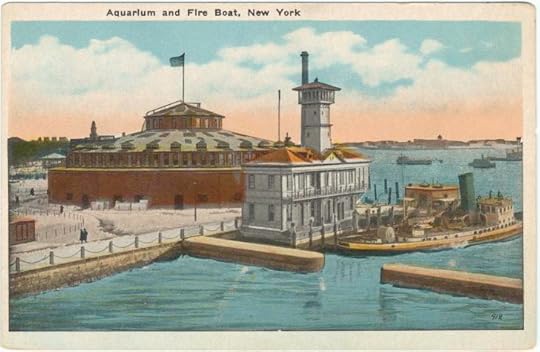 The circular fort housing the New York Aquarium, much beloved in its time by New Yorkers.
The circular fort housing the New York Aquarium, much beloved in its time by New Yorkers.Governors Island, a 172-acre island in the harbor off the southern tip of Manhattan, was called Nut Island by the Lenape people, because hickory, oak, and chestnut trees grew there, a name that became Noten Eylant among the Dutch, and Nutten Island when the British took over. But then the colonial assembly of New York reserved the island for the exclusive use of the royal governors, who employed it at one time or another as a goat farm, a tobacco plantation, and a quarantine station for arriving immigrants. Officially named Governors Island in 1784 (minus an apostrophe, please note), it served as a U.S. military post until 1966, and as a Coast Guard installation from 1966 to 1996. For me and for most New Yorkers, who viewed it from the Battery or the Staten Island ferry, it was a bit of a mystery, so near and yet so far, and so unknown.
Then, in 2003, the federal government transferred most of the island to the city and state of New York for the sum of one dollar, on condition that the site be used for public benefit. To acquire such a big chunk of land right in the heart of the city – and at such a bargain price – was a rare bit of good luck that at once unleashed a storm of debate about what to do with it. Nothing ever happens in New York without heated arguments and controversy, and plenty of both ensued.
 A map of Governors Island today. Castle Williams is at the very top.
A map of Governors Island today. Castle Williams is at the very top.Now open to the public on summer weekends, the island is being developed to include parkland, an organic farm, a high school, artist studios, and a New York University campus. Still standing is Castle Williams, a circular fort built in 1807-1811 under the supervision of Lieutenant-Colonel Jonathan Williams, chief engineer of the Corps of Engineers, to protect the city from a British naval attack that never came. Looming silently on the northwest point of the island, the fort’s four tiers of casements for cannon are clearly visible from the passing Staten Island ferries. Having narrowly escaped demolition in the past, the renovated fort is now administered by the National Park Service and retains the name Castle Williams. And while its cannon, like those of its twin, Castle Garden, never engaged an enemy in wartime, they weren’t a total waste of taxpayers’ money, since word of them and other fortifications surely reached the blockading British fleet and discouraged any plans for attack. (The Brits visited New Orleans instead.)
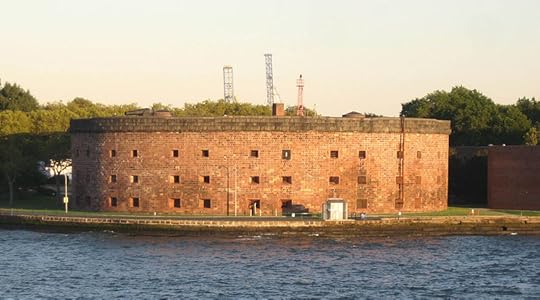 Castle Williams today.
Castle Williams today. Bowling Green, a small teardrop-shaped park just up a short distance on Broadway from the Battery, was used in Dutch times as a cattle market and parade ground. Under British rule it continued as a cattle and grain market, but in 1733 the Common Council leased the site to three neighboring landlords to create a bowling green and park. From then on, players rolled balls over its smooth green lawn in the time-honored game of bowls, which dates back to the thirteenth century. In 1770 the British rulers erected on the site a 4,000-pound gilded lead statue of King George the Third, who was shown heroically in Roman garb, bigger than life, astride a prancing steed. As tension grew between the colonists and their rulers, the statue became a magnet for protests, so a protective cast-iron fence was built around it to shield it from vandalism.
In 1776, soon after the passage of the Declaration of Independence, the local Sons of Liberty, some of them not quite sober, rushed down Broadway to Bowling Green and toppled the statue – a symbolic gesture that George Washington, being moderate by nature, disapproved of, but that has often been commemorated, albeit inaccurstely, in works of art. Minus the head, the lead statue was then broken up and the pieces shipped off to a foundry in Connecticut to be made into bullets for Washington’s troops. In grim anticipation of the French Revolution of 1789, patriots planned to parade the statue’s head around the city on a pike, but Loyalists recovered it and sent it off to England. The fence survived and still rings the park, minus the ornamental royal crowns topping each post, which the patriots sawed off. What then became of those ornaments is not known. The head turned up a year later in England in the home of Lord Charles Townshend, a devoted servant and crony of His Majesty, but it has not been seen since.
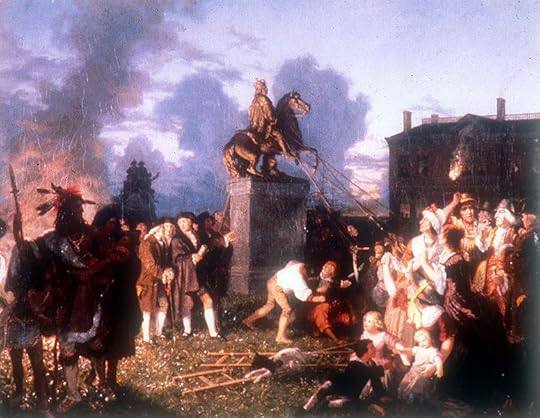 Johannes Adam Simon Oertel, Pulling Down the Statue of King george III, ca. 1859. A romanticized
Johannes Adam Simon Oertel, Pulling Down the Statue of King george III, ca. 1859. A romanticizeddepiction of the event, with many errors. No women and children were present, and no Indians.
And the king was actually shown in Roman garb.
Today, instead of a heroic equestrian statue, the park is graced by a splashing fountain and, at the tapering end of the teardrop, by another bigger-than-life art work, Arturo Di Modica’s Charging Bull. The bronze sculpture, showing a bull on its haunches, head lowered and ready to charge, was transferred there in 1989 after the police removed it from Wall Street, where the artist had installed it without permission. Having heard it hailed as a symbol of the city and Wall Street, tourists flock.
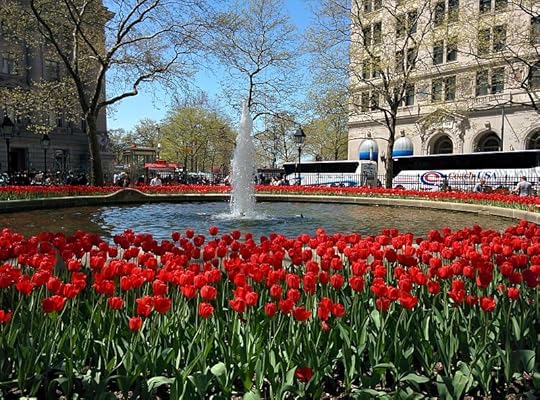 Bowling Green fountain today.
Bowling Green fountain today.MusikAnimal
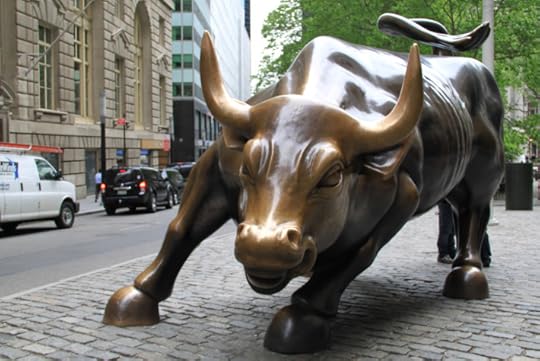
(Bigger-than-life statues of tyrants seem to beg to be toppled, and the toppling is amply photographed and televised as it happens. In 2003 a giant statue of Saddam Hussein was toppled in Baghdad ostensibly by Iraqis, but the whole affair was a PR stunt staged for television by the U.S.; Iraqis were shown cheering, but a U.S. armored vehicle actually did the tugging. In 2013 citizens of Ukraine tore down a huge statue of Lenin in Ukraine’s capital, Kiev, and in 2014 they tore down another in Ukraine’s second largest city, Kharkiv. And in 1991 Albanians toppled a statue of the late Communist dictator Enver Hoxha in Tirana. And so on, and so on. China and North Korea, take heed.)
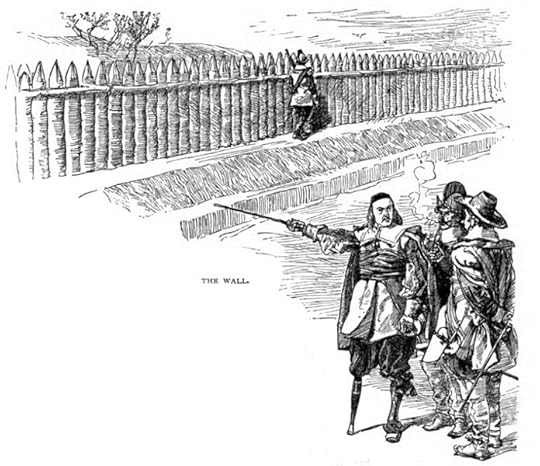 An artist's rendering of the wall in the time of Peter Stuyvesant, who is shown in the foreground.
An artist's rendering of the wall in the time of Peter Stuyvesant, who is shown in the foreground.And street names? Wall Street was laid out on the site of a twelve-foot wall that the Dutch built in the seventeenth century to shield New Amsterdam from possible attacks by the native peoples, who had plenty of reasons to attack. The British tore down the wall in 1699, but the name “Wall Street” was already in use, designating a road that ran across Manhattan next to the wall. Merchants and traders began gathering there to buy and sell stocks and bonds, and in 1711 the Common Council made Wall Street the city’s first official slave market for the sale and rental of enslaved Africans and Indians. In eighteenth-century New York one resident in five was an African American slave, and the city’s slave market, at Wall and Pearl Streets on what was then the East River waterfront, was second in size only to the one in Charleston, South Carolina, and functioned until 1762. The city profited, since for every transaction in the market – every time a human being was bought or sold – the city collected a tax. Only in April of this year did New York City finally agree to acknowledge the inconvenient fact of the slave market’s existence by placing a historical marker near the site of the market.
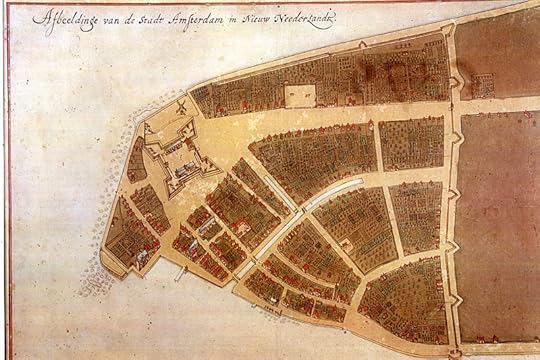 The Castello plan of New Amsterdam, 1660. The wall is indicated on the far right. On the left
The Castello plan of New Amsterdam, 1660. The wall is indicated on the far right. On the leftis the Dutch fort, at the foot of the broad road that became Broadway.
Canal Street, a major crosstown artery in Lower Manhattan, occupies the site of a canal that was dug in the early nineteenth century to drain the contaminated waters of the Collect Pond into the Hudson River. Fed by an underground spring, the Collect Pond had once been the city’s main source of water, but in the eighteenth century the pond was polluted by tanneries, breweries, and slaughterhouses that used the water and dumped waste into it. The pond was filled in in 1811, and Canal Street was completed by 1820, following the path of the canal, but the ground in the area was marshy and foul-smelling, causing middle- and upper-class residents to leave, and the notorious slum known as the Five Points to develop. In the late nineteenth century the city bought up most of the Five Points tenements and condemned them, and in this way eliminated the slum. Today Canal Street is a busy commercial district with Chinese jewelry stores, outdoor vendors, and banks, and open storefronts and unlicensed peddlers selling knickknacks and souvenirs, and counterfeit DVDs, watches, sunglasses, perfumes, and designer handbags at low prices.
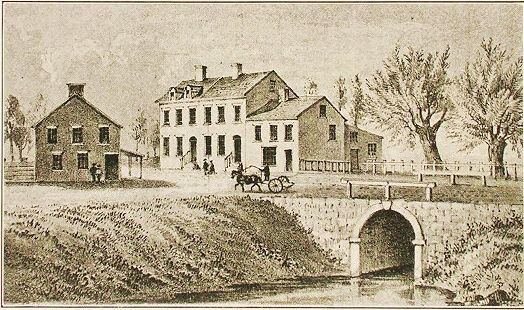 The Broadway bridge over the canal, 1811.
The Broadway bridge over the canal, 1811.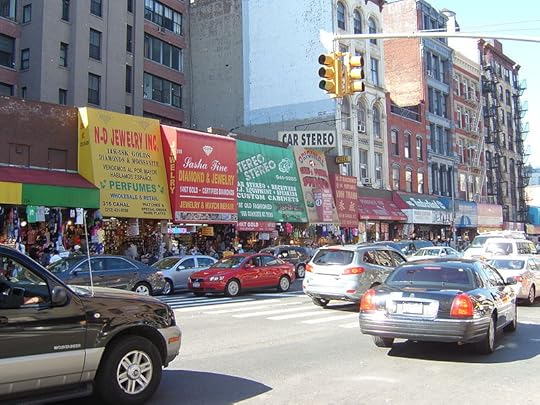 Canal Street today.
Canal Street today.Kamel15
Bleecker Street, which runs right by the building I live in, gets its name from the Bleecker family, who owned a farm in the area and deeded land to the city in 1808. In the 1830s and 1840s the street was lined with handsome Greek Revival houses and rivaled Bond Street for elegance and affluence, until dentists’ offices and other evidence of neighborhood decline appeared, and the wealthy residents, fearing the taint of commerce and the lower orders, moved farther uptown. By the 1870s the old houses had become boarding houses, brothels, and cheap restaurants, and the low rents of the area began attracting bohemians.
In the late nineteenth and early twentieth century Italian immigrants arrived in the city in large numbers, and many settled in Greenwich Village tenements below Washington Square, giving the whole neighborhood a distinctly Italian flavor. That flavor is reflected in Gian Carlo Menotti’s 1954 opera The Saint of Bleecker Street, where a young woman living in a Bleecker Street tenement receives the stigmata and is hailed by the whole Italian community as a saint.
But change was coming. In hopes of stemming the flight of middle-class residents to the suburbs, in the 1950s Washington Square Village, a mammoth middle-class housing complex, was built on the north side of Bleecker Street between Mercer Street and La Guardia Place, replacing working-class housing and factories and lofts. Composed of two huge apartment blocks on stilts, the complex was labeled by the Village Voice “a prettily painted chicken coop enlarged to monstrous size.” New York University acquired it in 1964 and went on to build another huge complex just opposite, on the south side of Bleecker. The university’s later efforts to expand further in Greenwich Village have whipped up fiery opposition among the otherwise genteel locals.
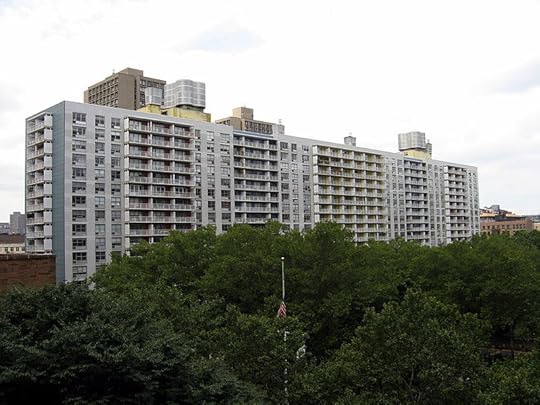 Washington Square Village. Some village!
Washington Square Village. Some village!Padraic Ryan
By the 1960s, when I first came to live in the Village, middle-class professionals like myself were moving in, including a significant gay population, and Bleecker Street was full of small shops and reasonably priced restaurants that attracted big weekend crowds. The street’s re-gentrification, with the influx of designer clothing stores in the early years of this century, was recorded in post #105, “New York Mosaic: The Neighborhoods” (December 22, 2013). Bleecker Street from Bank Street to West 10thStreet is now trendy and (in the real-estate sense) “hot,” with soaring rents that have driven out the shops and restaurants; Marc Jacobs and Ralph Lauren and the like prevail. But other stretches of Bleecker Street are still commercial in a less trendy way, with a mix of shops and restaurants. And high above Bleecker are rent-stabilized holdouts like me, contemptuous of the latest trendy phase of the street, and confident that this phase too will in time yield to another, hopefully with less catastrophic rents. Meanwhile we can console ourselves with the Magnolia Bakery’s cupcakes, or watch others devouring them on our doorstep.
There’s no way this post could mention all the interesting place names and their origin in the borough of Manhattan, much less all those in the city of New York. So I’ll settle for just one more, designating one of only two private parks in the city.
Gramercy Park is a small fenced-in park located between East 20th and 21st Streets, with Lexington Avenue terminating at its northern boundary, and Irving Place commencing at its southern boundary and running south to 14thStreet. The name “Gramercy” is an Anglicization of the Dutch word crommessie, meaning “crooked little knife,” which designated a brook that meandered along what is now East 21st Street and emptied into the East River at 18th Street.
In 1831 the developer Samuel Ruggles, a pioneer in urban planning, bought what was known as Gramercy Farm from a descendant of Peter Stuyvesant, the last Dutch governor of New Amsterdam. He then drained the swampy ground and laid out the park, deeding its possession to the owners of the residential lots surrounding it. The Panic of 1837 delayed construction of the houses surrounding the park until the 1840s, but by 1844 the park had been landscaped and its gate was locked, the result being a planned neighborhood unique for its time. Later attempts to bisect the park so as to connect Lexington Avenue with Irving Place failed, and the park survives today, still elegantly fenced with four locked wrought-iron gates, open only to residents of the buildings surrounding it. In 1966 part of the neighborhood was designated a historic district, and in 1988 the district’s boundaries were extended. Today it is a quiet, crime-free neighborhood, predominantly white.
I have often visited the park, viewing its wide graveled walks and disciplined greenery through the high grilled fence. Usually no one was in it, but occasionally I would see a solitary stroller, one of the privileged few allowed to savor its charms from within. Since I am not so privileged, the park qualifies for me as a forbidden garden (see post #57), but I can’t say that I long for the treasures it guards, since it is not a Garden of the Hesperides or Eden, harbors no fruit whose taste confers immortality, no Tree of Knowledge or Life.
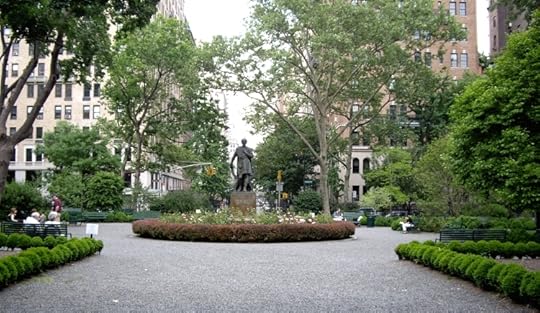 Gramercy Park today, with the Edwin Booth statue looming nobly in the center.
Gramercy Park today, with the Edwin Booth statue looming nobly in the center.Dmadeo
What Gramercy Park does offer is a statue of the famous Shakespearean actor Edwin Booth (whose brother killed Abraham Lincoln), who once resided in a townhouse facing the park. Other features include the Fantasy Fountain, a work in bronze by the sculptor Greg Wyatt that was installed in 1983, and a commemorative fountain and plaque honoring Samuel Ruggles, the urban visionary who also created Union Square. Some of the original townhouses surrounding the park still stand, but many are gone, replaced by apartment buildings, a synagogue, and a hotel. But the residents still get a new key to the park every year, for which they pay $350, and a $1000 fee to replace a key they have lost. Those admitted to its sacred precincts cannot drink alcohol, smoke, cycle, walk a dog, play ball, toss Frisbees, or feed the birds and squirrels, since birdseed and peanuts attract rats. Groups of more than six are also forbidden, and one resident was reprimanded for eating a sandwich on the grass. This may sound like obsessive fussiness, and some residents complain that park rules banish any kind of fun, but the rules and fussiness may also explain why the park looks so tranquil and clean. I confess that I like the idea of a private park visible to outsiders like myself, a sanctuary that manages, in the midst of this turbulent city, to stay old-fashioned and greenly genteel.
Do outsiders ever trespass in the park? I’ve never heard of anyone jumping the fence, but on two occasions in 2000 a member of the National Arts Club, which faces the park and is entitled to keys, brought some minority schoolchildren into the park without prior permission. On the first occasion Sharon Benenson, the chairwoman of the Gramercy Park Trust, called the police, who refused to expel the intruders; on the second occasion the visitors left when Ms. Benenson ordered them out. A suit against the park’s administration was then filed in Federal District Court by the parents and teachers involved, alleging racial discrimination; according to the plaintiffs, Ms. Benenson, who is white, said the visitors were “not our kind of kids.” The park administration denied any discrimination, and Ms. Benenson called the charges “personally insulting,” and described Aldon James, the National Arts Club president and a plaintiff in the case, as “a sort of hairbrained nut. He’s just determined to run Gramercy Park.” Which goes to show that tensions can fester behind the seeming quaint tranquility of this most genteel and exclusive of parks. The lawsuit was settled out of court in 2003, with most of the children getting $36,000 each, and one as much as $50,000: all in all, a rather tidy little profit for a brief intrusion into a forbidden space. And the administration has loosened up a little: jogging is now permitted in certain graveled areas of the park.
Coming soon: Landmarks: Saving the Old from the New. And after that, my belated discovery of architectural cast iron and terra cotta.
© 2015 Clifford Browder
Published on May 31, 2015 04:22
May 24, 2015
181. Nonprofits and What They're Up To
Their appeals clog my mailbox. To get me to open their envelopes, they stamp them with every imaginable type of message:
· Time sensitive – official documents· Time sensitive – second notice (or third, or fourth)· Match opportunity enclosed· Petition enclosed· Check enclosed· Two free totes inside· Your signature urgently needed· Save the whales· Save the baby seals· Save the rain forest· Urgent: time is running out
Sometimes the letters are addressed to me in real or simulated handwriting. Sometimes they send a survey ostensibly to find out what my priorities for action are, and at the end of the survey beg for a donation. And sometimes there is no return address on the envelope, though the words NON PROFIT ORGANIZATION next to the postage tell me all I need to know. Worthy causes, but how many can you give to? And how do they get my name? Those I already give to must sell or trade my name to others, for to give to one is to invite appeals from many. Yes, I give to some of them – small sums once a year, not otherwise. So what do I do, when assailed by this storm of requests? With rare, very rare, exceptions, I throw the letters out. Even the ones that say “check enclosed” and especially the ones with no return address. But if they give me, as a “free” gift, some address labels that I deem acceptable, I keep them and use them. And if they include a few coins to cover the postage for my reply, I pocket the change without a speck of shame. In self-defense, I’m ruthless.
 Nina Paley What is a nonprofit? An organization whose goal is not to earn a profit but to serve society. Many are classified as 501 (c) (3) organizations, meaning that the IRS recognizes them as charities and therefore exempt from federal income taxes, in which case donations to them are also tax-exempt. Their work can involve charitable, religious, educational, literary, or similar activities. Their earnings must not go to any private shareholder or individual, and they must not try to influence legislation or campaign for or against political candidates.
Nina Paley What is a nonprofit? An organization whose goal is not to earn a profit but to serve society. Many are classified as 501 (c) (3) organizations, meaning that the IRS recognizes them as charities and therefore exempt from federal income taxes, in which case donations to them are also tax-exempt. Their work can involve charitable, religious, educational, literary, or similar activities. Their earnings must not go to any private shareholder or individual, and they must not try to influence legislation or campaign for or against political candidates. Given their worthy goals, I cannot hate nonprofits; they’re a peculiarly American phenomenon and serve a useful, even vital, purpose. If they didn’t exist, they’d have to be invented, to deal with certain problems not otherwise being dealt with, and to ease the burden of those often ill-gotten millions – or today, billions – afflicting the heirs of ruthless capitalists, if not the capitalists themselves, who late in their careers may experience a twinge of remorse.
Once, long ago, just after I retired, I did volunteer work for a small nonprofit here in New York and got a glimpse into their very special world. My nonprofit, the Whole Foods Project, advocated a nutritional approach for the treatment of AIDS – then a raging killer – and cancer, and as a cancer survivor I was especially attuned to their mission. (See vignette #8, May 20, 2012.)
Money and how to get it is a perennial preoccupation with nonprofits, and my first Whole Foods Project assignment was to go to the Foundation Library on Fifth Avenue for instruction in how to approach foundations for a donation. At the library I and other initiates learned a lot, and in the process we got a glimpse as well into the very special world of foundations and the purposes they serve. There are literally hundreds of foundations, ranging from the giants that everyone has heard of – the Ford Foundation, the Rockefeller Foundation, and so on – down to tiny, obscure ones, many of them based in New York and only funding very specific causes operating within the city or its immediate vicinity. During the library’s instruction sessions two principles were immediately drilled into us:
1. Foundations rarely give money to individuals unaffiliated with some organization, so if you’re looking for a handout for yourself, forget it.2. By all means read each foundation’s mission statement, but then compare it with what they actually do; what they do may not match what they say.
After several days of research at the library I left armed with a list of possible donors that we immediately contacted. Donations did result, though never enough to fully fund the Project. To raise more money we compiled a long list of possible donors: friends and family of members, and people and organizations who had approached us for information on our vegetarian approach to healing. The result was mass mailings that involved writing addresses on envelopes till your hand was cramped, and sealing the envelopes until your tongue was dry. (Yes, I licked the envelopes, though other volunteers dabbed them with a sponge.) The mailings brought in more money, dribs and drabs that were never enough. And once a year we staged a fund-raising carnival with food from some of the city’s best vegetarian restaurants, stilt walkers, an auction or a raffle, a string quartet, and a lesbian and gay gospel choir. The participants volunteered their services and the carnivals raised money, but to put them on took money. Always, always, always, the need for money. So I know why my mailbox is jammed with those appeals.
 Knight Foundation
Knight FoundationHere, in the form of a map showing a hike into the wilderness, is an account of a local news nonprofit's perilous quest for sustainability. Included are these features:Bottom center, a sign, "Ignore web and community," leading to a cliff and a plunge. The other sign reads, "Forge new path."In the center, a sign, "Beware / Donor dependence," and a crumbling ladder.To the right, where a hiker gets water, a sign, "Big donor falls / Early resources to help get you started."On the far right, a sign, "Content Swamp / Don't get bogged down spending all your resources here."In the center, at the end of Content Swamp, a sign, "Path to experimentation / Explore new revenue streams."Top center, a sign, "Data and platforms / Create new ways to tell engaging stories."Finally, in the upper right, a hiker who has survived these perils and followed the better path heads out toward the next frontier.
The Whole Foods Project vanished long ago, so let’s have a look at some other small nonprofits based in New York City today. I’d never heard of any of them, so how did I find their names? I Googled them.
Albanian Roots is an organization of young Albanian professionals seeking to strengthen the Albanian community by integrating Albanians with each other and with their adopted countries throughout the whole Albanian diaspora. It was created in 2008 by young Albanian college students in New York eager to promote Albanian culture and heritage, and now sponsors an annual parade as part of the Immigrants Day Parade in New York.
My comment: I didn’t know there was an Albanian diaspora, much less an Albanian community in New York, much less an Immigrants Day Parade. Albanians – some 9,100 of them -- live in the Belmont and Morris Park sections of the Bronx.
Common Cents began when Theodore Faro Gross, a writer, was walking down Broadway and his four-year-old daughter saw a man crouching against a newsstand and said, “That man is cold. Why don’t we bring him home?” Her question made him uncomfortable, so to soothe his conscience he began asking his neighbors if they had any pennies for the homeless. One had several goldfish jars filled with pennies, and another a cookie jay full of the same. Encouraged by their synagogue and others, in 1991 he and his wife created a nonprofit whose volunteers harvest pennies from their Upper West Side neighbors and donate them to Coalition for the Homeless, a well-established nonprofit dedicated to feeding the homeless. Each contributing household now donates an average of $13 dollars in coins. But today the nonprofit, which has school kids collecting pennies in an annual Penny Harvest, is at risk of vanishing, since its expanded efforts need close to $1 million a year. “We cannot pay the trucking company to pick up the pennies,” Mr. Gross explains. “I’m down to four staffers and calling people for donations to keep the doors open.” But the city may help. As always, money, money, money.
My comment: A brilliant idea! Stuck with a ton of pennies that my partner Bob had let accumulate and never disposed of, I once gave them to a homeless woman sitting on the sidewalk at Sixth Avenue and 12th Street. But the Grosses took it one step further, with impressive results. Let's hope their nonprofit survives.
Sing for Hope was founded by opera singers Monica Yunus and Camille Zamora in 1995 in an effort to bring all the arts to schoolchildren, hospital and nursing-home patients, and seniors in underserved communities that otherwise have little exposure to art. Today over 1500 professional artist volunteers – opera singers, actors, jazz musicians, dancers, puppeteers, and visual artists – participate. For two weeks every year the Sing for Hope Pianos program installs pianos – at last count 88 -- in public spaces in all five boroughs for anyone and everyone to play – a program that reaches some 2 million New Yorkers and visitors. To walk by a park in a noise-ridden neighborhood and hear an unshaven pianist in shorts and sandals play Schubert in an expert impromptu performance is, as the New York Times journalist who witnessed it reported, an “only-in-New-York experience.”
My comment: During the last two summers, on warm weekend evenings the faint tinkle of piano music would infiltrate my apartment in the West Village. Peering out a window, I could just barely make out a piano planted in the middle of a little park diagonally across from my building. Was this a Sing for Hope performance? Probably not, since one weekend afternoon I saw the pianist in action and, as I recall, he had a bowl on top of the piano in hopes of donations. Still, it was a delightful encounter, worthy of classification as an “only-in-New-York experience.” And the subway and sidewalk entertainers whom I chronicled long ago (vignette #6, May 6, 2012) were also hoping for donations, but their presence was welcome just the same. In this city creativity spills out all over the place.
Project EVIE was founded in 2009 by John Azrielant and some friends to promote the adoption of electric vehicles worldwide. “We want to reframe the conversation about EVs [electric vehicles], to change the way the world thinks about them,” said executive director Azrielant, whose photos reveal a dynamic young man, dark-haired, with an engaging smile. “They’re still seen as glorified golf carts for San Franciscans and pious tree-huggers…. Maybe we can frame them as the vehicle of the American dream, representing freedom and independence.” To realize this goal he and his colleagues in 2010 planned to send a vehicle around the world, crossing six continents and seventy countries in six months, starting in New Zealand and ending in New York, for a total of 70,000 miles. The trip was planned carefully, with a list of charging stations in every country to be visited, and Mr. Azrielant was hopeful. But with a half-million-dollar budget, the newly created nonprofit had money problems from the start, and when the needed funds didn’t come through, the project had to be canceled. Since then, no trace of Mr. Azrielant and his nonprofit. The Facebook page of “Project Evie” reveals a creative home designers outfit helping people renovate or remodel their home, which surely has nothing to do with Mr. Azrielant’s Project EVIE. I fear that the noble project to promote electric vehicles may have collapsed for lack of funds.
My comment: Once again, money, money, money.
The Honey Bee Conservancy works to educate people about the alarming decline in honey bees and what we can do about it. This may at first sound a bit outlandish or eccentric, but if you find out how many common fruits and vegetables depend on pollination by honey bees, you’ll realize that this affects you, too. The causes of the decline are many, but pesticides are one of the culprits. And what does this have to do with New York? The honey stand at the Union Square Greenmarket announces proudly that its honey is a New York product. Since the city’s ban on beekeeping was rescinded in 2010, the city’s rooftops – including (of all places!) the legendary Waldorf Astoria – are abuzz.
My comment: More power to those rooftops, their buzzing visitors, and the conservancy that works to preserve them.
The Greenwich Village Society for Historic Preservation (GVSHP) is a nonprofit that I have long since known about and that I am now a member of, since it is especially relevant for me, a longtime Village resident and a history buff as well. Founded in 1980 by local residents, it seeks to preserve the architectural heritage and cultural history of Greenwich Village and two adjacent neighborhoods, the East Village and NoHo (the district north of Houston Street). Much of the Village was designated a historic district in 1969, but many old buildings outside that district’s boundaries are exposed to insensitive renovation or outright demolition, which GVSHP works to prevent. It gives lectures and walking tours, school programs, and consultations, and promotes the expansion of landmark protection. Appropriately, it is headquartered at the Neighborhood Preservation Center in the historic former rectory of St. Mark’s Church at 232 East 11th Street in the East Village.
I endorse GVSHP’s activities because the Village area – my neighborhood -- still has numerous people-sized buildings, old buildings with six stories at most, which was as much as residents could manage back in those days before the elevator. Even the Village’s larger buildings – the massive Archive Building on Christopher Street or Westbeth, the equally massive artists’ residence on Bethune Street near the Hudson River -- seem like squatting giants, earth-bound, unpretentious, and antiquated, compared with the super-modern high-rises now towering up in Midtown Manhattan and other “hot” neighborhoods now given over to the latest mania of development. (For more on them, see post #178, “Manhattan Real Estate: a Bubble?”) Personally, I don’t ever want to live in a building where I can’t manage the stairs in the event of a power failure. Those high-rise and high-cost apartments with breathtaking views of Central Park won’t be so pleasant, if the city is plunged into yet another blackout; how many of the tenants will care to negotiate 70 or 80 flights of stairs? Maybe someday we’ll find out.
So what specifically has GVSHP accomplished? In 2014, the following:
· Designation of the South Village Historic District, protecting 250 buildings and more than a dozen blocks south of Washington Square: the largest expansion of landmark protection in the Village since 1969.· A report on how the Landmarks Preservation Committee has let unscrupulous developers destroy great pieces of the city’s history before they could be landmarked.· A favorable ruling from a State Supreme Court justice putting the city’s approval of New York University’s massive expansion program on hold, pending an appeal. · Review of more than 100 applications for changes to landmarked properties, advocating preservation of human-scale buildings and sensitive design.
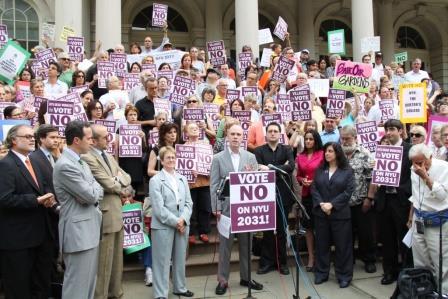 GVSHP in action: opponents of NYU expansion at a June 2012 rally at City Hall.
GVSHP in action: opponents of NYU expansion at a June 2012 rally at City Hall.GVSHP
 Andrew Berman
Andrew BermanGVSHP
GVSHP’s antagonists include New York University and its perennial need to expand; the Real Estate Board of New York (again, see post #178); developers; and the city of New York. Which is taking on quite a load, but GVSHP is used to fighting, and fighting hard, for preservation. This year, and every year, the fight continues. No wonder the New York Observer, a weekly commenting on politics, media, and real estate, has named GVSHP’s executive director, Andrew Berman, one of the 100 Most Powerful People in Real Estate, and New York Magazine has named him one of 100 “Influentials.” He is. And with him in charge, the never-ending fight between preservation and development, the old and the new, human scale and bigness, continues. In this city it will never end.
Here now are two more New York-based nonprofits that I will simply mention in passing:
· The Friends of Abandoned Cemeteries of Staten Island (FACSI) promotes the beautification and rehabilitation of neglected or abandoned cemeteries on Staten Island. Never heard of them till now, but no matter.· The Gowanus Canal Conservancy works to clean up the Gowanus Canal, a Superfund site in Brooklyn, and to create green space and park along its shores. I have to applaud their effort, since the Gowanus, a 1.8-mile-long stretch of foul water that I have glimpsed only fleetingly from a subway train or automobile in passing (who would want to go near it?), is my favorite polluted site in the area, a victim of industrial waste and sewer overflows from surrounding neighborhoods. If the Gowanus can be cleaned up, anything can be.
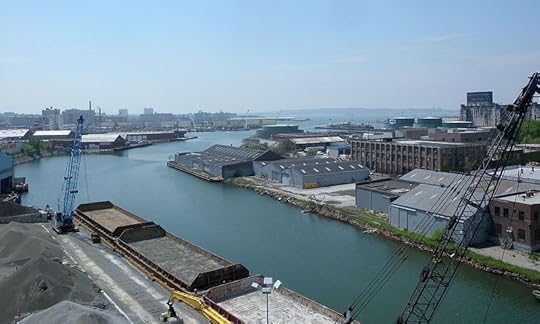 The Gowanus Canal as seen from an expressway bridge. From a distance, the pollution is invisible.
The Gowanus Canal as seen from an expressway bridge. From a distance, the pollution is invisible.I could add more, but the list would go on forever. Each organization was created by someone who saw a need and, instead of lamenting how things were, decided to do something about it.
The Internet is full of information about nonprofits. Here are a few common misconceptions:
1. Only rich kids need apply. False. Most nonprofits rely on paid staff in addition to volunteers.2. People who work in them are invariably upbeat and pleasant. False. You’ll may find just as many grumpy characters, egomaniacs, and office politicians as in any other field.3. Nonprofits are inefficient, waste time and money. Half true. Some are inefficient, some aren’t. Since nonprofits lack clear bottom lines and profit margins, their efficiency is hard to measure.4. Nonprofits support only left-wing causes. False. Politically they are all over the place – left, right, and center.5. Nonprofits provide no upward mobility, are a dead end for your career. False. You can have a lifetime career in a nonprofit, and many of them offer young people more leadership opportunities than other sectors do.
Are there disadvantages in working for a nonprofit? You bet.
1. Lower pay.2. Results that are hard to measure.3. Antiquated technology, and having to do more work with fewer resources.4. Bureaucratic red tape.5. Endless fundraising.6. Irregular hours: evening and weekend obligations, and having to take work home.7. Burnout, resulting from all the preceding conditions. So why work for a nonprofit? Again, the Internet lists advantages:
1. Meaningfulness: as a result of your efforts, human lives will be transformed.2. Many hats: you won’t be locked into one job, but will probably serve in many, and so acquire a wide and varied experience.3. Creativity: you’ll be challenged to find new ways to fulfill your mission and reach people in faster, cheaper, better ways.4. A casual work environment.5. A culture of like-minded people, inspiring teamwork and collaboration, rather than internal competition. (But see misconception #2 above.)6. Benefits: health care insurance, dental plans, retirement plans, flexible hours, long vacations. (Some nonprofits, not all.)
As regards #5, an acquaintance who works for a large nonprofit agrees about like-minded people and hasn’t himself experienced office politics or grumpy coworkers, though he also agrees that burnout is a risk.
But what if a nonprofit fails and declares bankruptcy? Because it does happen, and the results can be messy. A case in point: FEGS Health and Human Services, founded in 1934 to help the unemployed find work. One of New York City’s largest and oldest social service agencies, it filed for bankruptcy in March 2015. How could it happen? Mounting costs, dwindling revenues, and the departure of key employees, including three chief financial officers in just two years. Among the mounting expenses: administrative costs, including salaries, that made up 30% of the agency’s budget, far exceeding industry standards.
The result: The agency's 120,000 poor and disabled clients have been handed over to other agencies, and its employees are scattered, some in new jobs, some still jobless, and others struggling to get by in jobs that pay less. Meanwhile hundreds of unpaid creditors – furniture and security companies, banks, and former workers waiting anxiously for severance pay – are preparing to fight it out in bankruptcy court for whatever scraps remain.
But that’s not all. Gail Magaliff, the CEO presiding over FEGS as it collapsed, has filed legal papers in bankruptcy court claiming that she is owed $1.2 million in deferred compensation. Ms. Magaliff, who earned $638,880 in base salary and additional compensation in fiscal year 2012, insists that FEGS promised her the compensation for her “services as a valuable executive employee” – a claim that rings hollow for the agency’s former workers, many of them still looking for a job. How it will all turn out is uncertain, but it’s messy. Is this messiness peculiar to nonprofits? Hardly. For-profit companies, big and small, go bankrupt all the time.
How livable is New York City? The May issue of the Bulletin of the AARP, the giant nonprofit dedicated to enhancing quality of life for geezers like myself, features lists of the most livable places for seniors in the U.S., based on interviews with 4,500 golden oldies. Given New York’s reputation for noise and congestion, I feared the worst but was pleasantly surprised. In a list of the ten most livable neighborhoods, a neighborhood in Madison, Wisconsin, was #1, but right after it came the Upper West Side of Manhattan, because of its restaurants, culture, easy access to gyms and Central Park, and cheap and convenient mass transit. More power to the Upper West Side! Personally, I think that the West Village also merits such a rating, even though both neighborhoods are afflicted with high rents, but I’m glad that my city snuck in there even so.
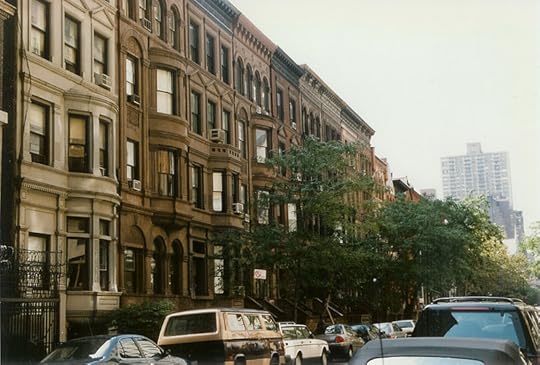 Handsome old brownstones on the Upper West Side, not far from Central Park. Yes, livable.
Handsome old brownstones on the Upper West Side, not far from Central Park. Yes, livable.Stilfehler
From the list of ten most livable big cities, New York is, alas, conspicuously absent, the top three being San Francisco, Boston, and Seattle. Not that I put down the winning trio. I lived in San Francisco once long ago, when it was still cheap, and loved it, and rate Boston after New York as the place I most want now to live. As for Seattle, I have heard good things about it, and am willing to forget my one brief visit long ago, toting luggage up and down those hills, before taking an unscheduled flight to Alaska for a summer job.
Still, there’s hope for the Big Apple. In the list of the ten big cities where it’s easiest to get around, New York ranks #3, after San Francisco and Boston. But for staying healthy, it doesn’t make the list at all. San Francisco is the healthiest, with a low obesity rate; maybe traipsing up and down all those hills pays off, though I insist that my four-flight walkup amounts to the same, and my PCP (primary care physician) has casually mentioned living in a six-flight walkup. Besides, we have MOMA and the Metropolitan Museum of Art, and we’re #4 among the best ten big cities for dating, after Nashville, San Francisco, and Washington. Nashville? Well, if you like the Grand Ole Opry… It takes all kinds to make a world, so let’s be gentle and tolerant, and maybe Nashville will tolerate us.
Coming soon: The History and Mystery of Names. How did Gansevoort and Horatio Streets get their names? And the Battery, Governors Island, and Bowling Green? Plus a crouching bull, and a locked garden where eating a sandwich is verboten. And then, Landmarks: Saving the Old from the New.
© 2015 Clifford Browder
Published on May 24, 2015 04:41
May 17, 2015
180. Walking in New York
A recent magazine section of the Sunday New York Times had as its theme “Walking New York” and included accounts by seventeen New Yorkers of walks in the city that for them had been especially significant. Concluding the accounts was a poem by Steve Duenes entitled “How to Walk in New York” that begins
Don’t text. Don’t smile. Don’t be injured. Don’t break stride. Don’t hum what’s in your headphones.
and finally concludes
Don’t be an obstacle. Don’t be sick. Don’t be old. Don’t stop. Don’t look back.
Mr. Duenes’s poem needn’t be taken literally. It would be well not to text when walking, but smiles and old age are permitted, and so are stops along the way. But other advice of his is quite appropriate, as for instance “Don’t talk on your phone” and “Don’t carry a giant umbrella” – two sins that walking New Yorkers often commit, causing peril to themselves and others.
Yes, as the Times article insists, in spite of all those vehicles that jam the streets, New York is a city of walkers. Walking is often the quickest way to get somewhere, given the slowness of ground transportation. Walking in congested Manhattan, I have often overtaken a crosstown bus stopped by a red light or a traffic jam, and when, resuming its trip, the bus overtakes me, often as not I will overtake it again and again. And if New Yorkers stride purposefully, intent on getting somewhere, in less pressured moments they also slow down to a stroll and enjoy the ever changing sights of the city.
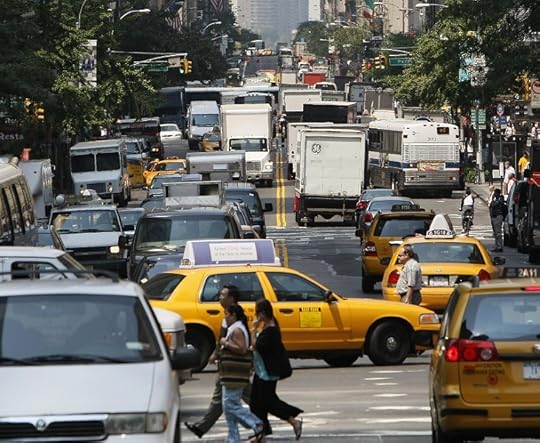 ILMRT
ILMRTI have always liked walking in the city, even undertaking long walks that few New Yorkers would want to invest the time and energy in, and I’ll recount a few those here, with the surprises they yielded. But I’ll start with a short recent walk from my West Village apartment to the new Whitney Museum of American Art in the Meatpacking District, a neighborhood in the northwest corner of the Village once characterized by huge carcasses of beef hacked up in messy packing plants. Typical of this ever-changing city, today the district has been utterly transformed by that insidious process known as gentrification. Which means bloody carcasses are out, trendy bars and restaurants are in, and especially “in” is the new museum. (For more on the gentrification of the Meatpacking District, see post #138, August 3, 2014.)
Going up Washington Street to Gansevoort, I found the museum there, cheek by jowl with the downtown (southern) end of the High Line, the elevated park that these days has become another “in” thing to do. More of that anon; for now, let’s have a look at the museum – the outside, that is, since I have yet to venture into it.
(Gansevoort Street: who or what was Gansevoort? I’ll do a post in the near future on the mystery and history of place names; the mystery of “Gansevoort” will be unraveled.)
The new Whitney, best seen from Gansevoort Street, looms impressively, the work of veteran museum architect Renzo Piano, one of the creators (or perpetrators) of the Pompidou Center in the Paris market district, a vibrantly modern edifice that wears its plumbing on the outside and strikes viewers as either a monster or a dazzlingly new creation. And the Whitney? Seen from the south or Gansevoort side, it looks like a stack of boxes piled on top of one another but not aligned. It looms, it juts, it overhangs. Whether you like it or not, you won’t forget it.
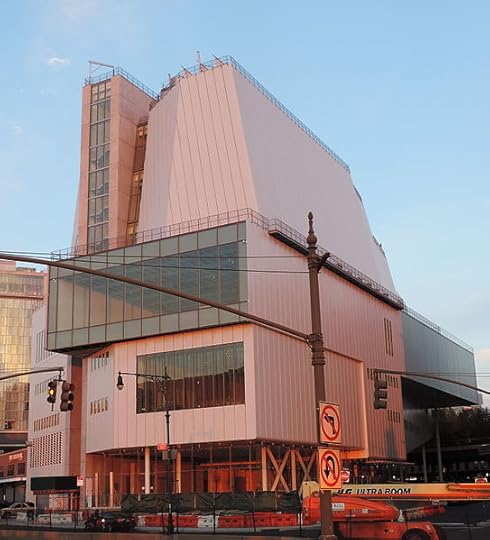 The Whitney, almost completed, in November 2014. Seen from the west -- the view
The Whitney, almost completed, in November 2014. Seen from the west -- the viewI couldn't get on foot.
Jim.henderson From the west or Hudson River side I couldn’t get a good impression of the museum, since the West Side Highway keeps you from getting a little distance away from it for a better view; a Times reporter describes the museum, when seen from that side, as vaguely nautical, perhaps a ship on blocks. Before trying for views from the east and north, I relaxed in a chair the museum generously provided on a little deck outside the glass-walled gift shop, which was crammed with visitors eager to buy books and souvenirs. Sitting with my back to the museum, I had a good view of both the highway, whose roar caressed my ears, and also, at the curb nearby, Call Ahead, an installation offering facilities to both sexes, except that it was shut up tight.
To see the museum’s exterior from the east and north, I mounted the stairs to the High Line (the elevator being “temporarily” closed), that narrow strip of green projected north from there one story above the city streets. There is no good view of the Whitney from the east, since the High Line obtrudes, but as you walk north along the High Line you can get a view of the north or uptown face of the museum, which the Times reporter describes as resembling a factory or hospital, with a wall of windows and a cluster of protruding pipes. To my eye it looks like two boxes: a big box on the right rising sheer and clunky, and next to it a lower box on the left with protruding spikes and, far above this box, several tiers of catwalks thronged with visitors.
All in all I would call the Whitney an assemblage of masses, an oddity not meant to soothe the psyche, but jolt it. Original it certainly is, but for many – like the Pompidou, or even at one time the Eiffel Tower, in Paris – it may take some getting-used-to. As one French paper said of the Pompidou, “love at second sight.” The adventure of the interior still awaits me, but those catwalks a-crawl with visitors make me just a bit nervous, as do the glass walls and plunging perspectives of the new MOMA (Museum of Modern Art).
I harbor no mixed feelings about the High Line, that strip of greenery built along what was once an elevated spur of the New York Central Railroad; the park is a sheer delight. As I strolled a short distance north, I encountered a grove of birch trees planted along the abandoned railroad tracks, and also, side by side, a dogwood and a redbud, both in bloom. There were visitors everywhere snapping photos of each other and the greenery, or lining up at snack bars, or stretched out on benches and soaking up the sun. The walkway passes under several soaring modern buildings whose huge windows offer views of the High Line and add to the super-modern and trendy new look of the Meatpacking District, though the High Line cannot escape the whining and grinding noises, horn blasts, and siren wails rising from the street. Still, it’s an inspiration, a wonder.
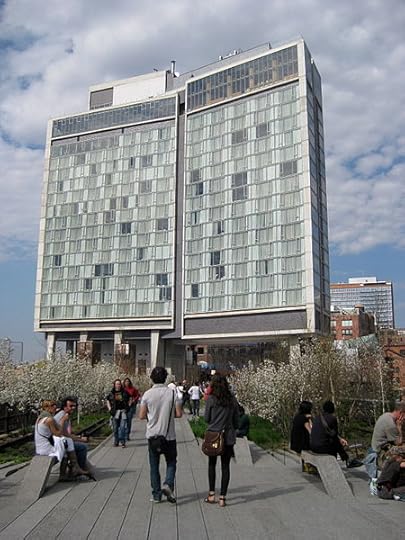 The High Line, passing under the Standard Hotel.
The High Line, passing under the Standard Hotel.La Citta Vita
Every walk offers surprises. Leaving the High Line at 14thStreet, I walked south along Washington Street and realized that the area is still a work in progress: on the left or east side of the street, trendy shops; on the west side, distracting construction noises and meatpackers’ trucks parked at loading platforms – proof that the Meatpacking District still, to some extent, lives up to its name. And then, as I walked along Horatio Street toward Greenwich – a walk I had never done before – I discovered a row of Greek Revival houses on the north side of the street: either well-kept homes from the nineteenth century, or inspired replicas. Doubt as to their genuineness vanished when I spied, on numbers 11 and 13, plaques reading “1836,” the date of their construction. So it is in the Village, as in other old sections of the city: charming Federal and Greek revival houses and brownstones, well preserved, where you least expect them. The rage of modernity has not reached – or shall I say infected – all the city.
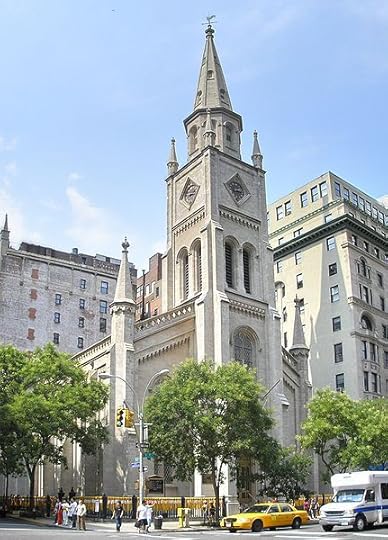 Another walk I used to do took me from the Public Library at Fifth Avenue and 42nd Street down Fifth to the Village. I was usually doing research in the library and chose to walk home around 5 p.m. to stretch my legs and avoid the crowds in the subway. For me this was a familiar walk, but two surprises awaited me. First, at Fifth Avenue and 29thStreet I passed the Marble Collegiate Church, an impressive marble structure built in 1854 in what is designated Neo-Romanesque Gothic style with a soaring steeple. And there, posted on the building, was the name of its pastor: Dr. Norman Vincent Peale. I had no idea that the renowned author of The Power of Positive Thinking, a 1952 best seller selling in the millions, was the minister of a church right here in Manhattan. No, I wasn’t tempted to attend services or read the book, but for years I looked for his name on the church. Then, one day in 1984, I discovered a different name there and realized that the famous Dr. Peale had retired. Another surprise, and a reminder that nothing lasts forever, not even the author of The Power of Positive Thinking. Dr. Peale died in 1993, but his presence still inspires the church in the form of a life-sized bronze statue installed in the churchyard in 1998. (For more on Dr. Peale, see post #149, where he appears in the company of Fulton J. Sheen, that other rock star of devotion.)
Another walk I used to do took me from the Public Library at Fifth Avenue and 42nd Street down Fifth to the Village. I was usually doing research in the library and chose to walk home around 5 p.m. to stretch my legs and avoid the crowds in the subway. For me this was a familiar walk, but two surprises awaited me. First, at Fifth Avenue and 29thStreet I passed the Marble Collegiate Church, an impressive marble structure built in 1854 in what is designated Neo-Romanesque Gothic style with a soaring steeple. And there, posted on the building, was the name of its pastor: Dr. Norman Vincent Peale. I had no idea that the renowned author of The Power of Positive Thinking, a 1952 best seller selling in the millions, was the minister of a church right here in Manhattan. No, I wasn’t tempted to attend services or read the book, but for years I looked for his name on the church. Then, one day in 1984, I discovered a different name there and realized that the famous Dr. Peale had retired. Another surprise, and a reminder that nothing lasts forever, not even the author of The Power of Positive Thinking. Dr. Peale died in 1993, but his presence still inspires the church in the form of a life-sized bronze statue installed in the churchyard in 1998. (For more on Dr. Peale, see post #149, where he appears in the company of Fulton J. Sheen, that other rock star of devotion.)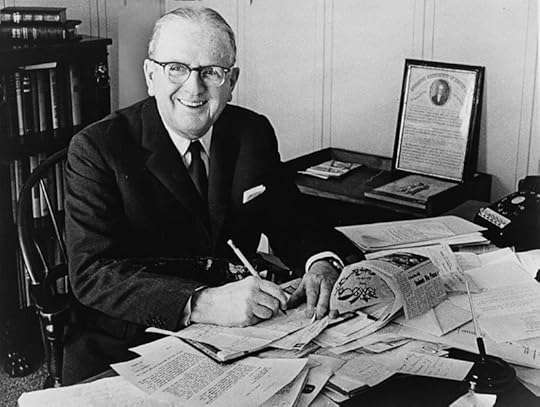 Dr. Peale in 1966, looking fatherly and benign. And what a smile!
Dr. Peale in 1966, looking fatherly and benign. And what a smile!And the second surprise on my walk downtown on Fifth Avenue? Minnie Mouse. Yes, there she was on the sidewalk, along with other beloved Disney characters and related species, welcoming buyers flocking to some event on the Avenue just above 23rdStreet and across from Madison Square. I never quite grasped what the occasion was, but the arriving visitors must have been buyers from out-of-town stores coming to New York in July – and a hot July at that – to place orders for goods to be sold during the Christmas holiday season. It’s a hardship of the profession that buyers have to guess, months in advance and in the heat of summer, what will sell at the chilly onset of winter, but Minnie and her cohorts were there to make their decisions easier. Maybe it was a toy fair for wholesalers, one of those annual events open only to the trade. But it was a fun moment for me, and a surprise, to see Minnie and her friends in action, though I didn’t envy the humans sweating inside those costumes in July.
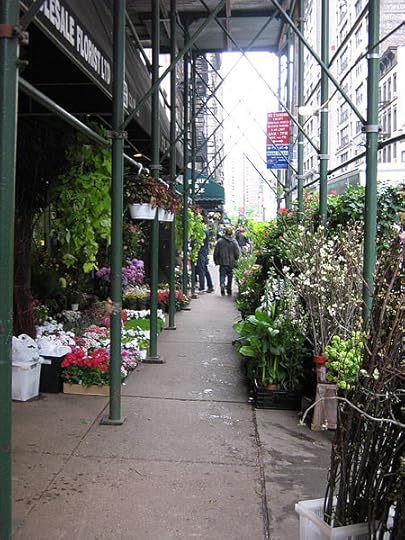 dave_7 Another trip took me uptown from the Village to do research in the library (what a scholar I must have been in those days!), and then on farther uptown to the Whole Foods Project lunch in a church on West 73rd Street. En route I often found myself in the midst of the Flower District, which today runs along West 28th Street between Sixth and Seventh Avenues, an amazing jungle of greenery where plant wholesalers and retailers set plants out on the sidewalk: tubs of flowers, shrubs, even orange trees and palms, sometimes so thick and tall a growth that you almost forget you’re in a city. And there’s more inside the shops, whose shelves are crammed with every kind of plant conceivable, and pots and vases and gardening tools, and even imitation fruits that from a distance can’t be told from the genuine article. But this is a place to buy in bulk – for a wedding, for example – since the flowers and plants are sold in bunches, but it’s also a place to buy cheap.
dave_7 Another trip took me uptown from the Village to do research in the library (what a scholar I must have been in those days!), and then on farther uptown to the Whole Foods Project lunch in a church on West 73rd Street. En route I often found myself in the midst of the Flower District, which today runs along West 28th Street between Sixth and Seventh Avenues, an amazing jungle of greenery where plant wholesalers and retailers set plants out on the sidewalk: tubs of flowers, shrubs, even orange trees and palms, sometimes so thick and tall a growth that you almost forget you’re in a city. And there’s more inside the shops, whose shelves are crammed with every kind of plant conceivable, and pots and vases and gardening tools, and even imitation fruits that from a distance can’t be told from the genuine article. But this is a place to buy in bulk – for a wedding, for example – since the flowers and plants are sold in bunches, but it’s also a place to buy cheap.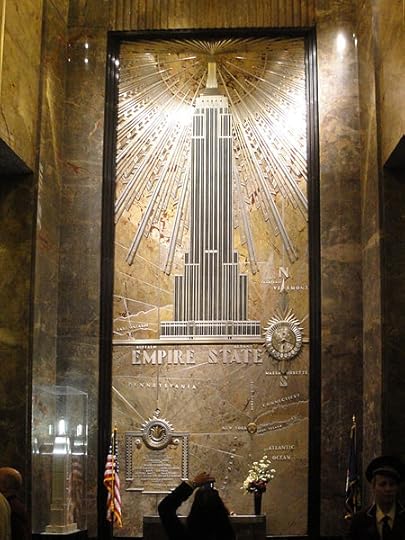 The lobby mural of the Empire State Building.
The lobby mural of the Empire State Building.OptimumPx Once past that special district, the greenery disappears and the reality of city life – the crowds, the noise, the congestion – presses hard upon you. But usually I would approach the Empire State Building along 33rd Street, enter it (this was before 9/11), and walk the lobby’s dim but spacious corridors past an aluminum relief of the skyscraper, and exit at the Fifth Avenue entrance to continue up the avenue to the library. Just walking through that building gave me a special, indefinable thrill.
Later, leaving the library after a bit of research, I would enter an arcade that took me from 42nd to 43rdStreet, and then another arcade from 43rd to 44th Street, coming out on 44th near the renowned Algonquin Hotel, where writer and critic Dorothy Parker and her accomplices once convened for the famous Algonquin Round Table to trade opinions and gossip and mordant wit. (For more of that renowned but bitchy clique, see post #166, February 11, 2015.) From there I would proceed up one of the avenues to Central Park, and then up Broadway past Lincoln Center – not at its best in broad daylight – to my destination on 73rd Street. And after that longish trek, did I have an appetite for lunch!
Another walk took me from the Village to the lighting and lamp district on the Bowery. Needing a lamp for the living room, I decided to walk to the Bowery and in the process discovered – or rediscovered -- one district after another in this endlessly diverse city. Crossing Houston Street, I entered Soho (or SoHo), a trendy district south of Houston now known for artists’ lofts, galleries, and boutiques, but once a neighborhood of commercial buildings with cast-iron façades housing small factories, sweatshops, warehouses, and printing plants. By the 1960s these operations had moved out, and artists began moving into the abandoned buildings offering low-rent lofts with large spaces, high ceilings, and big windows admitting natural light. Then, by the 1980s, gentrification set in like a creeping disease – or a marvelous enhancement, if you like – following which the neighborhood became “hip” and “in” and high-priced, and a mecca for tourists.
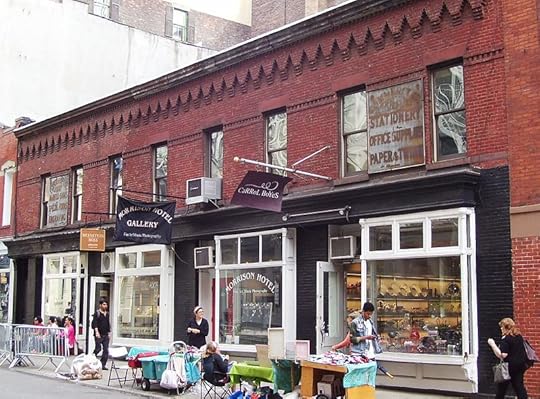 120-126 Prince Street in Soho, two buildings with a common façade made of brick, stone, and iron. Built in 1892-93 for stores and light manufacturing, on the ground floor they now house trendy
120-126 Prince Street in Soho, two buildings with a common façade made of brick, stone, and iron. Built in 1892-93 for stores and light manufacturing, on the ground floor they now house trendy shops and a gallery.
Beyond My Ken
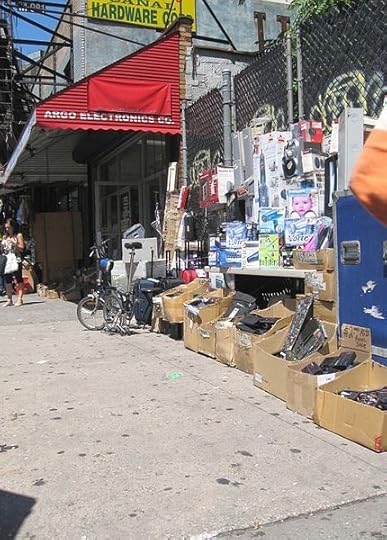 One of the last Radio Row stores on Canal Street. Crossing Canal Street, I left Soho behind and skirted Little Italy, now a shrunken remnant of its former self, its presence announced here by a handful of Italian restaurants. (Many Italians moved out long ago to Brooklyn, Staten Island, and the fair suburban pastures of New Jersey and Long Island – another familiar pattern in the city, as immigrants prospered and crept into the ranks of the middle class.) By now I was close to my destination, with signs in Chinese announcing Chinatown’s expansion northward across Canal Street, and nearby, on the north side of Canal Street, the remnants of Radio Row, a stretch of the street once lined with radio and electronics stores. And at Canal Street and the Bowery I also encountered the Downtown Diamond District, from which merchants once migrated to create the better-known Uptown Diamond District on 47th Street between Fifth and Sixth Avenues.
One of the last Radio Row stores on Canal Street. Crossing Canal Street, I left Soho behind and skirted Little Italy, now a shrunken remnant of its former self, its presence announced here by a handful of Italian restaurants. (Many Italians moved out long ago to Brooklyn, Staten Island, and the fair suburban pastures of New Jersey and Long Island – another familiar pattern in the city, as immigrants prospered and crept into the ranks of the middle class.) By now I was close to my destination, with signs in Chinese announcing Chinatown’s expansion northward across Canal Street, and nearby, on the north side of Canal Street, the remnants of Radio Row, a stretch of the street once lined with radio and electronics stores. And at Canal Street and the Bowery I also encountered the Downtown Diamond District, from which merchants once migrated to create the better-known Uptown Diamond District on 47th Street between Fifth and Sixth Avenues. But I wasn’t looking for diamonds or a radio or a Chinese meal, I wanted a lamp. So I turned north on the Bowery and discovered shops selling lamps and lighting fixtures on both sides of the street between Grand and Broome Streets. Any kind of lighting fixture you might desire is available in these shops, their wares displayed in bewildering profusion. Fortunately, I found just the lamp I needed in the very first shop I entered, though I checked out several others before returning to buy that lamp. But this district too, a shadow of its former self, is in danger, thanks in part to – you guessed it -- gentrification. Even the Bowery – once the city’s notorious skid row – is getting trendy and upscale, so higher rents and the rise of online shopping are causing the lighting stores to close. As for the flophouses that once characterized the street, there are very few left. Also threatened is another nearby district, the wholesale restaurant- and bar-supply district along the Bowery just south of Houston. (For more on the Bowery, see post #90, "The Bowery: From Bhoys to Bums to Condos," October 2, 2013.)
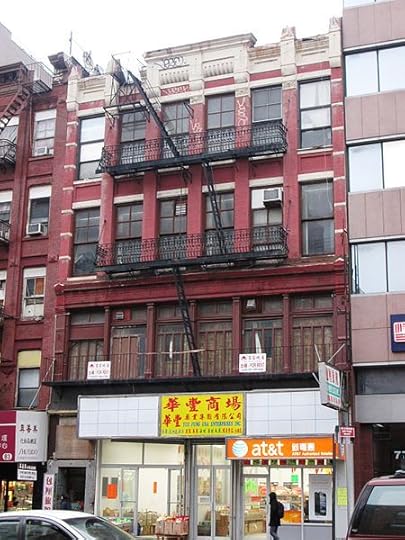 The Bowery Lodge at 81 Bowery, one of the last skid row flophouses. The signs
The Bowery Lodge at 81 Bowery, one of the last skid row flophouses. The signsin Chinese show how Chinatown has spread north of Canal Street.
Beyond My Ken Soho, Little Italy, Chinatown, Radio Row, the Downtown Diamond District, the Lighting District, and the restaurant- and bar-supply stores just to the north – not a bad succession of sights in the course of a twenty- or thirty-minute walk in Manhattan. Only on foot can you savor the rich mix of the city, register its endless succession of surprises.
Sometimes the city surprises you during a walk that you have done a hundred times or more. Though I have often visited Union Square and its greenmarket, only recently did I notice an impressive building on the northeast corner of East 15th Street and Union Square East, a high building fronted by four soaring Corinthian columns that made it look like a bank of another time. Going closer, I read the words FUERZA BRUTA in big letters above the columns. “Fuerza bruta”? “Brute force”? What was this all about? Going closer still, I saw a sign announcing the Daryl Roth Theatre, a theater I had never heard of. So was this a movie theater offering a Spanish-language film to Latinos? A theater that looked like a bank that looked like an ancient Greek temple?
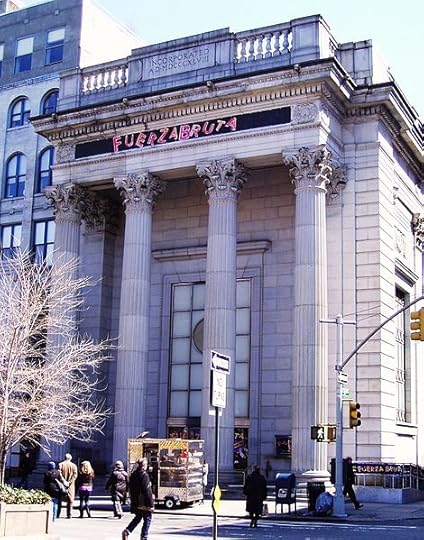 Beyond My Ken
Beyond My KenBy the time I got home, I had forgotten the name of the theater, but “fuerza bruta” stuck in my mind, and the Internet, that vast repository of useful and useless facts, led to me the theater and finally to the building’s history. Fuerza Bruta – translated as “Brute Force Wind” (though where they got the “wind” I’ll never know) – is advertised as a “hit off-Broadway interactive experience” that has returned to New York with WAYRA, a new show that will “flood your senses with heart-thrashing fun, pulse-pumping live music and breathtaking aerial acrobatics.” Which makes it sound like a multimedia event combining jazz, circus, and I’m not sure what – “environmental eye candy,” as one reviewer put it. Just reading about it wore me out, but I’m sure it finds its audience … somewhere.
But this is irrelevant; my interest is in the building itself. Completed in 1907 as the new home of the Union Square Savings Bank, it had (and still has) a façade of white granite whose classic Greek temple style was meant to convey, to a public still unnerved by the financial crisis of 1893, an impression of order and sobriety -- in other words, a safe place to deposit your goodies. (Bad timing: in that same year 1907 there was another financial panic, and a bad one.) As for the spacious interior, it was outfitted in marble and bronze and lit by stained-glass skylights far above, while depositors could tread on black-and-white mosaic tiles made of (of all things!) rubber.
The bank survived various panics, including the Great Crash of 1929 and the lean years that followed, and underwent a merger and a name change, before being acquired by the American Savings Bank in 1982. Under this rubric it entered into a series of bad real estate loans, foundered, and was closed by state regulators in 1992.
What becomes of an elegant Greek-temple-like bank, after it ceases to be a bank? It sat empty for several years and then in 1996 was acquired by award-winning theater producer Daryl Roth, who converted it into a theater modestly named for herself. But that same year the building became a New York City landmark, so the monumental exterior remains intact, no matter what wild happenings are raging inside. How I could have overlooked the building all these years, I will never understand. In my opinion, it is the handsomest, and architecturally the most interesting, structure facing Union Square.
A mystery surge: Last Tuesday, May 12, coinciding with a surge in bug activity in my apartment (I slaughtered dozens), there was a surge in page views of this blog. Normally there are between 80 and 150 views a day, and if, rarely, the number rises to near or slightly above 200, I’m surprised and delighted. But last Tuesday the number surged mysteriously near noon, and the final total for the day was 336 – an unprecedented figure. Why? I have no idea. An invasion of foreign hackers? No, most of the views were – as usual – from this country. And of course the day’s total on Wednesday sank back to normal. Hopefully, the number of bugs will likewise diminish, though I’m not counting on it. And which posts got the most hits? The top five:
1. #89, Who Really Runs America? David Rockefeller?2. #179, The West Village Then and Now (the most recent post)3. #43, Man/Boy Love: The Great Taboo (usually gets the most)4. #141, Hell House and Christian Terrorism5. #136, Francis J. Spellman, the Controversial Cardinal (another perennial favorite, posing the inevitable question: Was he or wasn’t he?)
Clearly, favorite topics are sex, politics, and (as long as it’s not bland) religion.
Banks: Viewers of this blog know how I love banks – the big ones, that is. Goodness gracious, five of the biggest – Barclay’s, Citigroup, the Royal Bank of Scotland, UBS, and my own dear J.P. Morgan Chase – are reportedly about to plead guilty to felony charges brought by the U.S. Justice Department. The banks are accused of rigging the price of foreign currencies and will pay billions in fines. But surely no one will go to prison, since that might upset the whole financial world unduly. Coming soon: Nonprofits and What They’re Up To: Cemeteries, Old Houses, Pianos, Pennies, and the Gowanus Canal.
© 2015 Clifford Browder
Published on May 17, 2015 05:29
80. Walking in New York
A recent magazine section of the Sunday New York Times had as its theme “Walking New York” and included accounts by seventeen New Yorkers of walks in the city that for them had been especially significant. Concluding the accounts was a poem by Steve Duenes entitled “How to Walk in New York” that begins
Don’t text. Don’t smile. Don’t be injured. Don’t break stride. Don’t hum what’s in your headphones.
and finally concludes
Don’t be an obstacle. Don’t be sick. Don’t be old. Don’t stop. Don’t look back.
Mr. Duenes’s poem needn’t be taken literally. It would be well not to text when walking, but smiles and old age are permitted, and so are stops along the way. But other advice of his is quite appropriate, as for instance “Don’t talk on your phone” and “Don’t carry a giant umbrella” – two sins that walking New Yorkers often commit, causing peril to themselves and others.
Yes, as the Times article insists, in spite of all those vehicles that jam the streets, New York is a city of walkers. Walking is often the quickest way to get somewhere, given the slowness of ground transportation. Walking in congested Manhattan, I have often overtaken a crosstown bus stopped by a red light or a traffic jam, and when, resuming its trip, the bus overtakes me, often as not I will overtake it again and again. And if New Yorkers stride purposefully, intent on getting somewhere, in less pressured moments they also slow down to a stroll and enjoy the ever changing sights of the city.
 ILMRT
ILMRTI have always liked walking in the city, even undertaking long walks that few New Yorkers would want to invest the time and energy in, and I’ll recount a few those here, with the surprises they yielded. But I’ll start with a short recent walk from my West Village apartment to the new Whitney Museum of American Art in the Meatpacking District, a neighborhood in the northwest corner of the Village once characterized by huge carcasses of beef hacked up in messy packing plants. Typical of this ever-changing city, today the district has been utterly transformed by that insidious process known as gentrification. Which means bloody carcasses are out, trendy bars and restaurants are in, and especially “in” is the new museum. (For more on the gentrification of the Meatpacking District, see post #138, August 3, 2014.)
Going up Washington Street to Gansevoort, I found the museum there, cheek by jowl with the downtown (southern) end of the High Line, the elevated park that these days has become another “in” thing to do. More of that anon; for now, let’s have a look at the museum – the outside, that is, since I have yet to venture into it.
(Gansevoort Street: who or what was Gansevoort? I’ll do a post in the near future on the mystery and history of place names; the mystery of “Gansevoort” will be unraveled.)
The new Whitney, best seen from Gansevoort Street, looms impressively, the work of veteran museum architect Renzo Piano, one of the creators (or perpetrators) of the Pompidou Center in the Paris market district, a vibrantly modern edifice that wears its plumbing on the outside and strikes viewers as either a monster or a dazzlingly new creation. And the Whitney? Seen from the south or Gansevoort side, it looks like a stack of boxes piled on top of one another but not aligned. It looms, it juts, it overhangs. Whether you like it or not, you won’t forget it.
 The Whitney, almost completed, in November 2014. Seen from the west -- the view
The Whitney, almost completed, in November 2014. Seen from the west -- the viewI couldn't get on foot.
Jim.henderson From the west or Hudson River side I couldn’t get a good impression of the museum, since the West Side Highway keeps you from getting a little distance away from it for a better view; a Times reporter describes the museum, when seen from that side, as vaguely nautical, perhaps a ship on blocks. Before trying for views from the east and north, I relaxed in a chair the museum generously provided on a little deck outside the glass-walled gift shop, which was crammed with visitors eager to buy books and souvenirs. Sitting with my back to the museum, I had a good view of both the highway, whose roar caressed my ears, and also, at the curb nearby, Call Ahead, an installation offering facilities to both sexes, except that it was shut up tight.
To see the museum’s exterior from the east and north, I mounted the stairs to the High Line (the elevator being “temporarily” closed), that narrow strip of green projected north from there one story above the city streets. There is no good view of the Whitney from the east, since the High Line obtrudes, but as you walk north along the High Line you can get a view of the north or uptown face of the museum, which the Times reporter describes as resembling a factory or hospital, with a wall of windows and a cluster of protruding pipes. To my eye it looks like two boxes: a big box on the right rising sheer and clunky, and next to it a lower box on the left with protruding spikes and, far above this box, several tiers of catwalks thronged with visitors.
All in all I would call the Whitney an assemblage of masses, an oddity not meant to soothe the psyche, but jolt it. Original it certainly is, but for many – like the Pompidou, or even at one time the Eiffel Tower, in Paris – it may take some getting-used-to. As one French paper said of the Pompidou, “love at second sight.” The adventure of the interior still awaits me, but those catwalks a-crawl with visitors make me just a bit nervous, as do the glass walls and plunging perspectives of the new MOMA (Museum of Modern Art).
I harbor no mixed feelings about the High Line, that strip of greenery built along what was once an elevated spur of the New York Central Railroad; the park is a sheer delight. As I strolled a short distance north, I encountered a grove of birch trees planted along the abandoned railroad tracks, and also, side by side, a dogwood and a redbud, both in bloom. There were visitors everywhere snapping photos of each other and the greenery, or lining up at snack bars, or stretched out on benches and soaking up the sun. The walkway passes under several soaring modern buildings whose huge windows offer views of the High Line and add to the super-modern and trendy new look of the Meatpacking District, though the High Line cannot escape the whining and grinding noises, horn blasts, and siren wails rising from the street. Still, it’s an inspiration, a wonder.
 The High Line, passing under the Standard Hotel.
The High Line, passing under the Standard Hotel.La Citta Vita
Every walk offers surprises. Leaving the High Line at 14thStreet, I walked south along Washington Street and realized that the area is still a work in progress: on the left or east side of the street, trendy shops; on the west side, distracting construction noises and meatpackers’ trucks parked at loading platforms – proof that the Meatpacking District still, to some extent, lives up to its name. And then, as I walked along Horatio Street toward Greenwich – a walk I had never done before – I discovered a row of Greek Revival houses on the north side of the street: either well-kept homes from the nineteenth century, or inspired replicas. Doubt as to their genuineness vanished when I spied, on numbers 11 and 13, plaques reading “1836,” the date of their construction. So it is in the Village, as in other old sections of the city: charming Federal and Greek revival houses and brownstones, well preserved, where you least expect them. The rage of modernity has not reached – or shall I say infected – all the city.
 Another walk I used to do took me from the Public Library at Fifth Avenue and 42nd Street down Fifth to the Village. I was usually doing research in the library and chose to walk home around 5 p.m. to stretch my legs and avoid the crowds in the subway. For me this was a familiar walk, but two surprises awaited me. First, at Fifth Avenue and 29thStreet I passed the Marble Collegiate Church, an impressive marble structure built in 1854 in what is designated Neo-Romanesque Gothic style with a soaring steeple. And there, posted on the building, was the name of its pastor: Dr. Norman Vincent Peale. I had no idea that the renowned author of The Power of Positive Thinking, a 1952 best seller selling in the millions, was the minister of a church right here in Manhattan. No, I wasn’t tempted to attend services or read the book, but for years I looked for his name on the church. Then, one day in 1984, I discovered a different name there and realized that the famous Dr. Peale had retired. Another surprise, and a reminder that nothing lasts forever, not even the author of The Power of Positive Thinking. Dr. Peale died in 1993, but his presence still inspires the church in the form of a life-sized bronze statue installed in the churchyard in 1998. (For more on Dr. Peale, see post #149, where he appears in the company of Fulton J. Sheen, that other rock star of devotion.)
Another walk I used to do took me from the Public Library at Fifth Avenue and 42nd Street down Fifth to the Village. I was usually doing research in the library and chose to walk home around 5 p.m. to stretch my legs and avoid the crowds in the subway. For me this was a familiar walk, but two surprises awaited me. First, at Fifth Avenue and 29thStreet I passed the Marble Collegiate Church, an impressive marble structure built in 1854 in what is designated Neo-Romanesque Gothic style with a soaring steeple. And there, posted on the building, was the name of its pastor: Dr. Norman Vincent Peale. I had no idea that the renowned author of The Power of Positive Thinking, a 1952 best seller selling in the millions, was the minister of a church right here in Manhattan. No, I wasn’t tempted to attend services or read the book, but for years I looked for his name on the church. Then, one day in 1984, I discovered a different name there and realized that the famous Dr. Peale had retired. Another surprise, and a reminder that nothing lasts forever, not even the author of The Power of Positive Thinking. Dr. Peale died in 1993, but his presence still inspires the church in the form of a life-sized bronze statue installed in the churchyard in 1998. (For more on Dr. Peale, see post #149, where he appears in the company of Fulton J. Sheen, that other rock star of devotion.) Dr. Peale in 1966, looking fatherly and benign. And what a smile!
Dr. Peale in 1966, looking fatherly and benign. And what a smile!And the second surprise on my walk downtown on Fifth Avenue? Minnie Mouse. Yes, there she was on the sidewalk, along with other beloved Disney characters and related species, welcoming buyers flocking to some event on the Avenue just above 23rdStreet and across from Madison Square. I never quite grasped what the occasion was, but the arriving visitors must have been buyers from out-of-town stores coming to New York in July – and a hot July at that – to place orders for goods to be sold during the Christmas holiday season. It’s a hardship of the profession that buyers have to guess, months in advance and in the heat of summer, what will sell at the chilly onset of winter, but Minnie and her cohorts were there to make their decisions easier. Maybe it was a toy fair for wholesalers, one of those annual events open only to the trade. But it was a fun moment for me, and a surprise, to see Minnie and her friends in action, though I didn’t envy the humans sweating inside those costumes in July.
 dave_7 Another trip took me uptown from the Village to do research in the library (what a scholar I must have been in those days!), and then on farther uptown to the Whole Foods Project lunch in a church on West 73rd Street. En route I often found myself in the midst of the Flower District, which today runs along West 28th Street between Sixth and Seventh Avenues, an amazing jungle of greenery where plant wholesalers and retailers set plants out on the sidewalk: tubs of flowers, shrubs, even orange trees and palms, sometimes so thick and tall a growth that you almost forget you’re in a city. And there’s more inside the shops, whose shelves are crammed with every kind of plant conceivable, and pots and vases and gardening tools, and even imitation fruits that from a distance can’t be told from the genuine article. But this is a place to buy in bulk – for a wedding, for example – since the flowers and plants are sold in bunches, but it’s also a place to buy cheap.
dave_7 Another trip took me uptown from the Village to do research in the library (what a scholar I must have been in those days!), and then on farther uptown to the Whole Foods Project lunch in a church on West 73rd Street. En route I often found myself in the midst of the Flower District, which today runs along West 28th Street between Sixth and Seventh Avenues, an amazing jungle of greenery where plant wholesalers and retailers set plants out on the sidewalk: tubs of flowers, shrubs, even orange trees and palms, sometimes so thick and tall a growth that you almost forget you’re in a city. And there’s more inside the shops, whose shelves are crammed with every kind of plant conceivable, and pots and vases and gardening tools, and even imitation fruits that from a distance can’t be told from the genuine article. But this is a place to buy in bulk – for a wedding, for example – since the flowers and plants are sold in bunches, but it’s also a place to buy cheap. The lobby mural of the Empire State Building.
The lobby mural of the Empire State Building.OptimumPx Once past that special district, the greenery disappears and the reality of city life – the crowds, the noise, the congestion – presses hard upon you. But usually I would approach the Empire State Building along 33rd Street, enter it (this was before 9/11), and walk the lobby’s dim but spacious corridors past an aluminum relief of the skyscraper, and exit at the Fifth Avenue entrance to continue up the avenue to the library. Just walking through that building gave me a special, indefinable thrill.
Later, leaving the library after a bit of research, I would enter an arcade that took me from 42nd to 43rdStreet, and then another arcade from 43rd to 44th Street, coming out on 44th near the renowned Algonquin Hotel, where writer and critic Dorothy Parker and her accomplices once convened for the famous Algonquin Round Table to trade opinions and gossip and mordant wit. (For more of that renowned but bitchy clique, see post #166, February 11, 2015.) From there I would proceed up one of the avenues to Central Park, and then up Broadway past Lincoln Center – not at its best in broad daylight – to my destination on 73rd Street. And after that longish trek, did I have an appetite for lunch!
Another walk took me from the Village to the lighting and lamp district on the Bowery. Needing a lamp for the living room, I decided to walk to the Bowery and in the process discovered – or rediscovered -- one district after another in this endlessly diverse city. Crossing Houston Street, I entered Soho (or SoHo), a trendy district south of Houston now known for artists’ lofts, galleries, and boutiques, but once a neighborhood of commercial buildings with cast-iron façades housing small factories, sweatshops, warehouses, and printing plants. By the 1960s these operations had moved out, and artists began moving into the abandoned buildings offering low-rent lofts with large spaces, high ceilings, and big windows admitting natural light. Then, by the 1980s, gentrification set in like a creeping disease – or a marvelous enhancement, if you like – following which the neighborhood became “hip” and “in” and high-priced, and a mecca for tourists.
 120-126 Prince Street in Soho, two buildings with a common façade made of brick, stone, and iron. Built in 1892-93 for stores and light manufacturing, on the ground floor they now house trendy
120-126 Prince Street in Soho, two buildings with a common façade made of brick, stone, and iron. Built in 1892-93 for stores and light manufacturing, on the ground floor they now house trendy shops and a gallery.
Beyond My Ken
 One of the last Radio Row stores on Canal Street. Crossing Canal Street, I left Soho behind and skirted Little Italy, now a shrunken remnant of its former self, its presence announced here by a handful of Italian restaurants. (Many Italians moved out long ago to Brooklyn, Staten Island, and the fair suburban pastures of New Jersey and Long Island – another familiar pattern in the city, as immigrants prospered and crept into the ranks of the middle class.) By now I was close to my destination, with signs in Chinese announcing Chinatown’s expansion northward across Canal Street, and nearby, on the north side of Canal Street, the remnants of Radio Row, a stretch of the street once lined with radio and electronics stores. And at Canal Street and the Bowery I also encountered the Downtown Diamond District, from which merchants once migrated to create the better-known Uptown Diamond District on 47th Street between Fifth and Sixth Avenues.
One of the last Radio Row stores on Canal Street. Crossing Canal Street, I left Soho behind and skirted Little Italy, now a shrunken remnant of its former self, its presence announced here by a handful of Italian restaurants. (Many Italians moved out long ago to Brooklyn, Staten Island, and the fair suburban pastures of New Jersey and Long Island – another familiar pattern in the city, as immigrants prospered and crept into the ranks of the middle class.) By now I was close to my destination, with signs in Chinese announcing Chinatown’s expansion northward across Canal Street, and nearby, on the north side of Canal Street, the remnants of Radio Row, a stretch of the street once lined with radio and electronics stores. And at Canal Street and the Bowery I also encountered the Downtown Diamond District, from which merchants once migrated to create the better-known Uptown Diamond District on 47th Street between Fifth and Sixth Avenues. But I wasn’t looking for diamonds or a radio or a Chinese meal, I wanted a lamp. So I turned north on the Bowery and discovered shops selling lamps and lighting fixtures on both sides of the street between Grand and Broome Streets. Any kind of lighting fixture you might desire is available in these shops, their wares displayed in bewildering profusion. Fortunately, I found just the lamp I needed in the very first shop I entered, though I checked out several others before returning to buy that lamp. But this district too, a shadow of its former self, is in danger, thanks in part to – you guessed it -- gentrification. Even the Bowery – once the city’s notorious skid row – is getting trendy and upscale, so higher rents and the rise of online shopping are causing the lighting stores to close. As for the flophouses that once characterized the street, there are very few left. Also threatened is another nearby district, the wholesale restaurant- and bar-supply district along the Bowery just south of Houston. (For more on the Bowery, see post #90, "The Bowery: From Bhoys to Bums to Condos," October 2, 2013.)
 The Bowery Lodge at 81 Bowery, one of the last skid row flophouses. The signs
The Bowery Lodge at 81 Bowery, one of the last skid row flophouses. The signsin Chinese show how Chinatown has spread north of Canal Street.
Beyond My Ken Soho, Little Italy, Chinatown, Radio Row, the Downtown Diamond District, the Lighting District, and the restaurant- and bar-supply stores just to the north – not a bad succession of sights in the course of a twenty- or thirty-minute walk in Manhattan. Only on foot can you savor the rich mix of the city, register its endless succession of surprises.
Sometimes the city surprises you during a walk that you have done a hundred times or more. Though I have often visited Union Square and its greenmarket, only recently did I notice an impressive building on the northeast corner of East 15th Street and Union Square East, a high building fronted by four soaring Corinthian columns that made it look like a bank of another time. Going closer, I read the words FUERZA BRUTA in big letters above the columns. “Fuerza bruta”? “Brute force”? What was this all about? Going closer still, I saw a sign announcing the Daryl Roth Theatre, a theater I had never heard of. So was this a movie theater offering a Spanish-language film to Latinos? A theater that looked like a bank that looked like an ancient Greek temple?
 Beyond My Ken
Beyond My KenBy the time I got home, I had forgotten the name of the theater, but “fuerza bruta” stuck in my mind, and the Internet, that vast repository of useful and useless facts, led to me the theater and finally to the building’s history. Fuerza Bruta – translated as “Brute Force Wind” (though where they got the “wind” I’ll never know) – is advertised as a “hit off-Broadway interactive experience” that has returned to New York with WAYRA, a new show that will “flood your senses with heart-thrashing fun, pulse-pumping live music and breathtaking aerial acrobatics.” Which makes it sound like a multimedia event combining jazz, circus, and I’m not sure what – “environmental eye candy,” as one reviewer put it. Just reading about it wore me out, but I’m sure it finds its audience … somewhere.
But this is irrelevant; my interest is in the building itself. Completed in 1907 as the new home of the Union Square Savings Bank, it had (and still has) a façade of white granite whose classic Greek temple style was meant to convey, to a public still unnerved by the financial crisis of 1893, an impression of order and sobriety -- in other words, a safe place to deposit your goodies. (Bad timing: in that same year 1907 there was another financial panic, and a bad one.) As for the spacious interior, it was outfitted in marble and bronze and lit by stained-glass skylights far above, while depositors could tread on black-and-white mosaic tiles made of (of all things!) rubber.
The bank survived various panics, including the Great Crash of 1929 and the lean years that followed, and underwent a merger and a name change, before being acquired by the American Savings Bank in 1982. Under this rubric it entered into a series of bad real estate loans, foundered, and was closed by state regulators in 1992.
What becomes of an elegant Greek-temple-like bank, after it ceases to be a bank? It sat empty for several years and then in 1996 was acquired by award-winning theater producer Daryl Roth, who converted it into a theater modestly named for herself. But that same year the building became a New York City landmark, so the monumental exterior remains intact, no matter what wild happenings are raging inside. How I could have overlooked the building all these years, I will never understand. In my opinion, it is the handsomest, and architecturally the most interesting, structure facing Union Square.
A mystery surge: Last Tuesday, May 12, coinciding with a surge in bug activity in my apartment (I slaughtered dozens), there was a surge in page views of this blog. Normally there are between 80 and 150 views a day, and if, rarely, the number rises to near or slightly above 200, I’m surprised and delighted. But last Tuesday the number surged mysteriously near noon, and the final total for the day was 336 – an unprecedented figure. Why? I have no idea. An invasion of foreign hackers? No, most of the views were – as usual – from this country. And of course the day’s total on Wednesday sank back to normal. Hopefully, the number of bugs will likewise diminish, though I’m not counting on it. And which posts got the most hits? The top five:
1. #89, Who Really Runs America? David Rockefeller?2. #179, The West Village Then and Now (the most recent post)3. #43, Man/Boy Love: The Great Taboo (usually gets the most)4. #141, Hell House and Christian Terrorism5. #136, Francis J. Spellman, the Controversial Cardinal (another perennial favorite, posing the inevitable question: Was he or wasn’t he?)
Clearly, favorite topics are sex, politics, and (as long as it’s not bland) religion.
Banks: Viewers of this blog know how I love banks – the big ones, that is. Goodness gracious, five of the biggest – Barclay’s, Citigroup, the Royal Bank of Scotland, UBS, and my own dear J.P. Morgan Chase – are reportedly about to plead guilty to felony charges brought by the U.S. Justice Department. The banks are accused of rigging the price of foreign currencies and will pay billions in fines. But surely no one will go to prison, since that might upset the whole financial world unduly. Coming soon: Nonprofits and What They’re Up To: Cemeteries, Old Houses, Pianos, Pennies, and the Gowanus Canal.
© 2015 Clifford Browder
Published on May 17, 2015 05:29
May 10, 2015
179. The West Village Then and Now
The West Village, the Manhattan neighborhood where I live, has many old buildings that tell a tale. Let’s have a look at some of them.
The Northern Dispensary, a triangular brick building at 165 Waverly Place, stands on a triangular plot formed by the intersection of three streets: Waverly Place, Christopher Street, and Grove Street. A three-story plain brick building in the heart of Greenwich Village, a desirable high-rent district where town houses sell for as much as $11.5 million, it stands there with a sign proclaiming its name, vacant but not abandoned: a puzzlement. I have often passed it and wondered why, for at least twenty years, it remains empty. There is, of course, a story.
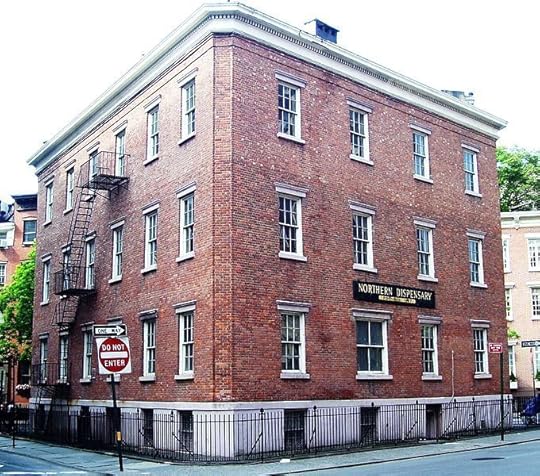 Beyond My Ken
Beyond My KenThe Northern Dispensary was built at the northern edge of the city in 1831 as the city’s second clinic for the poor and infirm and served as such for many years. Edgar Allen Poe, who lived nearby and squandered what little money he had on liquor, is said to have stopped in there with a head cold. As the city spread northward, the dispensary staff were kept busy, writing twenty thousand prescriptions in 1886. By the twentieth century, with the appearance of more hospitals, the number of patients diminished, and by the 1960s, when I first became aware of the Dispensary, it was functioning as a dental clinic only. In the 1960s, fearing infection, it refused service to an HIV patient, got sued, and was fined thousands of dollars. Struggling financially, in 1989 it finally shut down. It was then acquired by the Roman Catholic Archdiocese of New York, which sold it for $760,000 in 1998.
The new owner, William Gottlieb, had a fortune in New York City real estate but drove about in a beat-up old station wagon, sloppily dressed and often unshaven, and carried his papers about in a shopping bag. If you saw him on the street, you’d take him for a bum. It was his custom to buy buildings – small lots in the West Village, the Meatpacking District, and Chelsea – and sit on them for years. Sometimes he kept old buildings from being destroyed; sometimes he let them deteriorate. Under his ownership the Northern Dispensary deteriorated, its paint chipped, its windows broken. Gottlieb died in 1999, and today his nephew is trying to patch the building up; the roof is being repaired, the interior cleaned up. The nephew is also trying to decipher the complicated deed restrictions, which require that the building be used to serve the poor, and ban “any obscene performances on the premises or any obscene or pornographic purposes,” and also prohibit abortions. What will finally become of the building remains in doubt. Meanwhile it still sits there, a bit forlorn.
A West Village site that is anything but forlorn is Julius’s, a ground-floor bar in a plain, stucco-fronted building at the corner of West 10th Street and Waverly Place, with a long bar with a brass foot rail, and big windows facing on the street. When I first came to New York in the early 1950s, a friend described it as “Princeton on a weekend.” And when I stuck my nose in there, it did seem to be a collegiate hangout, mostly young men, but not a gay bar. Artists too hung out there, meeting to chat over a beer and burger.
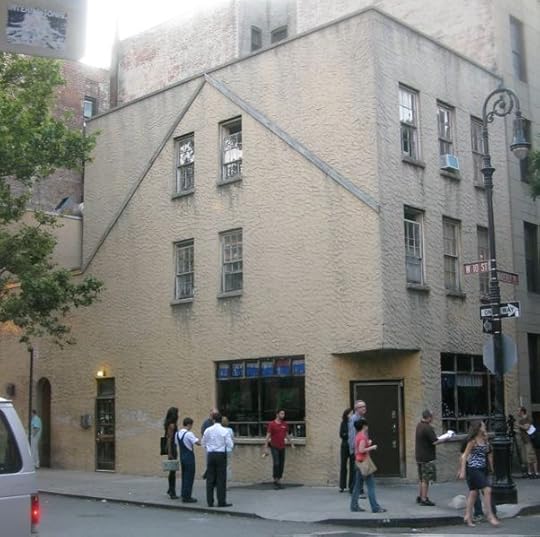 Julius's today. The third floor facing on Waverly was added in the late nineteenth century.Americasroof What distinguished Julius’s was its ceiling covered with many years’ accumulation of cobwebs and dust, the sawdust on the floor, and management’s determination not to let it become a gay bar, even though gay men were infiltrating it discreetly. Unlike the gay bars of the time, Julius’s wasn’t run by the mafia, and it wasn’t paying off the police. A gatekeeper monitored the percentage of men to women, and if he deemed the number of males too high, he would only admit men in the company of women. And inside there was a great effort to keep gay men from cruising each other, or at least cruising each other in a way that was obvious.
Julius's today. The third floor facing on Waverly was added in the late nineteenth century.Americasroof What distinguished Julius’s was its ceiling covered with many years’ accumulation of cobwebs and dust, the sawdust on the floor, and management’s determination not to let it become a gay bar, even though gay men were infiltrating it discreetly. Unlike the gay bars of the time, Julius’s wasn’t run by the mafia, and it wasn’t paying off the police. A gatekeeper monitored the percentage of men to women, and if he deemed the number of males too high, he would only admit men in the company of women. And inside there was a great effort to keep gay men from cruising each other, or at least cruising each other in a way that was obvious.But Julius’s, which today claims to be one of the oldest bars in Manhattan, has gone through many phases. Built in 1826 as a two-and-a-half-story Federal-style house, for years it housed a ground-floor grocery with the owner living on the floor above. Then in 1864 it became a bar and continued as such for many years until Prohibition was enacted in 1919. With its façade now stuccoed over, during the 1920s it was a speakeasy named Seven Doors, and with the repeal of Prohibition it took the name of Julius’s, though no one knows quite why. In the 1930s and 1940s it was patronized by horse-racing and prize-fighting fans, but also by jazz and literary people, a period commemorated in yellowing photos and framed newspaper clippings on the wall behind the bar. Also drifting into the place were gay men who lived in the neighborhood, but this was the “Princeton on a weekend” period and the bar resisted becoming a gay bar at first. But by the 1960s, adhering to the time-tested principle “If you can’t lick ’em, join ’em,” Julius’s became a full-fledged gay bar. In 1966 three Mattachine Society activists announced themselves as homosexuals and asked to be served. By prior arrangement with the management, they were denied service, so as to challenge the New York State Liquor Authority’s regulation prohibiting bars and restaurants from serving homosexuals, who were labeled “disorderly.” The Authority then denied authorizing such a prohibition, the city’s Human Rights Commission investigated, and the courts finally ruled that gay people had a right to peacefully assemble.
And today? The ceiling cobwebs and sawdust are long since gone, but Julius’s still functions as a gay bar, albeit a quiet, toned-down one. A friend of mine visited it recently and found three distinct groups imbibing there: older gay men who were cruising discreetly; older straight women, gay-friendly, whose presence inhibited the men just a bit; and, arriving later, a band of “hunky” twenty- and thirty-somethings, all good-looking, who seemed to be bar-hopping. Still a pleasant place, it would seem, and still a quiet neighborhood bar.
The Judson Memorial Church, on the south side of Washington Square Park, is another Village structure with a lot of history. It was the dream of Edward Judson, a Baptist minister living in the neighborhood, who got funding from fellow Baptist John D. Rockefeller, Sr., the ruthless oil tycoon turned philanthropist. Built in 1892 in the Romanesque Revival style and flanked by an Italian-style tower, the church is considered an architectural masterpiece from the firm of the renowned architect (and future murder victim) Stanford White, though to my eye it looms massively and oddly in a neighborhood where Greek Revival houses (of whom a few survive) once lined three sides of the park.
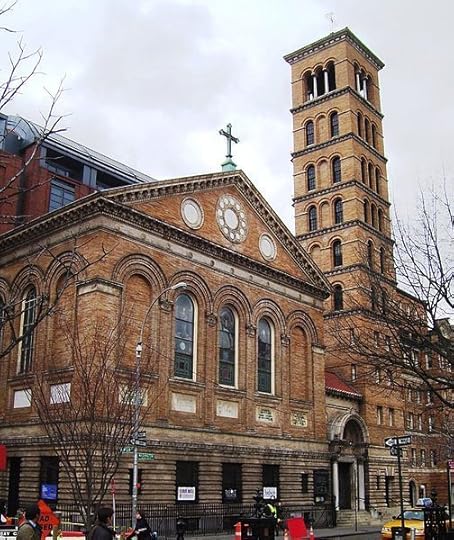 Beyond My Ken
Beyond My KenThe sober interior (Baptists embrace sobriety) was adorned with marble relief sculpture in the baptistery based on a design by Augustus Saint-Gaudens, and stained-glass windows by John La Farge in the sanctuary. The windows were added over the years as funds became available, and in contrast to the windows of the great Gothic cathedrals of France, which tell saintly stories, many of the Judson’s windows honor family members of the donors who made them possible. (Well, funding is always hard to get.)
Edward Judson, the founder and first minister, named the church for his long-deceased father, who had been a Baptist missionary in Burma. Eager to do community outreach in an area with a strange mix of residents – affluent WASPS on the lower reaches of Fifth Avenue, and Italian immigrants in tenements just south of the park – Judson and his parishioners sponsored cooking and sewing classes, a health facility, and employment services, and so began a tradition of social activism that continued well into the twentieth century. Though the congregation was shrinking, during the Great Depression of the 1930s the church at times let homeless men sleep in the pews. Services were still conventional in the 1950s, when my friend John and his friend April, a force of nature celebrated long ago in this blog, joined the choir of eight, he with an acceptable tenor voice, and April with a deplorable soprano. (Being a force of nature doesn’t guarantee good singing.) A small choir, a small congregation.
Then in 1957 Dr. Howard Moody became the senior minister with a determination to shake things up and get the church involved in local politics and culture. With the backing of the church board, he and his assistants gave up their clerical garb, removed crosses and pews from the church, and converted the sanctuary into a stage. Wild things followed, and I was a witness to some of them, if not necessarily in the church itself, at least with the church’s backing. For instance:
· In Circles, 1967, a plotless, shapeless musical with ten singers and a piano, based on an enigmatic 1920 text by Gertrude Stein (all of whose texts are enigmatic), a curious hodgepodge of words that the music -- a mix of ragtime, tango, waltz, love song, lullaby, barbershop quartet, spiritual, and what have you – made joyous, exuberant, and entertaining. Most memorable moment: the pianist, a little bald gnome of a man, kisses at length the most beautiful young woman in the cast – a beauty-and-the-beast moment that chilled me to the quick.
· Peace, 1969, a loose adaptation of Aristophanes’ play of the same name, which celebrated an imaginary peace between Athens and Sparta, ending the Peloponnesian War. This production came during the Vietnam War and the vehement movement trying to end it. Another hodgepodge, with Aristophanes turned into a minstrel show. Most memorable moment: Peace, Prosperity, and Abundance, long imprisoned by War, are liberated. Peace, a remarkably beautiful, slim young blond woman, slowly raises her arms to the audience in a gesture of welcome and radiantly smiling acceptance. Prosperity and Abundance do the same, Abundance being another attractive young woman, dark-haired, appropriately fleshy and abundant.
· The Journey of Snow White, 1971, a musical reinterpretation of the Snow White story where Snow White is sought out not by Prince Charming but by three suitors – an opera singer, a singing cowboy, and a rock star reminiscent of Elvis Presley – who fail to rescue her. In the end she is rescued by the Queen’s Mirror, who decides he wants to become human. Most memorable moment: when Snow White escapes into the forest and finds refuge among the woodland creatures (a cast of scores of volunteers), the seven dwarfs come marching in, led by a roly-poly girl who you immediately knew had to be a dwarf.
Who or what was behind these bold, wild, exciting, unsettling, sprawling, often irreverent, and hugely creative events? The answer is simple: Al Carmines, assistant minister of the Judson Memorial Church. Virginia-born and musical from an early age, and a graduate of the Union Theological Seminary in New York City, Carmines was hired by Howard Moody in 1961 to found a theater in the church’s sanctuary and put a little zip into the services and cultural outreach. A creative and eclectic composer and bisexual to boot, Carmines founded the Judson Poets’ Theater, a major force in the burgeoning Off Off Broadway movement, which challenged the conformity and commercialization of Broadway and Off Broadway. For inspiration he drew on Gertrude Stein, W.C. Fields, Aristophanes, the Bible, Winnie the Pooh, history, fairy tales, and gay life; his music was influenced by every form of pop music imaginable, with a bit of opera and operetta thrown in. And all of this on a minimal budget with unpaid volunteer performers.
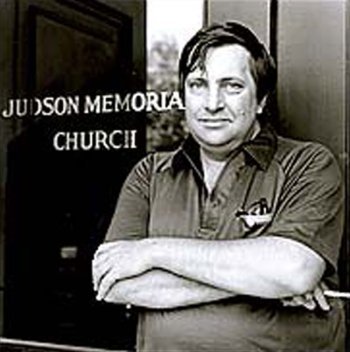 A tall, husky, full-faced man who liked gin and cigars, Carmines onstage was described by New York Times theater critic Clive Barnes as “crouched at his piano like a benevolent tiger, seeming cherubic enough yet with a face that sometimes looks like the darker side of the moon.” Carmines had a Puckish wit, no small dose of irreverence, and liked to shock. During his productions four-letter words and nudity invaded the church’s sanctuary, to the horror of a few and the delight of many. The Reverend Al could also act and sing, and somehow found time to conduct services, give sermons where God was rarely mentioned, and perform marriages as a man of the cloth. If photos show a rather fleshy man with a hint of self-indulgence, it hardly matters; he did wonders – innovative, often shocking wonders – with the full blessing of the church’s congregation. The average age of that congregation? Twenty-eight. Which explains a lot.
A tall, husky, full-faced man who liked gin and cigars, Carmines onstage was described by New York Times theater critic Clive Barnes as “crouched at his piano like a benevolent tiger, seeming cherubic enough yet with a face that sometimes looks like the darker side of the moon.” Carmines had a Puckish wit, no small dose of irreverence, and liked to shock. During his productions four-letter words and nudity invaded the church’s sanctuary, to the horror of a few and the delight of many. The Reverend Al could also act and sing, and somehow found time to conduct services, give sermons where God was rarely mentioned, and perform marriages as a man of the cloth. If photos show a rather fleshy man with a hint of self-indulgence, it hardly matters; he did wonders – innovative, often shocking wonders – with the full blessing of the church’s congregation. The average age of that congregation? Twenty-eight. Which explains a lot.In 1973 the Judson presented Carmines’s musical The Faggot, which consisted of vignettes of gay life and used the word “faggot” to describe anyone living outside society’s concept of “normal.” Carmines himself appeared as Oscar Wilde, though some felt his writing couldn’t match Wilde’s in wit. The musical got positive reviews, but the gay community criticized its focus on the loneliness and emptiness of gay life. It was Carmines’s last notable production.
I may have seen In Circles after it moved to the Cherry Lane Theater, but wherever it was, I was so taken with it that I went back to see it again – for me, an almost unheard-of venture. Worse still, it so inspired me that I began writing a dramatic hodgepodge of my own, a plotless mix of monologues, dialogues, poetic effusions, non sequiturs, one liners, and fractured French in which the six characters confronted one another in shifting alliances: male vs. female, older vs. younger, conservative vs. progressive. Happily, nothing ever came of it and the script has long since vanished. It was joyous enough but of its moment; it wouldn’t fly today. But In Circles won an Obie Award from the Village Voice, one of five that Carmines would receive. (The mainstream press in those days ignored the downtown Off Off Broadway scene, but the Voice reported it with enthusiasm.)
The radiantly beautiful young woman playing Peace was Arlene Rothstein, an actress, dancer, and choreographer who often appeared in Carmines’s productions. She may have been the young woman in In Circles who was kissed by the pianist. Only in researching this post did I learn that she died later at age 37 of meningitis, a sad ending to a promising career.
Mortality stalked the Reverend Al as well. In 1977 his creative career was interrupted by a cerebral aneurysm that required a lengthy operation followed by months of therapy, and he never quite recovered the musical flair and inventiveness that had characterized his career up till then. Crippling headaches forced him to resign from his post at Judson in 1981, until they were cured by a second surgery in 1985. In his later years he turned more toward religion, and a Bible study group that he held in his apartment evolved over time into the Rauschenbusch Memorial United Church of Christ at 422 West 57th Street, with him as pastor. The opening night for the congregation involved hymn, Bible readings, and a soft-shoe routine. Carmines died in Saint Vincent’s Hospital in 2005 at age 69.
Another memorable event of those years was Dames at Sea, or Golddiggers Afloat, a light and frothy musical revue that opened at the Caffe Cino on Cornelia Street in 1966, a takeoff on the lavish Busby Berkeley musical films of the 1930s, but doing it on a tiny stage with a cast of six. Memorable moment: Mona, the self-centered star of a Broadway musical in rehearsal, starts singing “That Mister Man of Mine,” a song that is new to her; after a note or two she cavalierly tosses the music away and continues. Another memorable moment: Mona performs with a chorus behind her, the chorus consisting of a single showgirl. Later in the revue, even though the cast, having been expelled from their theater, are rehearsing on a ship in dry dock, Mona gets seasick, so that Ruby, an aspiring young singer from Utah, steps in and becomes a star. The whole production was a spoof of Hollywood done in miniature, charming from beginning to end. I saw it twice, and the second time around it had lost nothing of its charm. But when, being successful, it moved to a larger stage, I doubt if it retained that charm; it needed to be done small-scale. Yet it endured and in 2014 made its way to Broadway.
The founder and guiding spirit of the Caffe Cino was Joe Cino, who with friends founded it in 1958. Born in Buffalo to a family of working-class Sicilian immigrants, he had discovered he was gay and at the age of sixteen escaped to New York, where his hopes to be a dancer were defeated by his short, plump frame. Renting a storefront at 31 Cornelia Street, where the Italian landlady rented to him because he was Sicilian, he put in some mismatched tables and chairs, a big coffee machine on a counter in back, and served pastries and snacks.
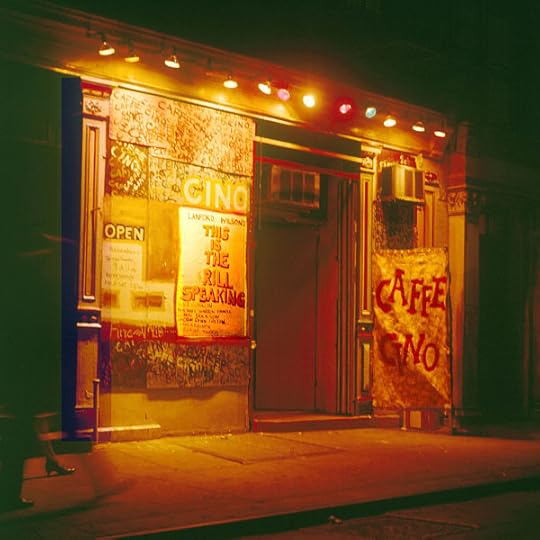 The Caffe Cino in 1965.
The Caffe Cino in 1965.Joe Cino first meant his cafe to be a place where his friends could hang out, but soon there were poetry readings, then readings of plays, and then amateurish staged productions. When young unknowns brought in their works, the Caffe Cino began performing them on a tiny improvised stage and so turned into an Off Off Broadway theater playing to a minimal audience – sometimes as few as ten or even one -- that slowly grew over time. The sets were simple, and for power John Torrey, Cino’s electrician lover, ran cables out to a streetlamp and stole power from the city grid. There was no admission fee; Cino passed the hat. With no cabaret or theater license, and an audience that on some nights filled the place beyond capacity, the Cino was repeatedly inspected by the police and building and fire inspectors but was never shut down, perhaps because Joe Cino knew which palms to grace with money.
The quality of the plays performed at the Cino ranged from deplorable to weirdly brilliant, but theatrical history was made with the 1964 production of Lanford Wilson’s The Madness of Lady Bright, a monologue by an aging drag queen who gradually descends into madness. Rarely, if ever, had any New York theater presented such an openly gay character, but Off Off Broadway was ready for it, and audiences flocked. My partner Bob, then in his twenties, saw it and was mightily impressed, and through a mutual friend met the actor, Neil Flanagan, who won an Obie for his performance.
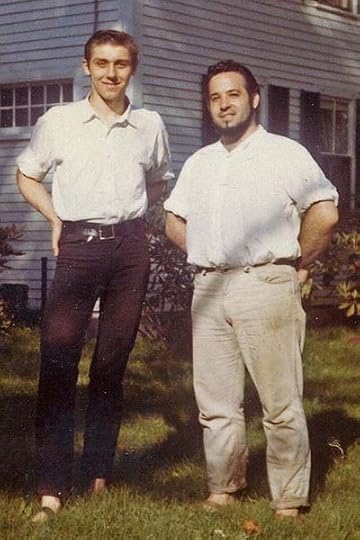 John Torrey (left) and Joe Cino in 1962. In March 1965 a fire gutted the Caffe Cino, reportedly because of leaking gas, though Joe’s friends thought it was started by John Torrey in a jealous rage. With help from benefits staged by the Village theater world, the Cino reopened in May, but its world of regulars was repeatedly shocked and saddened as friends and acquaintances succumbed to heavy drugs, which one survivor later described as “the dark underbelly of Off-Off-Broadway theater.” One, a dancer hooked on amphetamines, danced a nude dance in a friend’s apartment and then leaped gracefully out a window to his death. And when, in January 1967, John Torrey was electrocuted, supposedly by accident, many suspected suicide. By then Joe himself was on amphetamines and at news of Torrey’s death fell into deep depression. On March 30 of that year friends found him on the floor of the Cino, bleeding from self-inflicted knife wounds; he died in Saint Vincent’s Hospital on April 2. A year later the Caffe Cino closed.
John Torrey (left) and Joe Cino in 1962. In March 1965 a fire gutted the Caffe Cino, reportedly because of leaking gas, though Joe’s friends thought it was started by John Torrey in a jealous rage. With help from benefits staged by the Village theater world, the Cino reopened in May, but its world of regulars was repeatedly shocked and saddened as friends and acquaintances succumbed to heavy drugs, which one survivor later described as “the dark underbelly of Off-Off-Broadway theater.” One, a dancer hooked on amphetamines, danced a nude dance in a friend’s apartment and then leaped gracefully out a window to his death. And when, in January 1967, John Torrey was electrocuted, supposedly by accident, many suspected suicide. By then Joe himself was on amphetamines and at news of Torrey’s death fell into deep depression. On March 30 of that year friends found him on the floor of the Cino, bleeding from self-inflicted knife wounds; he died in Saint Vincent’s Hospital on April 2. A year later the Caffe Cino closed.Did I ever see a performance at the Caffe Cino? I have a dim memory of a play by an unknown author performed on an improvised stage in the middle of a small theater or cafe; probably it was the Caffe Cino. And since I don't recall buying a ticket, Joe Cino probably passed the hat. The play wasn't bad and at one point the leading character asked the audience what he should do, at which point a young girl sitting near the stage declared, "You don't have to do anything you don't want to!" -- a response, quite in keeping with the times, that drew applause.
Joe Cino’s sad ending is a reminder that the wild creativity of the 1960s came at a price. Many of the participants were heavy into liquor and drugs and failed to sustain themselves as artists. Inspiration raged, along with a willingness to try anything, but in the long run art needs discipline too, and discipline was the last thing that early Off Off Broadway embraced. The writers and producers were amateurs, and it showed. For every theatrical gem that Off Off Broadway produced, there were a hundred botches and flops. The few samples I saw of Ellen Stewart’s La MaMa – another pioneering Off Off Broadway theater – struck me as amateurish, unfocused, inept. As for pioneering works in gay theater, neither The Madness of Lady Bright nor The Faggot presented gay life in a positive light; to be gay was to be vulnerable, wounded, and sad.
Nor was this image altered when Mart Crowley’s play The Boys in the Bandopened uptown in an Off Broadway theater in 1968 and was similarly hailed as a breakthrough for promoting knowledge and tolerance of gay life. Perhaps it did, but as the story unfolds, the characters become bitter and vicious, and capable as well of self-loathing, as seen in the play’s most memorable line: “You show me a happy homosexual, and I’ll show you a gay corpse.” I and my friends were glad to see gay life at last treated openly uptown, but we had mixed feelings about how the play presented it. There was little in Crowley's play to advance the cause of gay pride, which exploded onto the scene with the Stonewall riots of 1969.
The wild theatrical happenings of those days, many of them in the West Village, are today a treasured memory for the survivors. But not all the participants survived.
Coming soon: My Walks in New York: arcades, diamond districts, Norman Vincent Peale and Minnie Mouse, and the new Whitney.
© 2015 Clifford Browder
Published on May 10, 2015 04:34



